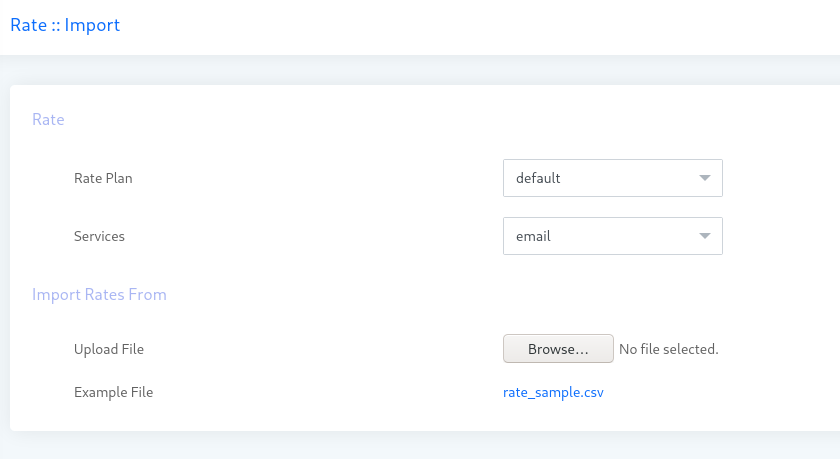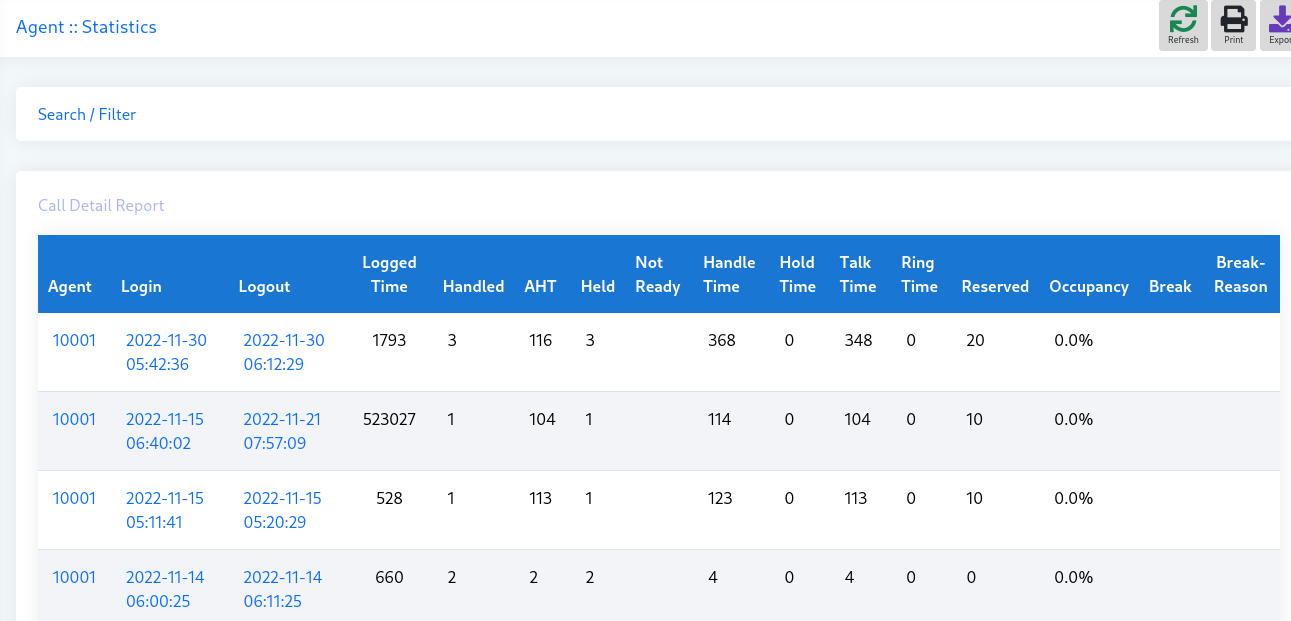Administration Guide:
Version : 5.4
Last Updated : 19/01/2023
ICTBroadcast is a product of ictinnovations
1. Overview:
ICTBroadcast is white label, multilevel and multi-tenant unified communications contact center software supporting Voice, SMS; Fax and Email communications technologies suitable for SMB and Service Providers. ICTBroadcast has smart autodialer and smart predictive dialer capabilities. It enables service providers to offer call center and broadcasting services to their users.
It can be scaled to blast thousands of simultaneous calls using either VoIP or PSTN. ICTBroadcast can handle most telemarketing and call center scenarios. It is simple, reliable and easy to use and has a user-friendly web portal to manage.
How to prepare ICTBroadcast:

2. Roles
ICTBroadcast support following roles: Admin, Client, User and Agent.
i) Admin:
Admin is the owner of ictbroadcast setup. Admin manage and monitor overall ictbroadcast setup and resources. Admin create tenant/client and allocate resources to him. Admin create and manage over all system resources such as extensions/DID’s. Admin setup billing, set rate plan, rates and configure trunk, routes.

ii) Tenants/client :
tenant/client manage users, supervisor and agent accounts. Tenant creates and manages multiple users, supervisor and agent accounts. tenant/client assign resources to each users such as extension and DIDs.
iii) User :
User create new campaigns. User manage and monitor campaigns and all his resources and his data.
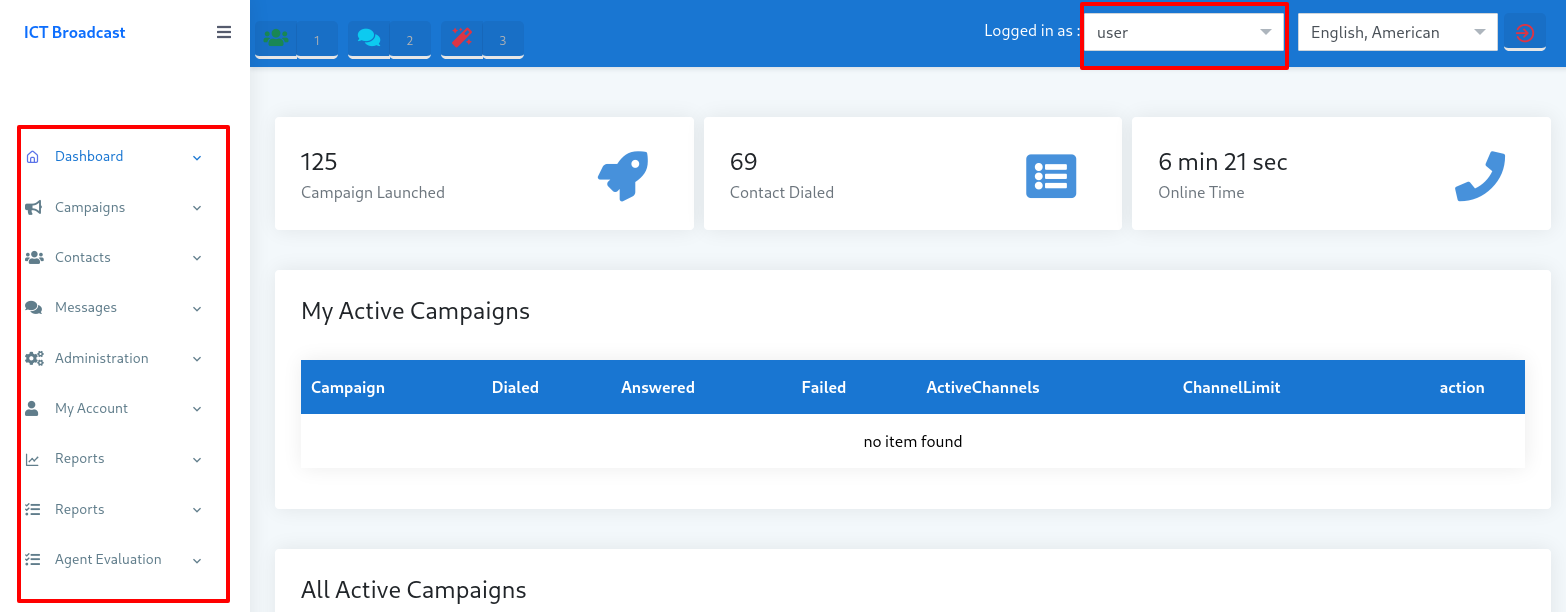
iv) Agent :
Agent make/receive/transfer call and communicate with callers /call recipients. Agent manages inbound and outbound campaigns such as predictive, progressive and preview campaigns.
v) Supervisor :
Supervisor monitor campaigns and reports of one or multiple users and agents of same tenant.
3. Modes
ICTBroadcast support following three modes of operation with all voice-based campaigns of ICTBroadcast as listed below:
i) Outbound Mode:
Outbound mode is the default modes of all ICTBroadcast campaigns. ICTBroadcast unified auto dialer performs outbound calling as its default mode and originates calls toward remote destinations and performs required operation and actions on said calls. For example, in survey campaigns, an outbound mode will generate call and when call gets answered, pre-recorded voice-based questions will be played. Call recipient will be asked to respond through DTMF or voice recordings. Later, these responses will be reported back to admin as a summary.
ii) Inbound Mode:
With inbound mode enabled, all campaign can receive incoming calls on published DID numbers and this campaign will respond with IVR or with prescribed action, as an example, we can conduct an inbound survey campaign where caller will call on published DID numbers and on answer, IVR may play voice message asking user to enter proper extension number to connect him with related professional or take prescribed act.
iii) Permanent Mode:
Permanent mode requires REST APIs. With this mode, campaigns always remain in listening mode. It accepts contact numbers from external applications using Rest API in real time and adds contact into contact list of campaigns and contact create in real time and necessary actions performed on it. ICTBroadcast Rest API are used to automate business process and we can integrate any third-party applications with ICTBroadcast using these API.
4) Setup of ICTBroadcast
To configure ICTBroadcast, follow the steps given below:
i) Login as Admin:
ICTBroadcast allow admins to login as type the user’s name and password and click on “log in” button. As the admin is logged in, a successful message appears “Logged in successfully”.
ii) Add new User:
ICTBroadcast allow to add new users by going to the “Administration” in menu bar, then click on “User Management” button, then click on “Add New” button. A form will appear to type the detail given in the form as “User Name”, “Active Status”, “User Role”, “Password”, and “Personal Contact Information”.
Click on “Save” button to save New User.
iii) Add new Client:
ICTBroadcast allow to add new Client by going to the “Administration” in menu bar, then click on “Client Management”, then click on “Add New” button. A form appears, type the detail as “Client Name “, “Active Status”, “Personal Contact Information” and “Local Settings”.
Click on “Save” button to save New Client.
iv) Add new Extension:
Extensions are added to transfer calls.ICTBroadcast allow to add new Extension by going to the “Administration” in menu bar, then click on “Agent/Extension”, then click on “Add New Extension” button. A form appears, type the detail as “Agent Name “, “Agent number”, “Forward to”, “Web Phone” and “Password”.
Click on “Save” button to save New Extension.
v) Add DID:
ICTBroadcast allow to add new DID by going to the “Administration” from the menu bar, then click on “Inbound DIDs”, then click on “Add New DID” button. A form appears to type the detail as “DID Number”, “DID Applications”.
Click on “Save” button to save New DID.
vi) Add Trunk:
A trunk is an interface that enables users to connect with interested recipients using VOIP or PSTN networks. ICTBroadcast allow to add a new Trunk by going to the “Administration” in menu bar, then click on “Gateways”, then click on “Add New Trunk” button. A form appears, type the detail as “Trunk”, “Technical Information”, “Outbound Configurations”, “Caller ID”, “Trunk Configurations”.
Click on “Save” button to save New Trunk.
vii) Add Balance:
ICTBroadcast allow to add Balance by going to the “Billing” in menu bar, then click on “Payments”, then click on “Add Payment” button. A form appears, type the detail as “Paid by”, “Payments”.
Click on “Save” button to save New Balance.
5. Dashboard:
Dashboard is a system monitoring page and it shows important live statistics of overall system described below:

i) System Status:
It will show total Logged-In users, total active Campaigns and total active channels that are using ICTBroadcast.
ii) My Campaigns:
My Campaigns shows the number of active campaigns that how much will be dialed, answered or failed and also show a total number of active channels.
iii) Server Status:
Server Status shows real time status of MySQL, Apache and Asterisk status.
iv) All Active Campaigns:
It will show the list of all active campaigns.
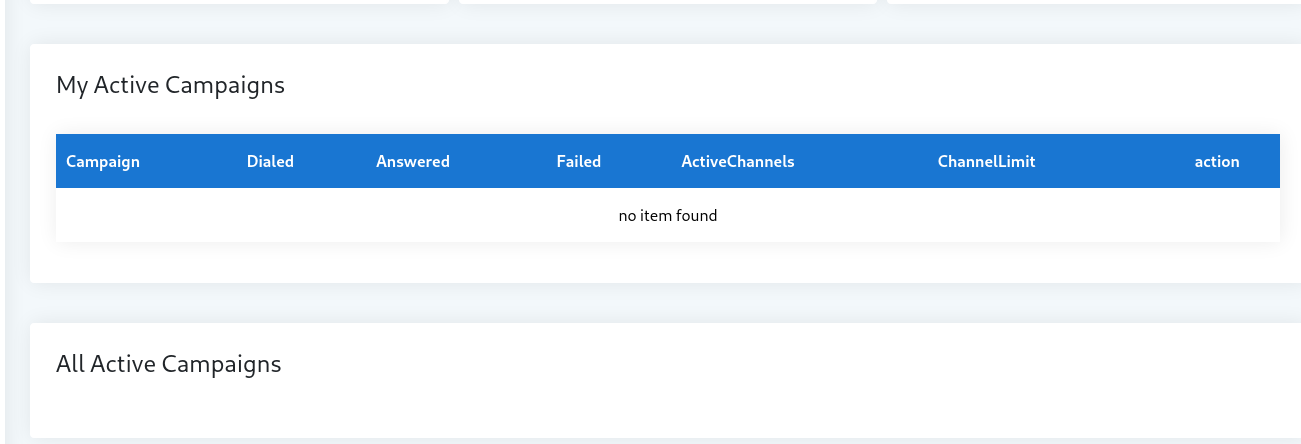
v) Node Statistics:
It shows the statistics of nodes, which includes active channels, usage percentage of CPU, memory and hard disk.
vi) Logged-In Users:
It shows the list of all logged-in users, active channel and channels limit.
6. Campaigns:
User can click on “Campaigns” tab from the main menu bar to access this functionality. It has three Sub Menu. That is Campaign Management, Inbound Campaigns/DID and Campaign default Setting. These three are described below.
i) Campaign Management:
When User click on Campaign Management menu, it will open a page as shown below. Here user have various options for campaign management.
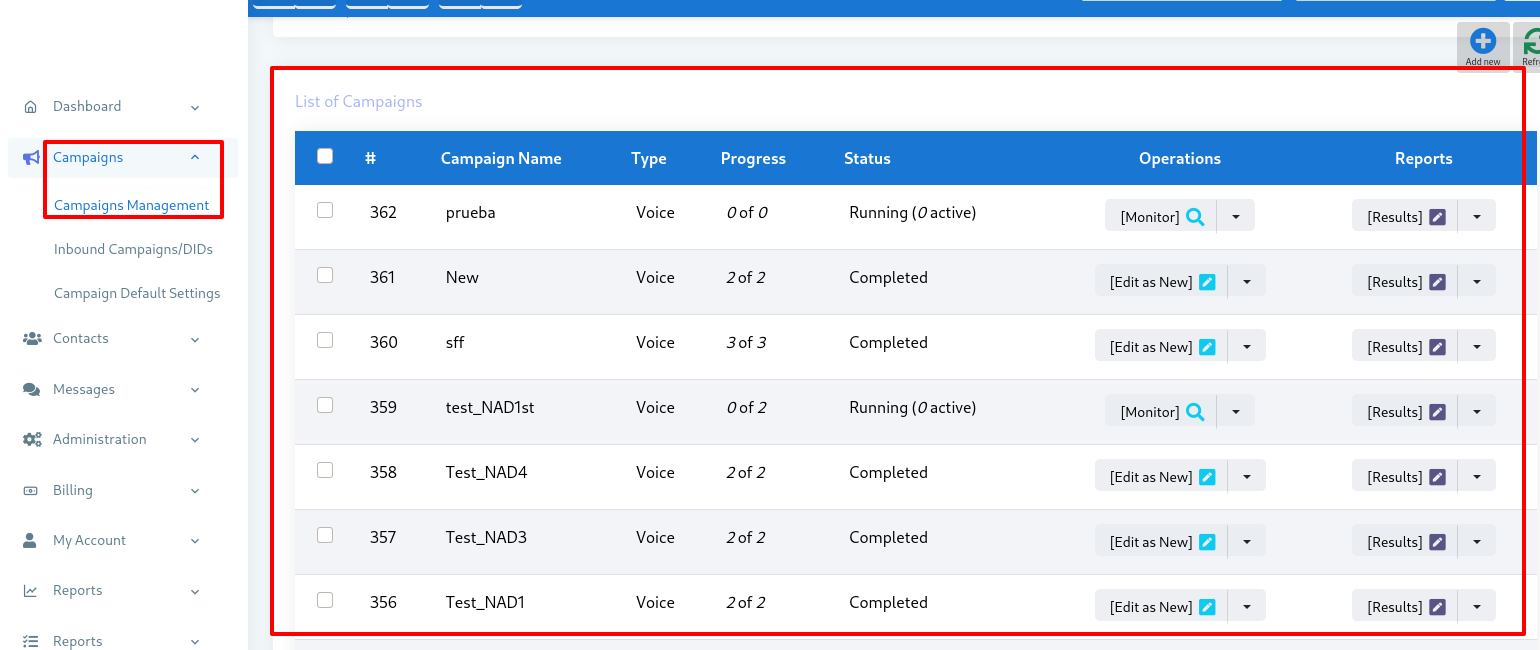
Add new:
User can create a new campaign (see section “Add new campaign” below)
Operations:
Modify/Edit existing campaign parameters before it starts, Start and Stop Campaigns manually, Monitor Live calls of Campaign.
Results:
Call statistics of completed calls with data that called contact entered.
Deletes selected campaigns by the delete button.
ii) Inbound Campaigns/ DIDs:
For creating inbound campaigns/ DIDs:
Go to Administration from the main menu, select “Inbound DIDs” from sub menu, which has two buttons “Add DID” and Add DID in Batch” which is highlighted.
Firstly, add DID number in Inbound DIDs as shown in the below figure:
New DID:
Write a DID number in the field box.
Write a description about it.
Click on save button for adding new DID.
Create DID in Batch:
Write DID range in which you want to set out from where to where in the field box.
Write some description about it.
Click on the save button to save it.
iii) Campaign Default Setting:
Go to Campaigns from the main menu, select campaign default settings from the sub-menu.
It shows the interface as shown in the below figure. All the default setting of campaigns are reset from here:
iiii) Retry with follow me:
In ICTbroadcast admin/user can select the number of retries for call the contact during campaign creation. If main contact number is busy or invalid the we can retry on its
secondary or tertiary numbers.

i)Basic Campaign Configurations:
In basic configuration, you can set key press timeout and DNC (Do not Call), message reply key and maximum message reply by default.
With the help of drop-down list, you can enable or disable block cell phone, auto message reply and global DNC group.
ii)Defaults parameters for campaigns:
You can set campaign default caller ID, campaign default caller ID name, channels per campaigns and maximum retries, maximum call duration, maximum ring time and call duration by default.
By a drop-down list you can set default dialing order.
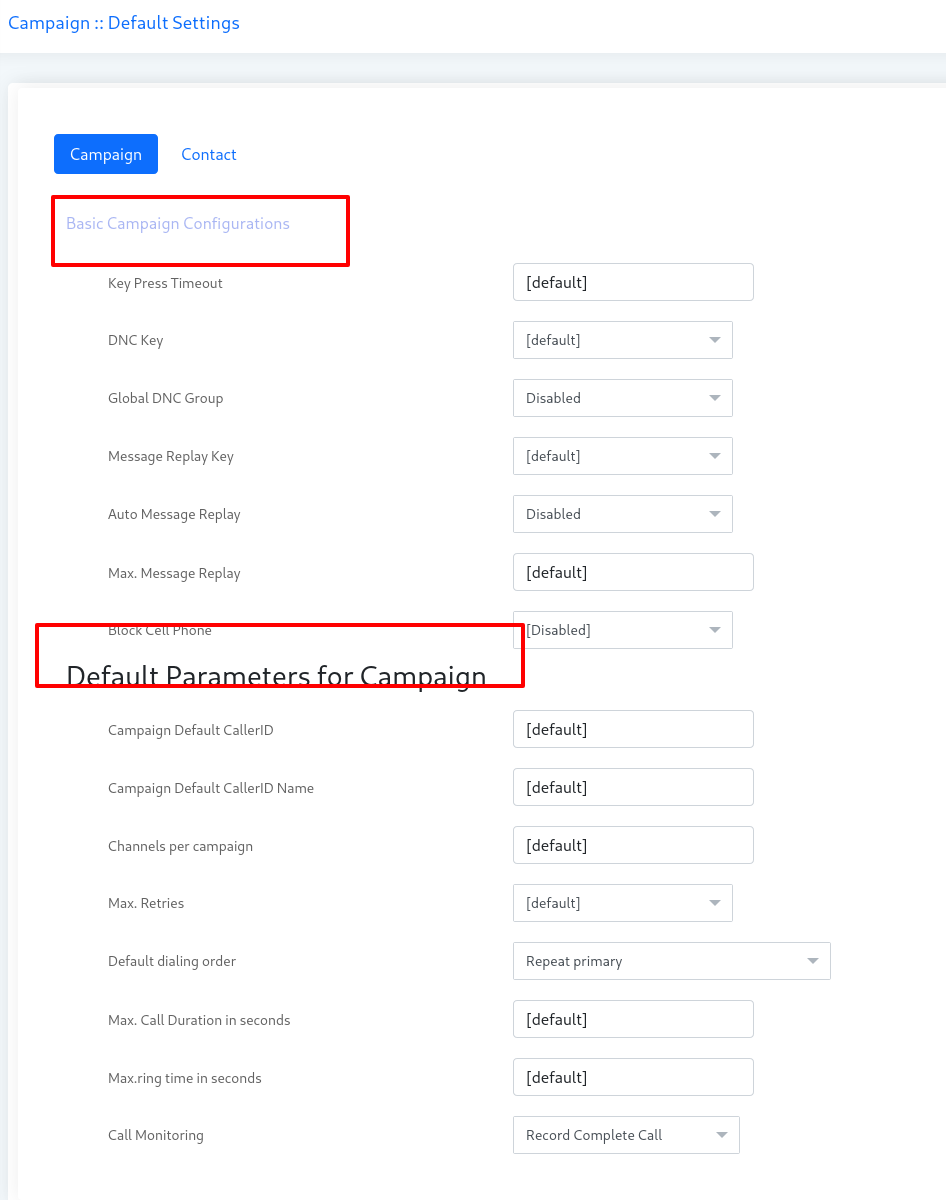
Add New campaign:
- Click on “Campaign” tab.
- Click on “Campaign Management” tab.
- Click on “Add New”.
- Select the type of campaign (Voice, Fax and SMS)
A detailed overview of each of the campaigns shown in the below figure.
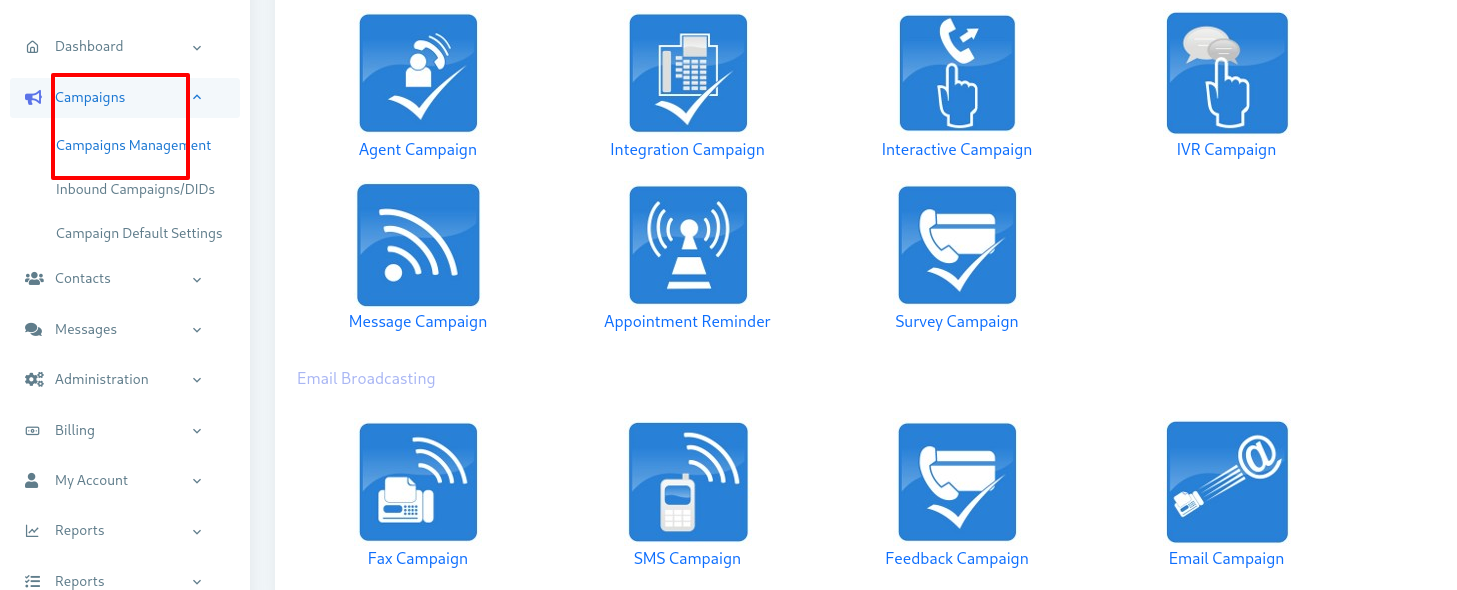
This detail will highlight the purpose of the campaign, how to create it, and its important fields that should be filled.
i) Agent Campaign
This type of campaign dial numbers from contact list and on an answer by the recipient, directly forward call to agent/external call center/IVR system. When the user selects this campaign, it will open a form that lists all the options and settings for creating this campaign.

Steps to create an Agent Campaign:
Navigate To Campaign => Campaign Management => Add New=> Agent Campaign.
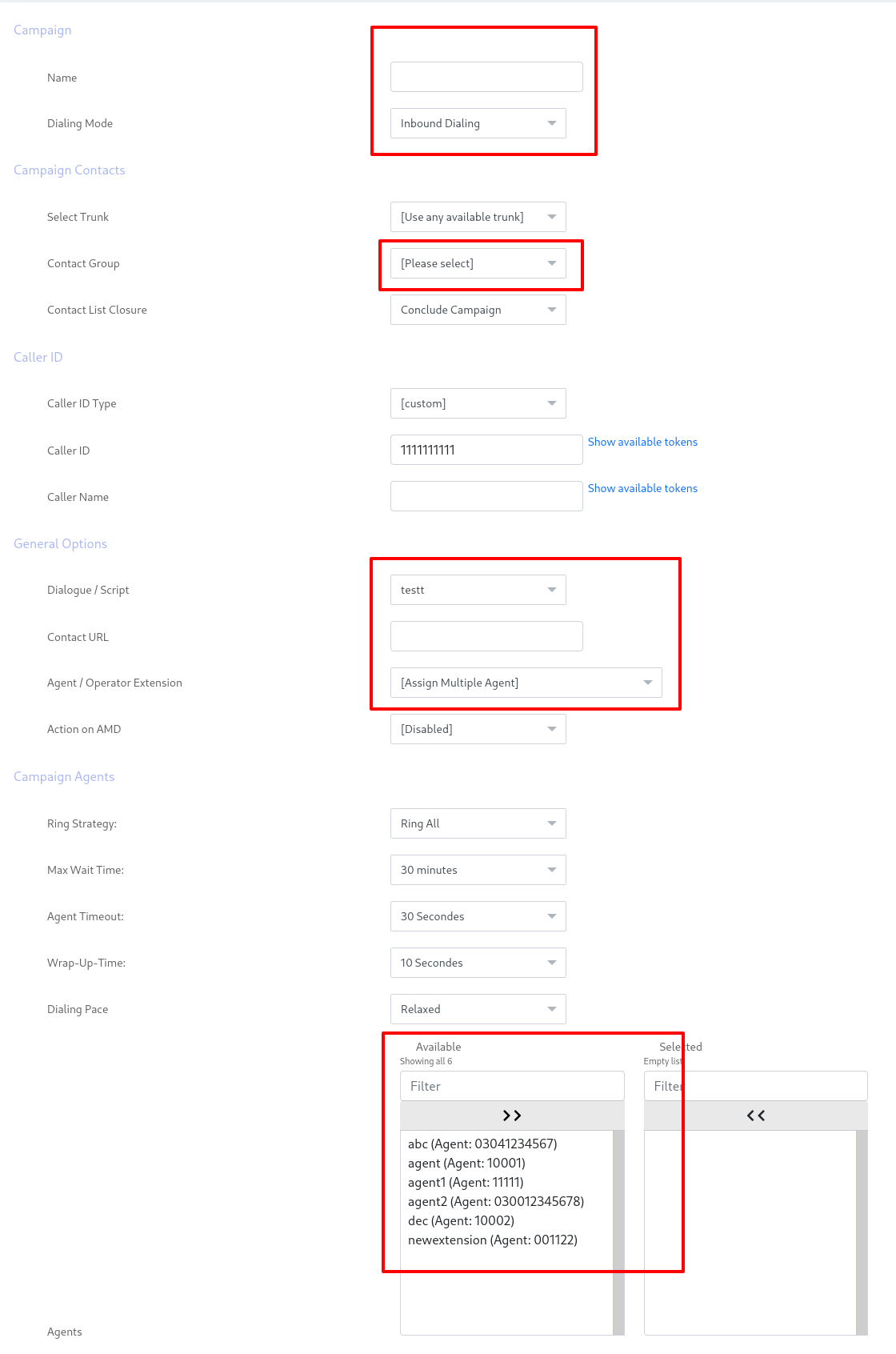
- Fill the campaign form with required fields like:
a) Campaign Name
b) Campaign contacts
c) Agent / Operator Extension
- Click Save to start the campaign.
Glossary
Campaign:
Name: Name of the campaign for identification
Campaign Mode:
When selected to Normal, it stops the campaign after processing all the contacts.
When selected to Permanent, it allows the campaign to keep running even after processing all the contacts and waiting for new contact in background.
Campaign Contact:
Contact group:
Select contact group/List of phone numbers that this campaign will dial.
Caller ID:
Caller ID Type: Enter Caller ID type to use with outgoing calls.
Caller ID: Enter Caller ID to use with outgoing calls.
Caller Name: Enter caller’s name to use with outgoing calls
General Options:
Dialogue/Scripts: Choose the Dialogue/Scripts.
Contact URL: Enter the contact URL.
Agent / Operator Extension: This field shows an extension on which calls will be placed. The extension may be forwarded to agents or external call center or any IVR system for further handling of call.
AMD (Answering Machine Detection) Action:
When it is disabled, it ignores the Answering Machine. When hang up is selected, it detects AMD if found, then hang up the call otherwise continue normally. Third option is to leave a message. It detects AMD if found, then play a different message and hang up. It has another field of Message recorded for the answering machine.
Settings:
Max. Concurrent Channels: Maximum number of concurrent channels that the campaign will support.
Max retries: Max number of retries to contact the said contact.
Max call Duration: Maximum allowed duration for each call. After this duration, the call will be disconnected automatically, if user is not sure about duration of the call let it be maximum number so that it does not affect call conversation.
Campaign Schedule:
**Start campaign: **Schedule campaign start it has following options:
a) Immediately: Start campaign immediately just after creation
b) On Scheduled Time: Start campaign on selected data and time
Stop/Pause campaign: Schedule campaign stop time it has following options
a) When Done: Stop the campaign when everything is completed.
b) On Scheduled Time: Stop campaign on selected date and time.
3rd Party Integration:
Request Call End: Select the call to be ended.
Click on “Save” button on top to start the campaign.
ii) Integration Campaign:
This campaign allows to create integration. This campaign dials the number from contact list, on answer by the recipient, asks a set of questions by playing voice messages and then records their responses (DTMF key or Voice Response) from recipient and prepares a report for further analysis. An integration campaign, admin can create choice-based questions that require call recipient to respond using the key press DTMF function, as well as open-ended questions that require the call recipient to record their message. These recorded voice responses (or feedback) are shown in a list of voice responses in the campaign summary integration report. When the user selects this campaign, it will open a form that lists all the options and settings for creating this campaign.
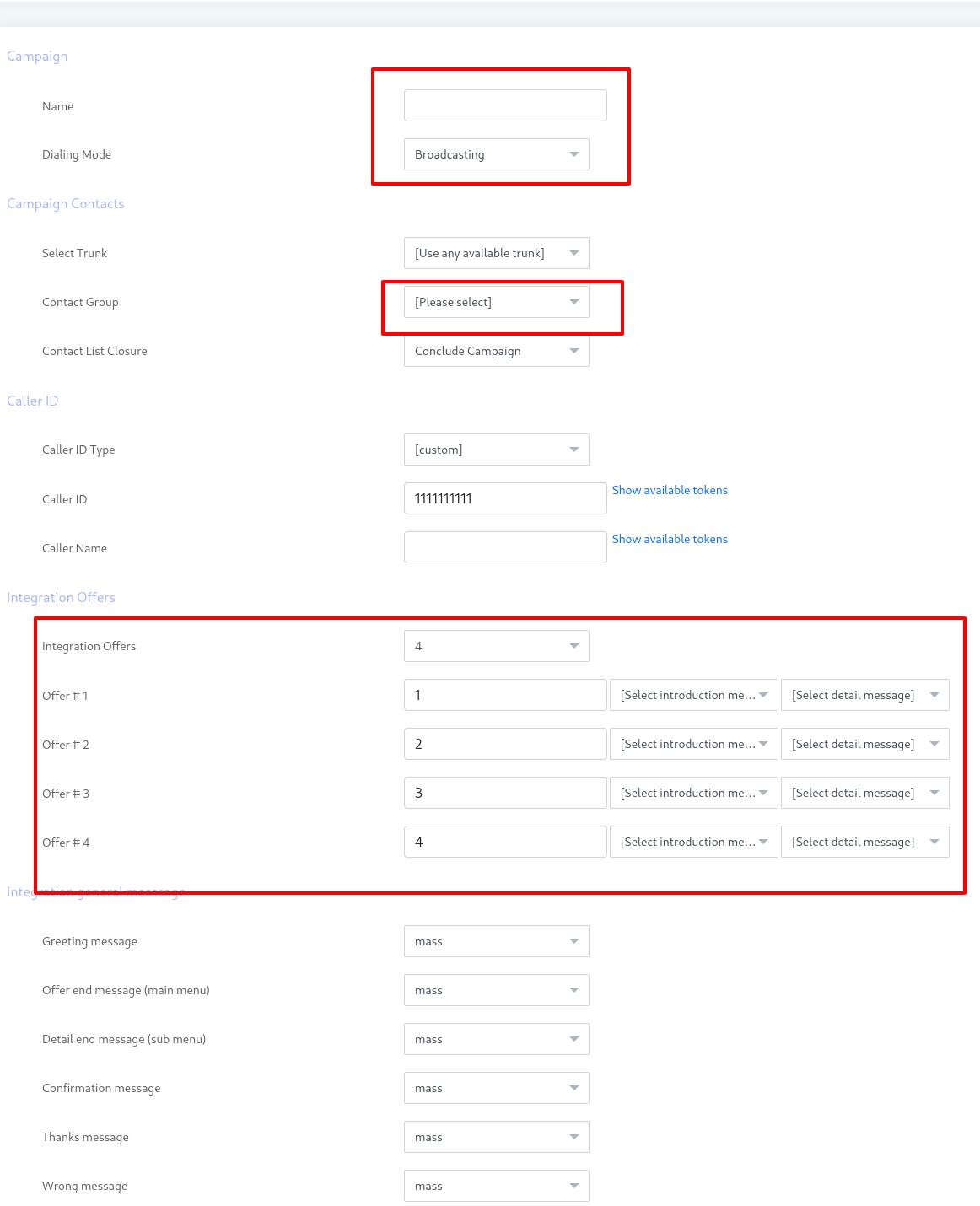
Steps to create Integration Campaign:
- Navigate to Campaign => Campaign Management => Integration Campaign.
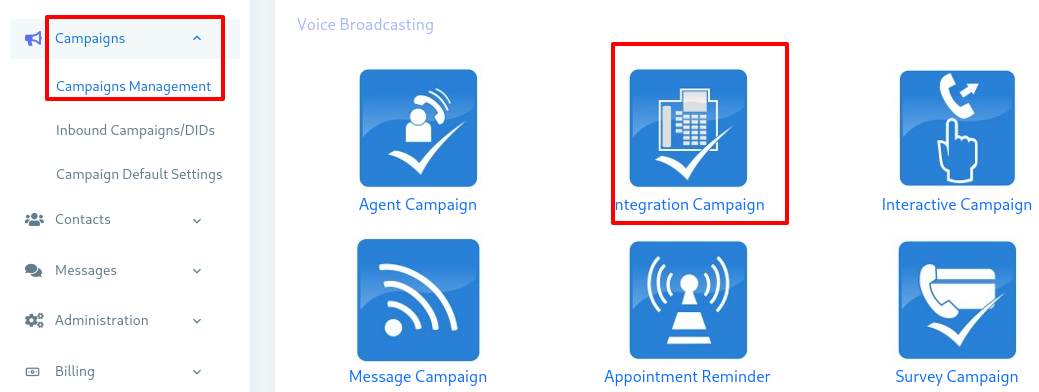
- Fill the campaign form:
a) Set Campaign Name
b) Set Campaign Contacts
c) Set Caller ID
3. To create integration questions:
a) Select required number of questions under the integration section.
b) For each question, select related question recording and click on [Answer Type] dropdown. This will allow the user to choose between DTMF Response (choice-based closed-ended question) or Voice Response (open-ended question). Choosing DTMF Response will show a link option. Clicking on this link will open a popup window to set answers to this question (next step). If the user chooses voice response, it will show a dropdown to choose the time in seconds to allow to the recipient to record his response. No further action is required for this question type.
- If the user chooses DTMF Response, then this step is required to complete the question.
To create Answers of Integration Questions:
a) Set Question title that will be useful for viewing reports of survey campaign.
b) There are Maximum of 7 possible answers for a question. “key” is the DTMF key pressed for the answer choice. Action are the default answers for corresponding key like yes, no, not sure.
c) To set a custom answer, click [Custom] from the action dropdown. Similarly, to unset a key, click [not is use] from actions given against that key.
In the below figure, answer settings for one of the questions is shown.
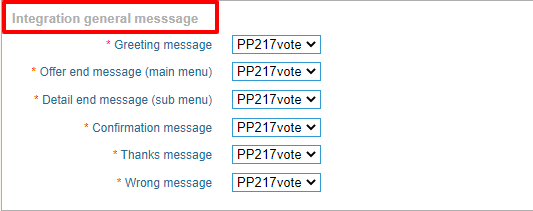
- Once questions and their answers are set, Click Save to start the integration campaign.
- To view question-wise graphical report for integration campaign, navigate to Campaigns => Campaign Summary => select campaign
Glossary
Campaign Name: Name of the campaign for identification.
Campaign Mode:
When selected to Normal, it stops the campaign after processing all the contacts. When selected to Permanent, it allows the campaign to keep running even after processing all the contacts and waiting for new contact in background.
Campaign Contacts:
Contact group: Select contact group/List of phone numbers that this campaign will dial.
Caller ID:
Caller ID Type: Enter Caller ID type to use with outgoing calls.
Caller ID: Enter Caller ID to use with outgoing calls
Caller Name: Enter caller’s name to use with outgoing calls.
Integration Offers:
This field allows user to select number of questions in integration. At the moment, a maximum 10 questions are supported. Once the user selected the number of questions, a question field is displayed that allows the user to select a recorded question and then configure desired responses.
Integration general message:
This field allows user to select Greeting Message, Offer end message, Detail end message, Confirmation message, Thanks Message and Wrong Message. Each message is selected according to demand. Integration APIs:
This field allow user to select APIs.
Settings:
Max. Concurrent Channels: Maximum number of concurrent channels that the integration campaign will support.
Max retries: Max number of retries to contact the said contact.
Max call Duration: Maximum allowed duration for each call. After this duration call will be disconnected automatically, if user is not sure about duration of call, let it be maximum number so that it does not affect call conversation.
Campaign Schedule:
**Start campaign: **
Schedule campaign start it has following options:
a) Immediately: Start campaign immediately just after creation
b) On Scheduled Time: Start campaign on selected date and time
Stop/Pause campaign: Schedule campaign stop time it has following options
a) When Done: Stop campaign when everything is completed
b) On Scheduled Time: Stop campaign on selected date and time
3rd Party Integration:
Request Call End: Select the call to be ended.
Click on “Save” button on top to start the campaign.
iii) Interactive Campaign:
This option enable user to create an interactive campaign. This type of campaign dials number from contact list, on answer by the recipient, play recorded message and if recipient presses desired key, it forwards recipient to a live agent for further call handling.
When the user selects this type of campaign, it will open a form that lists all the options and settings for creating this campaign.
Pre requisites for creating an Interactive Campaign:
To create an interactive campaign, admin should make sure the following steps are performed as pre-requisite:
- Create an “Extension” and assign this extension to a user.
- Add balance in user account so that he/she is able to make/receive calls. Now that user should set transfer configurations for the assigned extension.
- Extension transfer setting by user can be set to the following three options:
a. Registered Agent
b. External Call Center
c. External Number
- Finally, the user will create an interactive campaign from the campaigns menu as shown below.
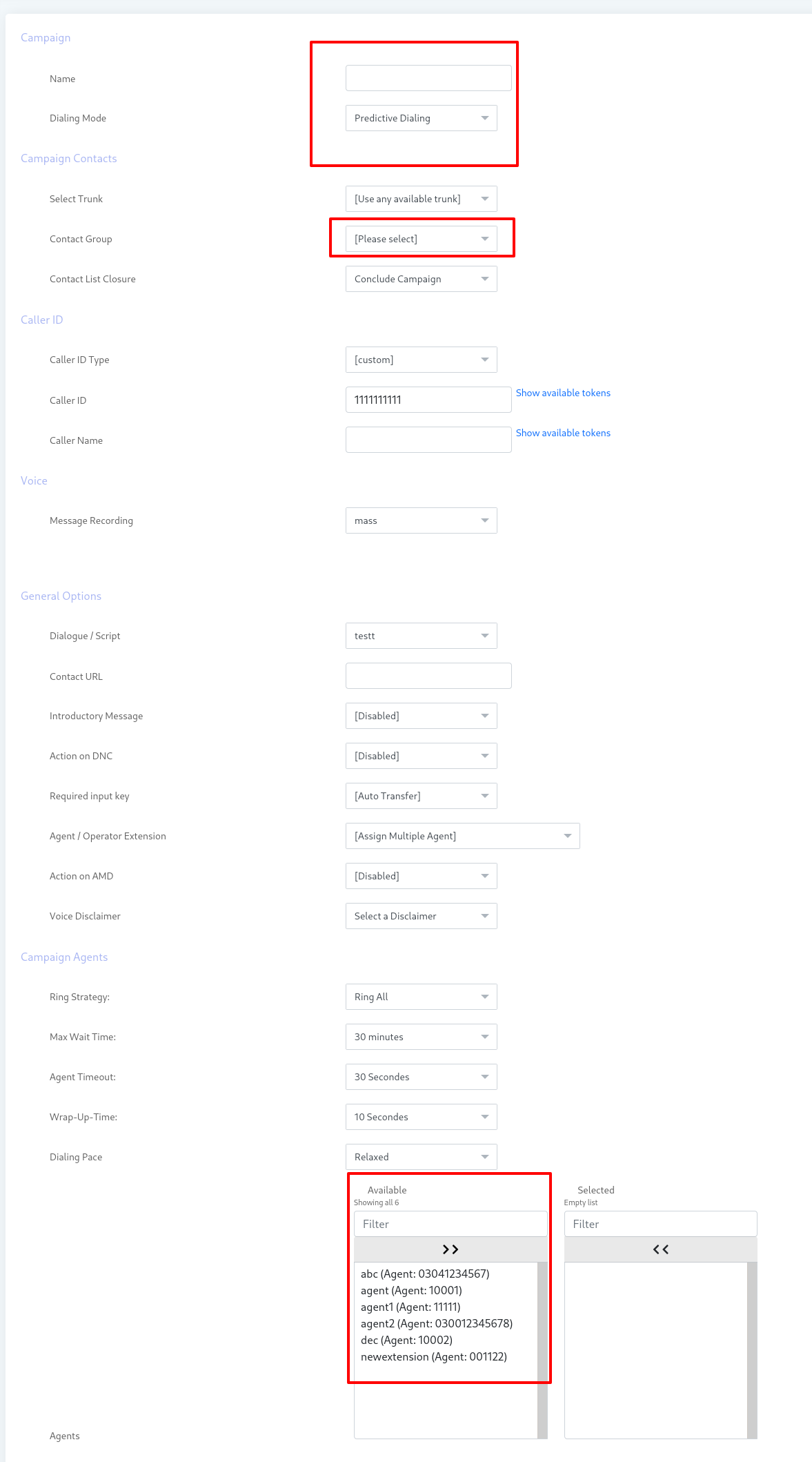
I) DNC:
Working with DNC.
- Navigate to Campaign => Campaign Management => Add New=> select any Campaign.
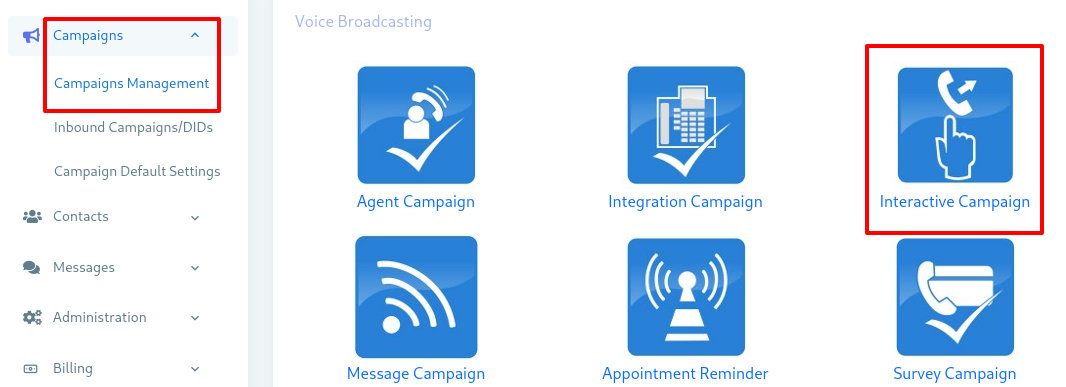
Select Action on DNC.
When enabled, on key press 9, recipient number will be deleted from the contact list.
When it is disabled, nothing will happen.
Steps to create an Interactive Campaign:
Navigate to Campaign => Campaign Management => click on “Add new” campaign button.
- Select the Campaign => Interactive Campaign
- Fill the details as:
a) Campaign Name
b) Campaign contacts group
c) Caller ID
d) Voice
e) General Option
f) Settings
g) Campaign Schedule
h) 3rd Party Integration
- Click Save to start the campaign.
Glossary
The general parameters that need to fill out for this of campaign are following:
Campaign Name:
Name of the campaign for identification.
Campaign Mode:
When selected to Normal, it stops the campaign after processing all the contacts. When selected to Permanent, it allows the campaign to keep running even after processing all the contacts and waiting for new contact in background.
Campaign Contacts:
Contact group: Select contact group/List of phone numbers that this campaign will dial.
Caller ID:
Caller ID Type: Enter Caller ID type to use with outgoing calls.
Caller ID: Enter Caller ID to use with outgoing calls.
Caller Name: Enter caller’s name to use with outgoing calls.
Voice Message: Select from list of already created / recorded messages.
General Options:
Dialogue/Scripts: Choose the Dialogue/Scripts.
Contact URL: Enter the contact URL.
Introductory Message:
When enabled, this field allows the campaign manager to select an introductory message. This introductory message will be played immediately when the recipient receives a call.
DNC (Do Not Call) Action:
DNC could be enabled and disabled. When disabled, no action is taken. When enabled, it will set a key “9” for DNC action. This means that when the recipient presses 9 on his phone, his number will be deleted from contact list.
Required Input Key:
This defines on which key the system should transfer call to Agent/Extensions.
Agent/Operator Extensions:
This field shows an extension on which calls will be placed. The extension may be forwarded to agents or external call center or any IVR system for further handling of call.
AMD (Answering Machine Detection) Action:
When it is disabled, it ignores the Answering Machine. When hang up is selected, it detects AMD. If found, then hang up the call otherwise, continue normally. Third option is to leave a message. It detects AMD if found, then play a different message and hang up. It has another field for Message recorded for an answering machine.
Settings:
Max. Concurrent Channels: Maximum number of concurrent channels that interactive campaign will support.
Max retries: Max number of retries to contact the said contact.
Max call Duration: Maximum allowed duration for each call. After this duration, the call will be disconnected automatically, if user is not sure about the duration of call, then select the maximum number so that it does not affect call conversation.
Campaign Schedule:
**Start campaign: **
Campaigns Schedule has the following options:
a) Immediately: Start a campaign immediately just after creation.
b) On Scheduled Time: Start campaign on selected data and time.
Stop/Pause campaign: Schedule campaign stop time it has following options:
a) When Done: Stop the campaign when everything is completed.
b) On Scheduled Time: Stop campaign on selected date and time.
3rd Party Integration:
Request Call End: Select the call to be ended.
Click on “Save” button on top to start the campaign.
iv) IVR Campaign:
This is an advanced type of campaign. The purpose of this campaign is to broadcast message in the form of IVR (Interactive Voice Response). Interactive voice response (IVR) is a technology that allows a computer to interact with humans through the use of voice and keypad inputs. This type of campaign dials the number from contact list, on answer by the recipient, plays IVR message and on the basis of responses from the recipient, it performs some operation or plays some other message. When the user selects this campaign, it will open a form that lists all the options and settings for creating this campaign.
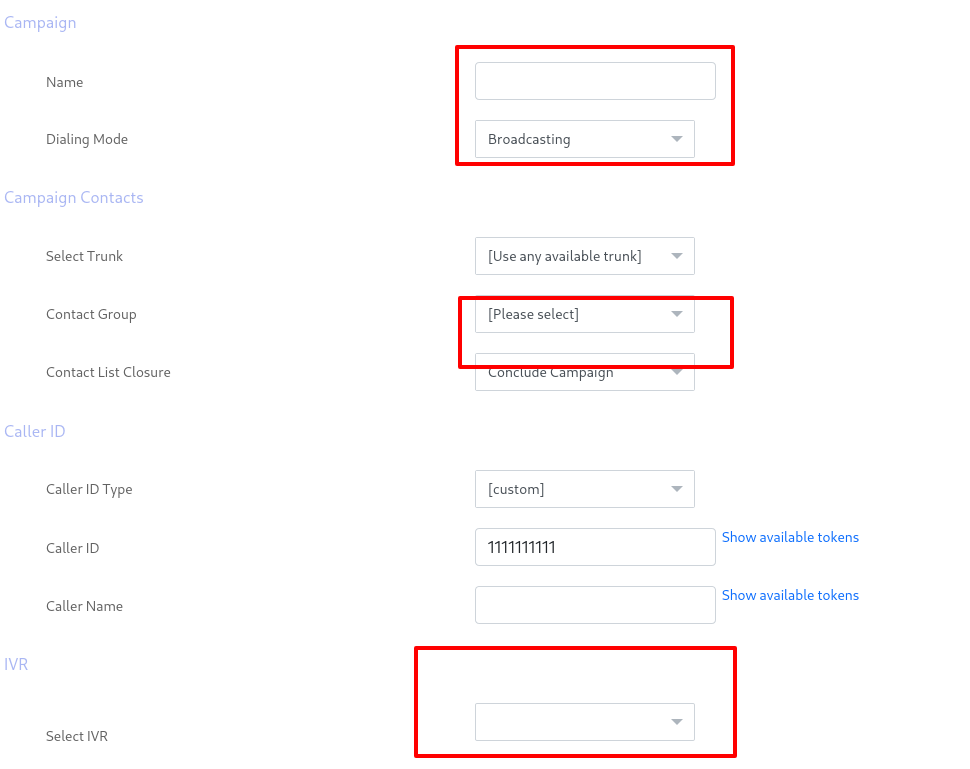
Steps to create an IVR Campaign:
- Navigate to Messages => IVR => New IVR to create a new IVR. How to create IVR?
- Navigate to campaign => campaign Management => Add New => IVR Campaign.

- Fill the campaign form with required fields like:
a) Campaign Name
b) Contact Group
c) IVR
Glossary
Campaign Name: Name of the campaign for identification
Campaign Mode: When selected to Normal, it stops the campaign after processing all the contacts.
When selected to Permanent, it allows the campaign to keep running even after processing all the contacts and waiting for new contact in background.
Campaign Contacts:
Contact group: Select contact group/List of phone numbers that this campaign will dial.
Caller ID:
Caller ID Type: Enter Caller ID type to use with outgoing calls.
Caller ID: Enter Caller ID to use with outgoing calls.
Caller Name: Enter caller’s name to use with outgoing calls.
IVR: Select from a list of already created IVRs.
Settings:
Max. Concurrent Channels: Maximum number of concurrent channels that IVR Campaign will support.
Max retries: Max number of retries to contact the said contact.
Max call Duration: Maximum allowed duration for each call after this duration call will be disconnected automatically, if user is not sure about duration of call, then select maximum number so that it does not affect call conversation.
Campaign Schedule:
**Start campaign: **
Start campaign Schedule has the following options:
a) Immediately: Start campaign immediately just after creation
b) On Scheduled Time: Start campaign on selected data and time.
Stop/Pause campaign: Schedule campaign stop time it has following options.
a) When Done: Stop campaign when everything is completed
b) On Scheduled Time: Stop campaign on selected date and time
3rd Party Integration:
Request Call End: Select the call to be ended.
Click on “Save” button on top to start the campaign.
v) Message Campaign:
The purpose of this campaign is to broadcast a voice message. This type of campaigns dials numbers from contact list, on answer by the recipient, plays recorded voice message and hangs up. If the user selects “Message Campaign” from the figure above. This will open a form, lists all the options and settings for creating this campaign.
The general parameters that user need to fill out for any type of campaign are:
Campaign Name:
Name of the campaign for identification.
Campaign Mode:
When selected to Normal, it stops the campaign after processing all the contacts. When selected to Permanent, it allows the campaign to keep running even after processing all the contacts and waiting for new contact in background.
Campaign Contact:
Contact group:
Select contact group/List of phone numbers that this campaign will dial.
Caller ID: Write the caller ID in the field box.
Caller ID Type: Enter Caller ID type to use with outgoing calls.
Caller ID : Enter Caller ID to use with outgoing calls.
Caller Name : Enter caller’s name to use with outgoing calls.
Voice Message : Select from list of already created / recorded messages.
General Options:
Introductory Message:
When enabled, this field allows the campaign manager to select an introductory message. This introductory message will be played immediately when the recipient receives a call.
DNC (Do Not Call) Action:
DNC could be enabled and disabled. When disabled, no action is taken. When enabled, it will set a key “9” for DNC action. This means that when the recipient presses 9 on his phone, his number will be deleted from contact list.
AMD (Answering Machine Detection) Action:
When it is disabled, it ignores the Answering Machine. When hang up is selected, it detects AMD if found, then hang up the call otherwise continue normally. Third option is to leave a message. It detects AMD if found, then play a different message and hang up. It has another field for Message recorded for an answering machine.
Settings:
Max. Concurrent Channels: Maximum number of concurrent channels that message campaign will support.
Max retries: Max number of retries to contact the said contact.
Max call Duration: Maximum allowed duration for each call. Afterward call will be disconnected automatically, if user is not sure about the duration of the call, then select maximum number so that it does not affect call conversation.
Campaign Schedule:
**Start campaign: **
Start Campaign Schedule has the following options:
a) Immediately: Start campaign immediately just after creation
b) On Scheduled Time: Start campaign on selected data and time
Stop/Pause campaign: Schedule campaign stop time it has following options
a) When Done: Stop campaign when everything is completed
b) On Scheduled Time: Stop campaign on selected date and time.
3rd Party Integration:
Request Call End: Select the call to be ended.
Click on “Save” button on top to start the campaign.
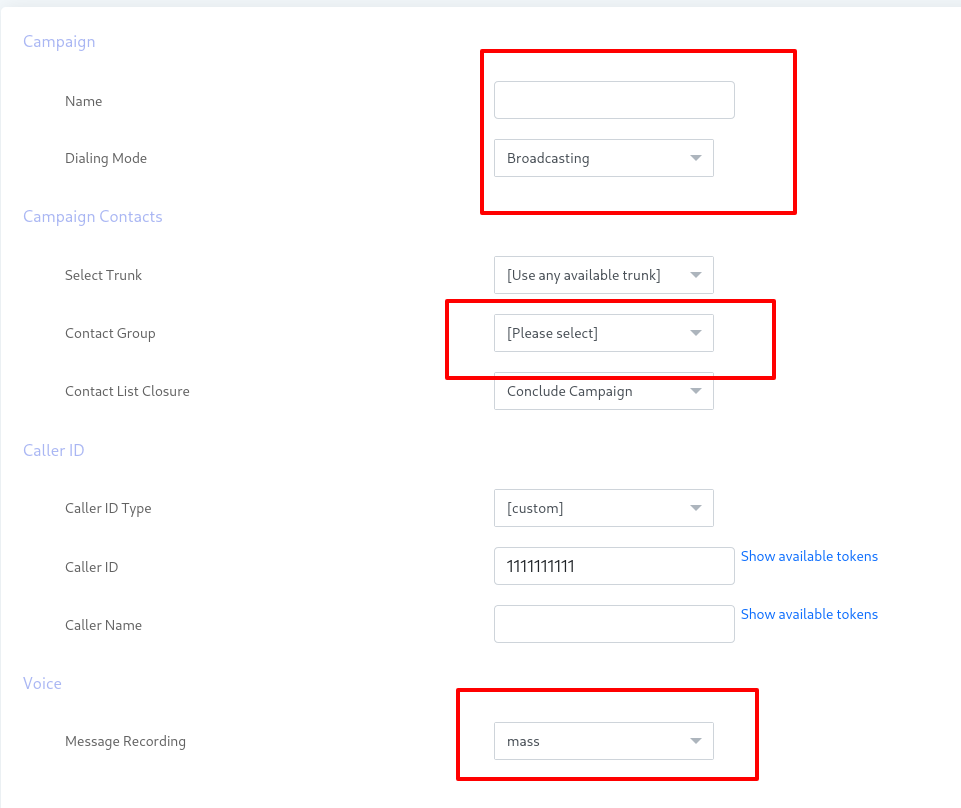
- Fill the form as required fields:
I) AMD:
Working with AMD.
- Navigate to Campaign => Campaign Management => Add New=> select any Campaign.
- Fill the form as required fields:
Select Action on AMD.
- When option hang up is selected, call will be hanged up. When the machine is detected. When leave a message to be selected, then selected recording message will be played on detection of the answering machine.

- Click Save to start the campaign.
vi) Appointment Reminder Campaign:
This campaign places a reminder of calls to all the contacts in a group. This campaign requires that every contact should have scheduled appointment start time and appointment end time in any of the custom fields in contact form. All calls will be placed before appointment start time. Campaign administrator will set ‘reminder call time’ in the campaign creation form that will specify how many hours before the appointment starts the call will be placed. There is also a ‘reminder expiry time’ field in the campaign creation form that makes sure no calls should be placed after the expiry time. When admin/user selects this campaign, it will open a form that lists all the options and settings for creating this campaign.
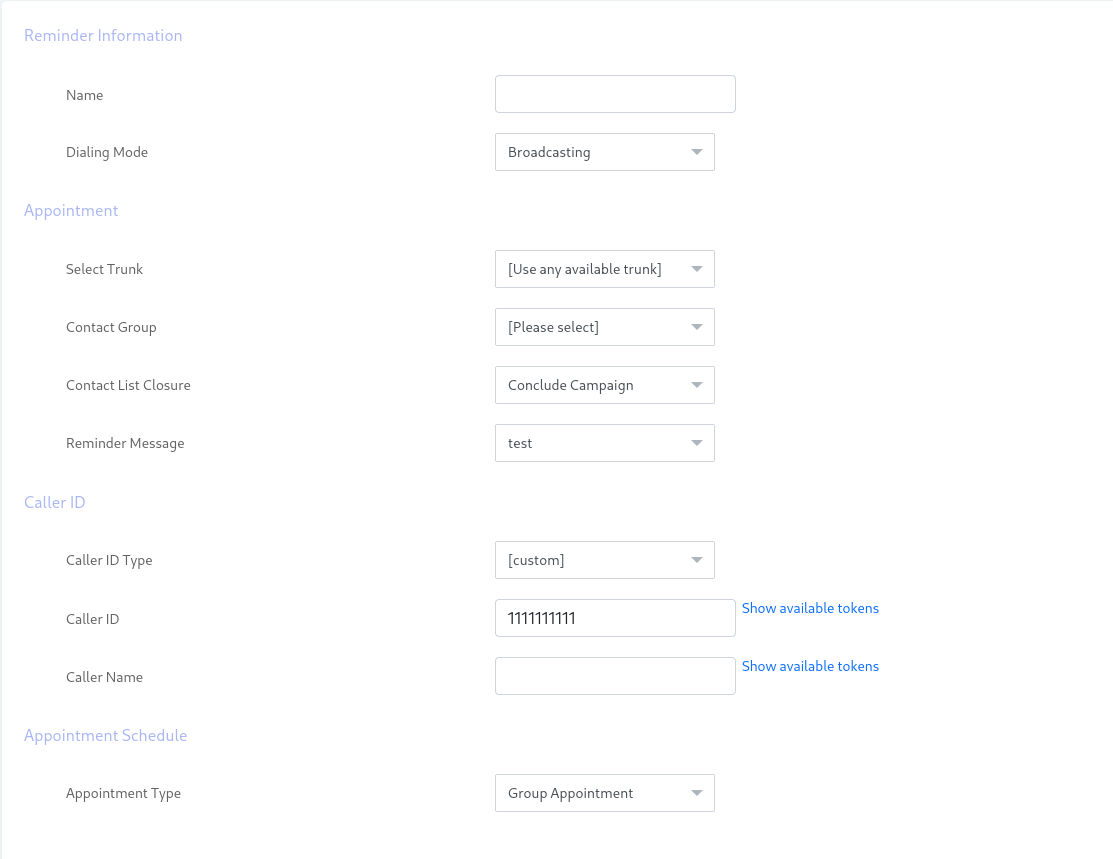
Steps to create Appointment Reminder Campaign:
- Navigate to Campaign => Campaign Management => Add new Appointment Reminder.
add appointment remiander campaign
- Fill the campaign form with required fields like:
a) Campaign Name
b) Contact Group
c) Reminder Message
Appointment Type:
Appointment type can be either individual or group. In ‘Individual Reminder’, every contact that is dialed may have different appointment schedule time. Examples of individual appointments are doctor’s appointment or lawyer’s appointment, where each patient/client has different timings for the meeting. Administrator of the campaign will select where the appointments are stored for each contact by selecting the appropriate value in Appointment Start Field. Then admin will select how many hours before the appointment time a reminder call should be placed. Reminder expiry field will ensure that no call should be placed after the expiry time. Campaign schedule will also apply on the calls to ensure legal time calling.
Group Reminder:
In group reminder, a group of people will be dialed according to the campaign schedule time. Examples of group appointments are training attendees or class/school students where all the members of training or class students have time for a training session/class. Administrator of the campaign will himself manage how many days/hours before the appointment campaign should be run. In group appointments, campaign scheduling time will apply for dialing contacts.
Reminder information:
Name: Select the name of the contacts to whom looked-for sending reminder message.
Appointment:
Contact Group: Select contact group/List of phone numbers that this campaign will dial.
Reminder Message: Select from list of already created IVR Messages.
Caller ID:
Caller ID: Enter Caller ID to use with outgoing calls.
Caller Name: Enter caller name to use with outgoing calls Appointment Schedule:
Appointment Type: Select the type as “Group Appointment” or the “Individual Appointment”.
General Options:
DNC Action:
DNC could be enabled and disabled. When disabled, no action is taken. When enabled, it will set a key “9” for DNC action. This means that when the recipient presses 9 on his phone, his number will be deleted from contact list.
AMD (Answering Machine Detection) Action:
When it is disabled, it ignores the Answering Machine. When hang up is selected, it detects AMD if found, then hang up the call otherwise continue normally. Third option is to leave a message. It detects AMD if found, then play a different message and hang up. It has another field for Message recorded for an answering machine.
Settings:
Max. Concurrent Channels: Maximum number of concurrent channels that the appointment remainder campaign will support.
Max retries: Max number of retries to contact the said contact.
Max call Duration: Maximum allowed duration for each call. after this duration call will be disconnected automatically, if user is not sure about duration of call, let it be maximum number so that it does not affect call conversation.
Campaign Schedule:
**Start campaign: **
Schedule campaign start it has following options:
a) Immediately: Start a campaign immediately just after creation.
b) On Scheduled Time: Start campaign on selected data and time.
Stop/Pause campaign: Schedule campaign stop time it has following options:
a) When Done: Stop the campaign when everything is completed.
b) On Scheduled Time: Stop campaign on selected date and time.
3rd Party Integration:
Request Call End: Select the call to be ended.
Click on “Save” button on top to start the campaign.
vii) Survey Campaign:
This campaign allows to create surveys and polls. This campaign dials the number from contact list, on answer by the recipient, asks a set of questions by playing voice messages and then records their responses (DTMF key or Voice response) from recipient and prepares the report for further analysis. In a survey campaign, user can create choice-based questions that require the call recipient to respond using the key press DTMF function, as well as open-ended questions that require the call recipient to record their message. These recorded voice responses (or feedback) are shown in a list of voice responses in the campaign summary survey report. When the user selects this campaign, it will open a form that lists all the options and settings for creating this campaign.
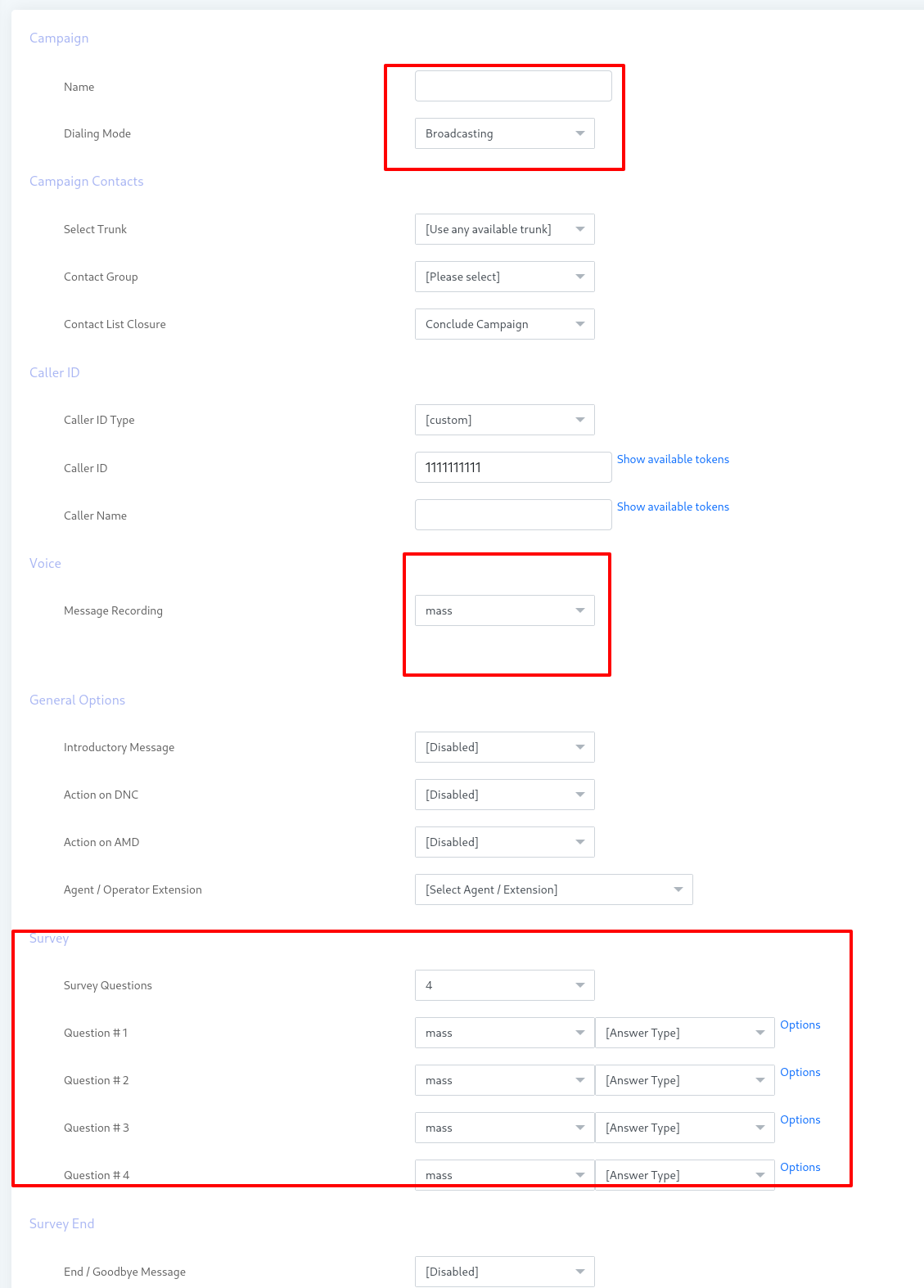
Steps to create Survey Campaign:
- Navigate to Campaign => Campaign Management => Survey Campaign.

2. Fill the campaign form
a) Set Campaign Name
b) Set contact group
c) Set your recorded message that will be played immediately after the call is received.
It could be a message to the recipient that the survey is coming next.
3**. To create survey questions:**
a) Select required number of questions under the survey section.
b) For each question, select related question recording and click on [Answer Type] drop down. This will allow the user to choose between DMTF Response (choice-based closed-ended question) or Voice Response (open-ended question). Choosing DTMF Response will show a link option. Clicking on this link will open a popup window to set answers to this question (next step). If the user chooses voice response, it will show a drop down to choose the time in seconds to allow to the recipient to record his response. No further action is required for this question type.
- If the user chooses DTMF Response, then this step is required to complete the question.
To create Answers of survey Questions:
a) Set Question title that will be useful for viewing reports of survey campaign.
b) There are Maximum of 7 possible answers for a question. “key” is the DTMF key pressed for the answer choice. Action are the default answers for corresponding key like yes, no, not sure.
c) To set a custom answer, click [Custom] from the action dropdown. Similarly, to unset a key, click [not is use] from actions given against that key. In the picture below, answer settings for one of the questions is shown.
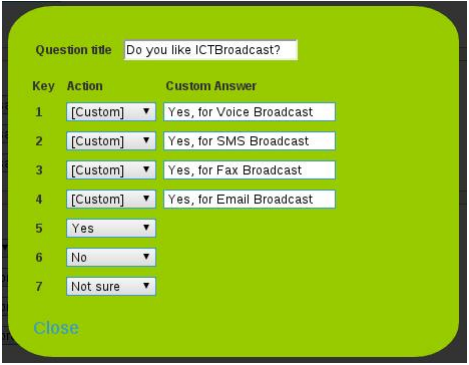
- Once questions and their answers are set, Click Save to start survey campaign.
Glossary
Campaign Name:
Name of the campaign for identification.
Campaign Mode:
When selected to Normal, it stops the campaign after processing all the contacts. When selected to Permanent, it allows the campaign to keep running even after processing all the contacts and waiting for new contact in background.
Campaign Contacts:
Contact group: Select contact group/List of phone numbers that this campaign will dial.
Caller ID:
Caller ID Type: Enter Caller ID type to use with outgoing calls.
Caller ID: Enter Caller ID to use with outgoing calls.
Caller Name: Enter caller’s name to use with outgoing calls.
Voice Message: Select from list of already created / recorded messages.
General Options
Introductory Message:
When enabled, this field allows the campaign manager to select an introductory message. This introductory message will be played immediately when the recipient receives a call.
DNC (Do Not Call) Action:
DNC could be enabled and disabled. When disabled, no action is taken. When enabled, it will set a key “9” for DNC action. This means that when the recipient presses 9 on his phone, his number will be deleted from contact list.
AMD (Answering Machine Detection) Action:
When it is disabled, it ignores the Answering Machine. When hang up is selected, it detects AMD if found, then hang up the call otherwise continue normally. Third option is to leave a message. It detects AMD if found then play a different message and hang up. It has another field for Message recorded for an answering machine.
Survey Questions:
This field allows the user to select the number of questions in the survey. At the moment, maximum of 10 questions are supported. Once the user selected the number of questions, a question field is displayed that allows the user to select a recorded question and then configure desired responses.
Survey End:
This field allow user to select End/Goodbye Message. Message could be enabled and disabled.
Settings:
Max. Concurrent Channels: Maximum number of concurrent channels that the survey campaign will support.
Max retries: Max number of retries to contact the said contact.
Max call Duration: Maximum allowed duration for each call. Afterwards, the call will be disconnected automatically, if user is not sure about the duration of the call, then select maximum number so that it does not affect call conversation.
Campaign Schedule:
**Start campaign: **
Start Campaign Schedule campaign has the following options:
a) Immediately: Start a campaign immediately just after creation.
b) On Scheduled Time: Start campaign on selected data and time.
Stop/Pause campaign: Schedule campaign stop time it has following options:
a) When Done: Stop campaign when everything is completed.
b) On Scheduled Time: Stop the campaign on selected date and time.
3rd Party Integration:
Request Call End: Select the call to be ended.
Click on “Save” button on top to start the campaign.
viii) Fax Campaign:
This option allows user to create Fax Campaign. This type of campaign dial numbers from contact lists and on answer by the recipient transfers fax documents. When the user selects this campaign, it will open a form that lists all the options and settings for creating this campaign.
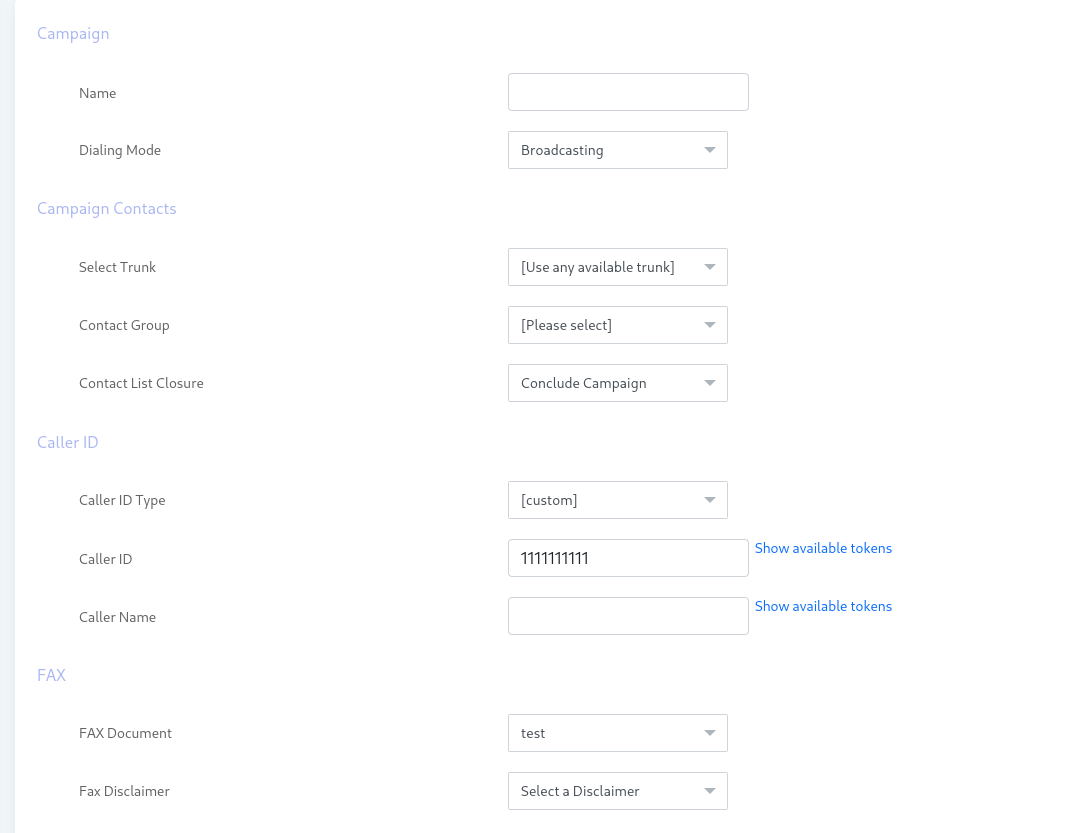
Steps to create a Fax Campaign:
- Upload a fax document that the user want to broadcast from Messages => Fax document => New document.
- Navigate to campaign => campaign Management => Add New => Fax Campaign
- Fill the campaign form with required fields like:
a) Campaign Name
b) Contact Group
c) Fax Document

- Click on Save to start the campaign.
Glossary
Campaign Name: Name of the campaign for identification.
Campaign Mode:
When selected to Normal, it stops the campaign after processing all the contacts. When selected to Permanent, it allows the campaign to keep running even after processing all the contacts and waiting for new contact in background.
Campaign Contacts
Contact Group: Select contact group/List of phone numbers that this campaign will dial.
Caller ID: Enter Caller ID to use with outgoing calls.
Caller Name: Enter caller’s name to use with outgoing calls.
FAX
Fax Document: Select from list of already uploaded fax documents.
Settings:
Max. Concurrent Channels: Maximum number of concurrent channels that the fax campaign will support.
Max Retries: Max number of retries to contact the said contact.
Max call Duration:
Maximum allowed duration for each call. Afterwards, the call will be disconnected automatically, if user is not sure about the duration of call, then select it be maximum number so that it does not affect call conversation.
Campaign Schedule:
**Start campaign: **
Start Schedule campaign has the following options:
a) Immediately: Start a campaign immediately just after creation.
b) On Scheduled Time: Start campaign on selected data and time.
Stop/Pause campaign: Schedule campaign stop time it has following options:
a) When Done: Stop the campaign when everything is completed.
b) On Scheduled Time: Stop campaign on selected date and time.
3rd Party Integration:
Request Call End: Select the call to be ended.
Click on “Save” button on top to start the campaign.
ix) SMS Campaign:
This option allows user to create SMS Campaign. This type of campaign dials numbers from the contact list and sends SMS messages to all recipients. When the user selects this campaign, it will open a form that lists all the options and settings for creating this campaign.
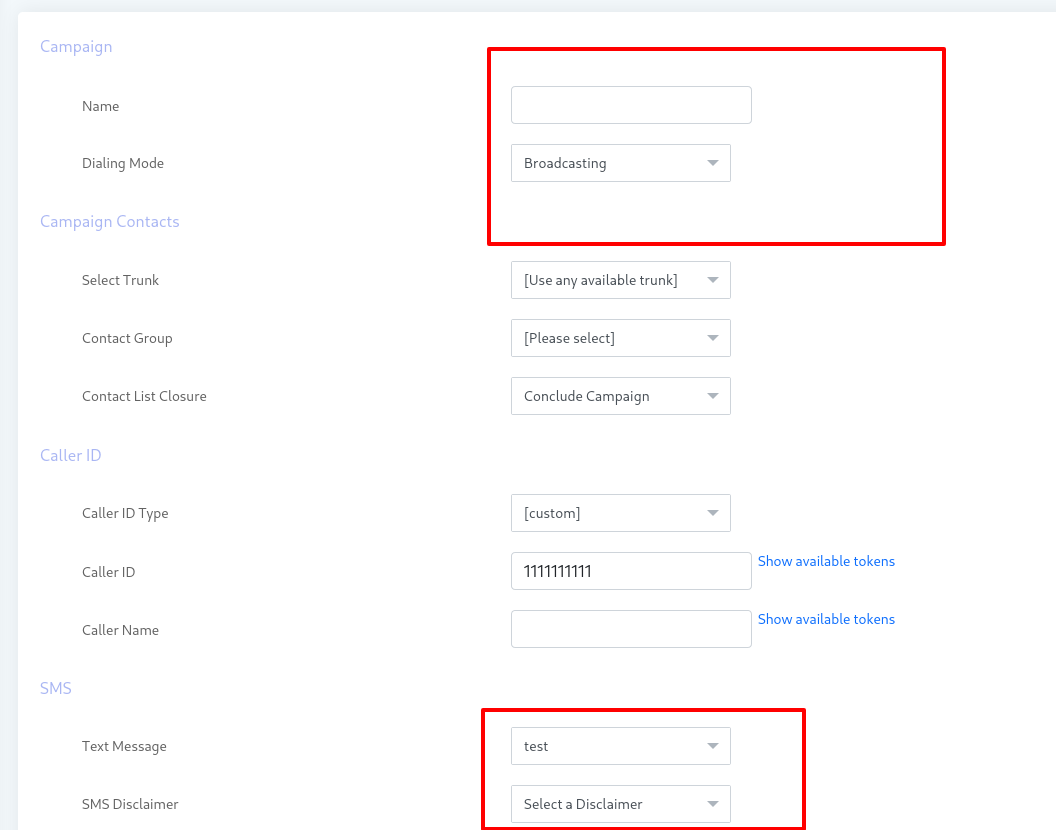
Steps to create an SMS Campaign:
- Create an SMS Message to Broadcast from setting => SMS Messages => New Text.
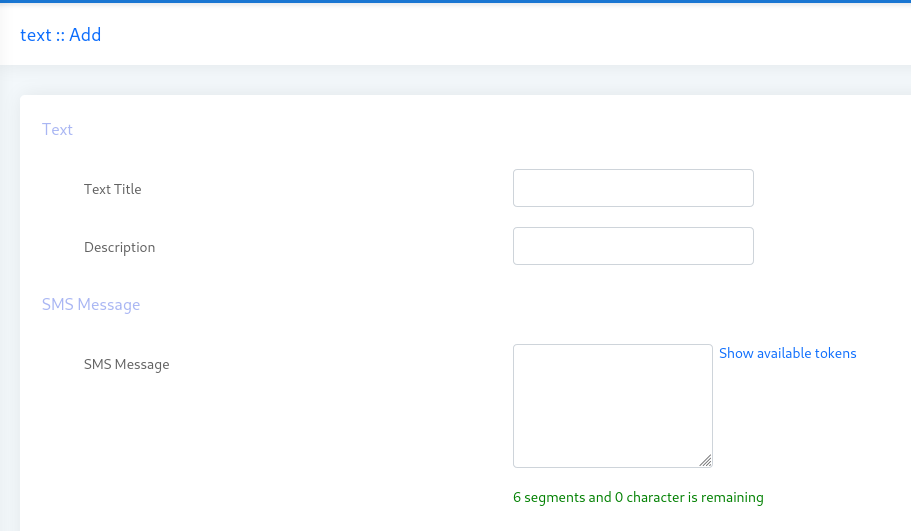
- Navigate to campaign => campaign Management => Add New => SMS Campaign.

- Fill the campaign form with required fields like:
a) Campaign Name
b) Contact Group
c) Text Message

- Click on Save to start the campaign
Glossary
Campaign Name: Name of the campaign for identification.
Campaign Mode:
When selected to Normal, it stops the campaign after processing all the contacts. When selected to Permanent, it allows the campaign to keep running even after processing all the contacts and waiting for new contact in background.
Campaign Contacts:
Contact Group: Select contact group/List of phone numbers that this campaign will dial.
Caller ID:
Caller ID Type: Enter Caller ID type to use with outgoing calls.
Caller Name: Enter caller’s name to use with outgoing calls.
SMS:
Text Messages: Select from the list of already created SMS messages.
Campaign Schedule:
**Start campaign: **
Start Schedule campaign has the following options:
a) Immediately: Start a campaign immediately just after creation.
b) On Scheduled Time: Start campaign on selected data and time.
Stop/Pause campaign: Schedule campaign stop time it has following options.
a) When Done: Stop the campaign when everything is completed.
b) On Scheduled Time: Stop campaign on selected date and time.
x) Feedback Campaign:
This option allows user to create Feedback Campaign. This type of campaign sends and receives
#
feedback to the specified email address of each of your contacts.
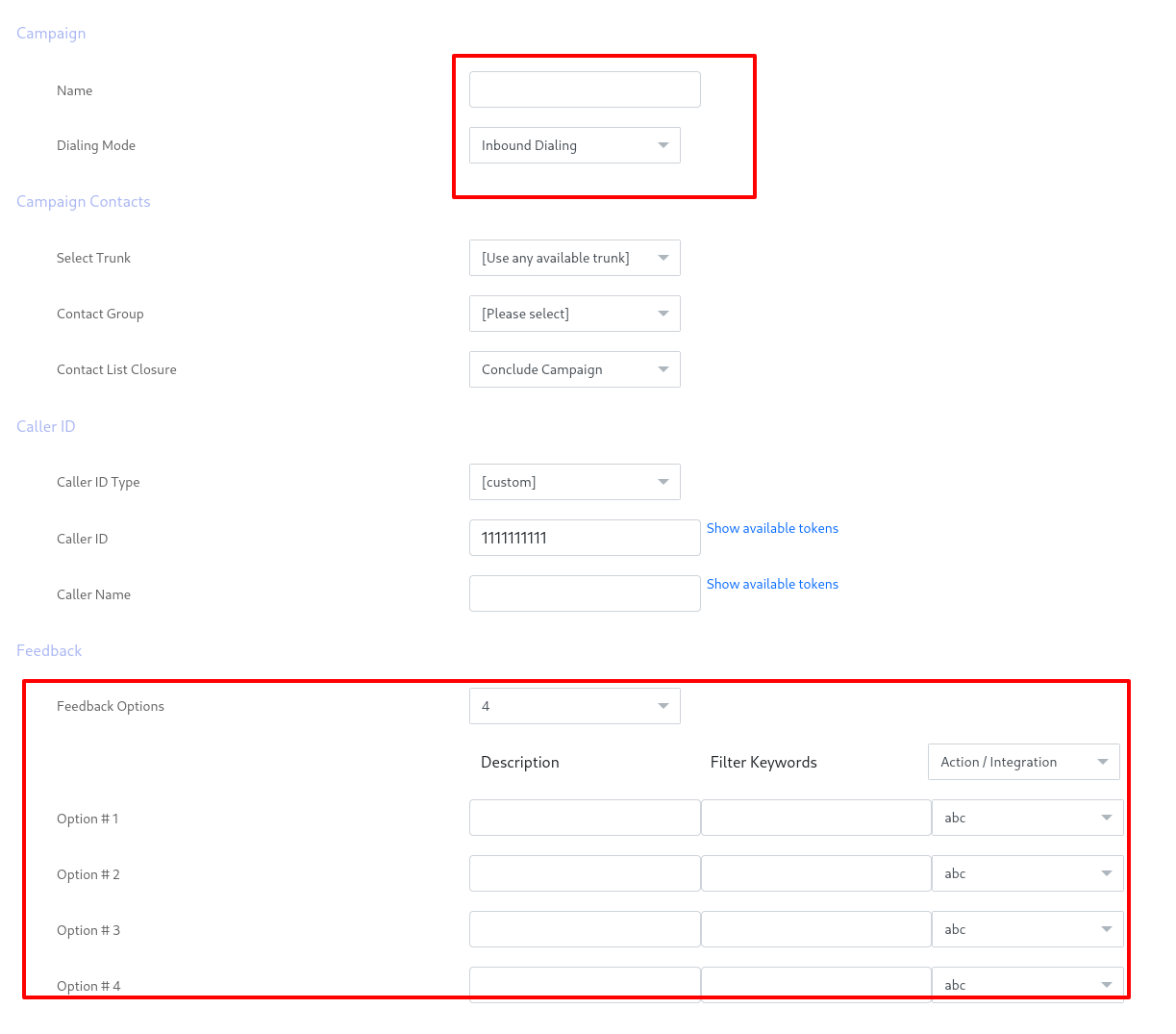
Steps to create Feedback Campaigns:
- Navigate to campaign => campaign Management => Add New => Feedback Campaign.
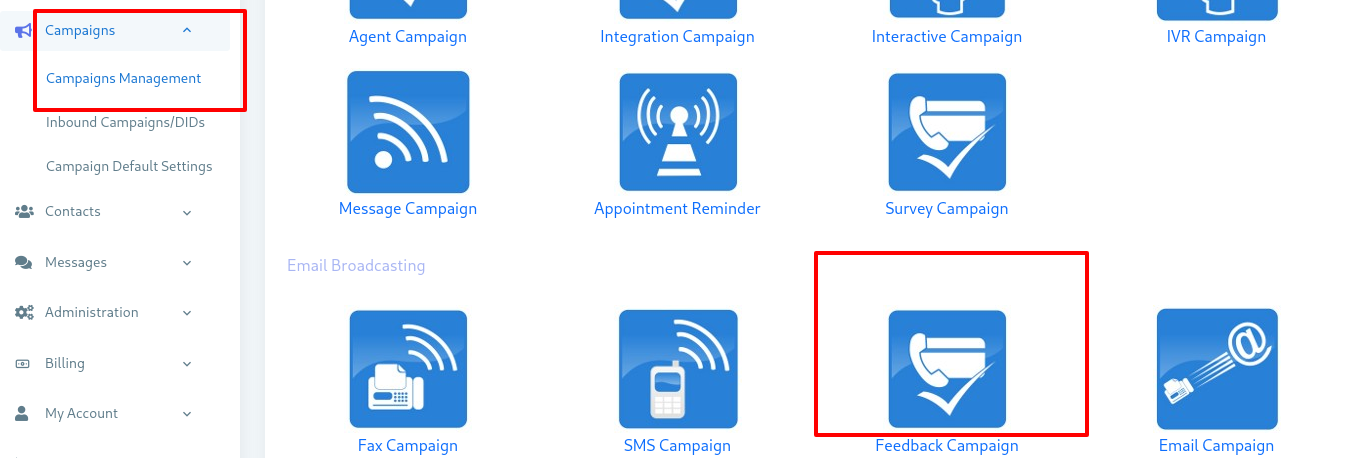
Fill the campaigns form with required fields like:
a) Campaign
b) Name
c) Campaign Contacts
d) Caller ID
e) Feedback Options
f) Campaign Schedule
- Click Save to start the campaign.
Glossary
Campaign:
Name: Name of the campaign for identification.
Campaign Mode:
When selected to Normal, it stops the campaign after processing all the contacts. When selected to Permanent, it allows the campaign to keep running even after processing all the contacts and waiting for new contact in background.
Campaign Contact:
Contact group: Select contact group/List of phone numbers that this campaign will dial.
Caller ID:
Caller ID Type: Enter Caller ID type to use with outgoing calls.
Caller ID: Enter Caller ID to use with outgoing calls.
Caller Name: Enter caller’s name to use with outgoing calls.
Feedback:
Select feedback options from the drop-down list, which starts from 1 and up to 9.
In Options 1, 2,3, 4 write a description in the first require field box.
Write filter keywords in the field box.
Select integration from the drop-down list which is required.
Campaign Schedule:
**Start campaign: **
Start Schedule campaign has the following options.
a) Immediately: Start a campaign immediately just after creation.
b) On Scheduled Time: Start campaign on selected data and time.
Stop/Pause campaign: Schedule campaign stop time it has following options.
a) When Done: Stop the campaign when everything is completed.
b) On Scheduled Time: Stop campaign on selected date and time.
xi) Email Campaign:
This option allows user to create Email Campaign. This type of campaign sends email to the specified email address of each of your contact.
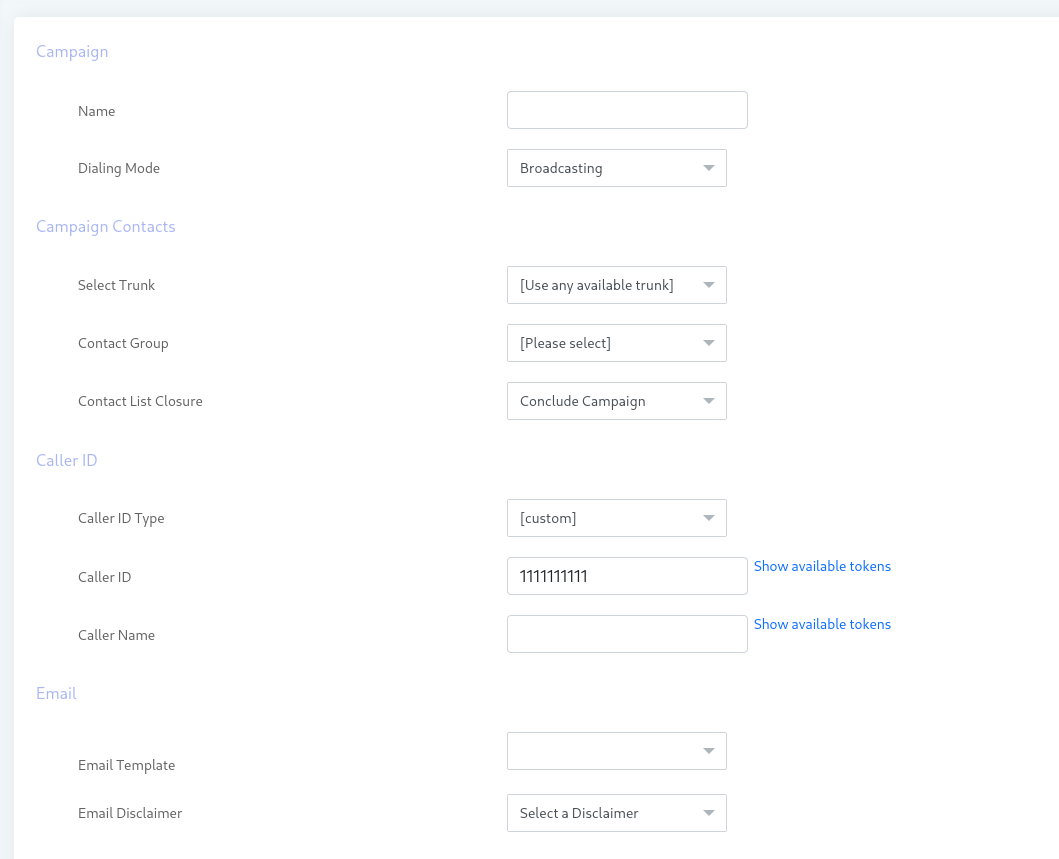
Steps to create an Email Campaign:
- Create an Email Template from Messages => Email Template => New Template and then fill message subject, body and save.

- Navigate to campaign => campaign Management => Add New => Email Campaign.
- Fill the campaign form with required fields like:
a) Campaign Name
b) Contact Group
c) Email Template
- Click on Save to start the campaign
Glossary
Campaign:
Name: Name of the campaign for identification.
Campaign Mode:
When selected to Normal, it stops the campaign after processing all the contacts. When selected to Permanent, it allows the campaign to keep running even after processing all the contacts and waiting for new contact in background.
Campaign Contacts:
Contact Group: Select contact group/List of phone numbers that this campaign will dial.
Caller ID:
Caller ID Type: Enter Caller ID type to use with outgoing calls.
Caller Name: Enter caller’s name to use with outgoing calls
Email Template: Select an email template that the user wants this campaign to send from a list of already created email templates.
Campaign Schedule:
**Start campaign: **
Start Schedule campaign has the following options:
a) Immediately: Start a campaign immediately just after creation.
b) On Scheduled Time: Start campaign on selected data and time.
Stop/Pause campaign: Schedule campaign stop time it has following options:
a) When Done: Stop the campaign when everything is completed.
b) On Scheduled Time: Stop campaign on selected date and time.
Contacts:
Allows user to manage contacts. Contacts can be grouped together into a contact group. Contacts are basically telephone numbers to be dialed. A contact group can have telephone numbers of multiple destinations/countries. User can also manage regions, countries, and destinations for call termination to a particular group or contact.
i)Contact Groups:
Contact group acts a container for contacts of a particular domain. Campaigns in ICTBroadcast also dials contacts from a particular contact group that is selected at the time of campaign creation.
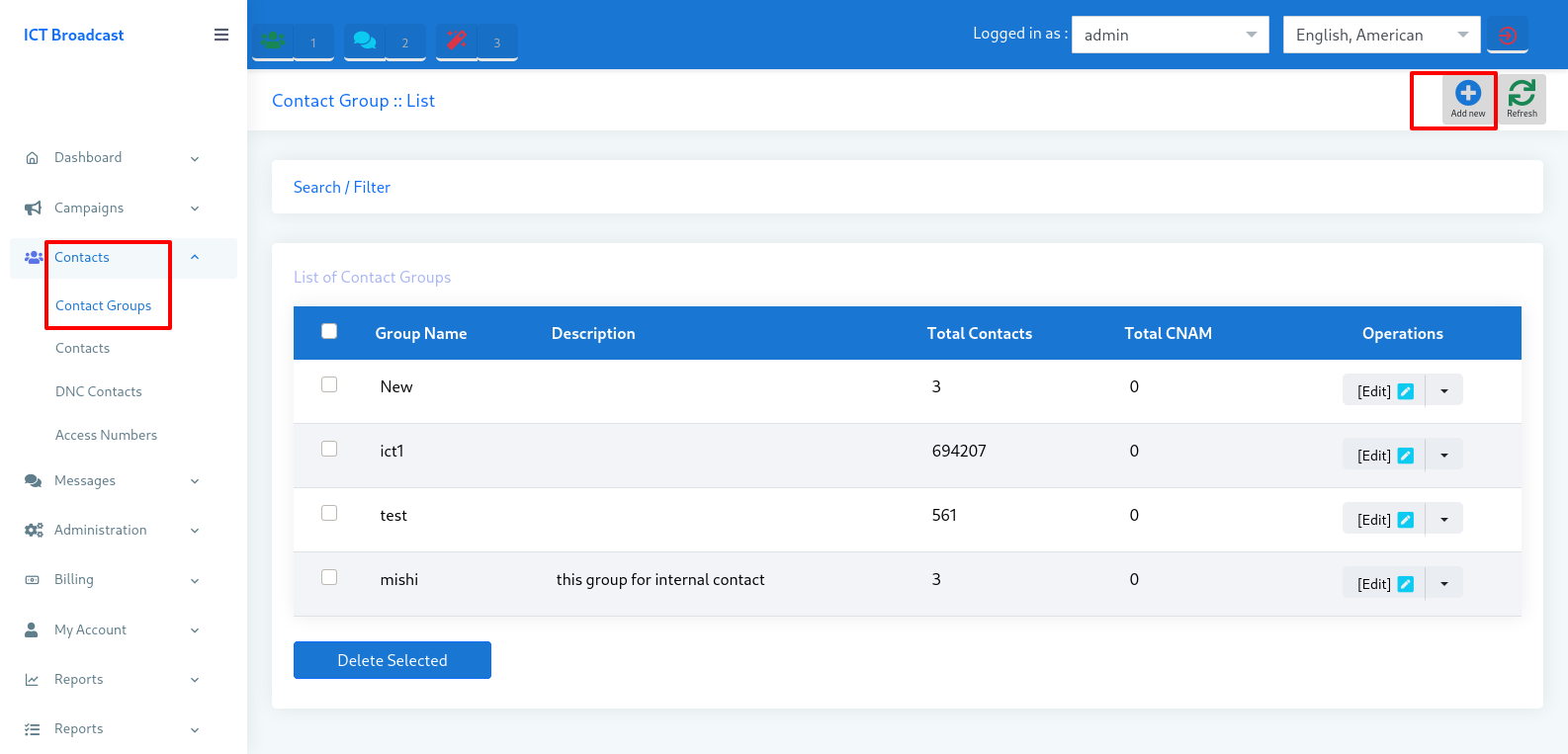
How to create a contact group?
- Navigate to Contacts => Contact Groups => Add New
- Enter Contact Group Description and Click Save.
- Next step is to fill contacts in a contact group.
Glossary
Group Description:
Title: Title allows user to distinguish between different contact groups.
Description: Description allows for further elaborate contact group if title is not enough meaning.
Import Contacts (Optional)
Type of source: Select source from where you want to import contacts.
ii) Contacts:
A contact is a phone number or other personal information.
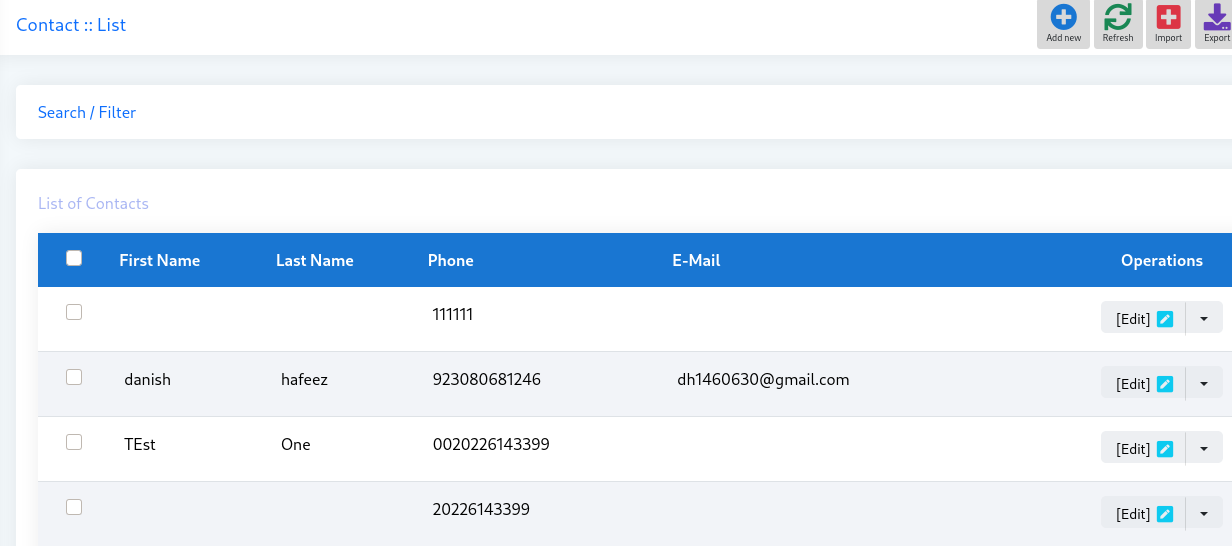
How to fill contacts in a contact group?
- Navigate to contacts => contacts
- There are 2 different ways to add contact.
*** Add New Contact**
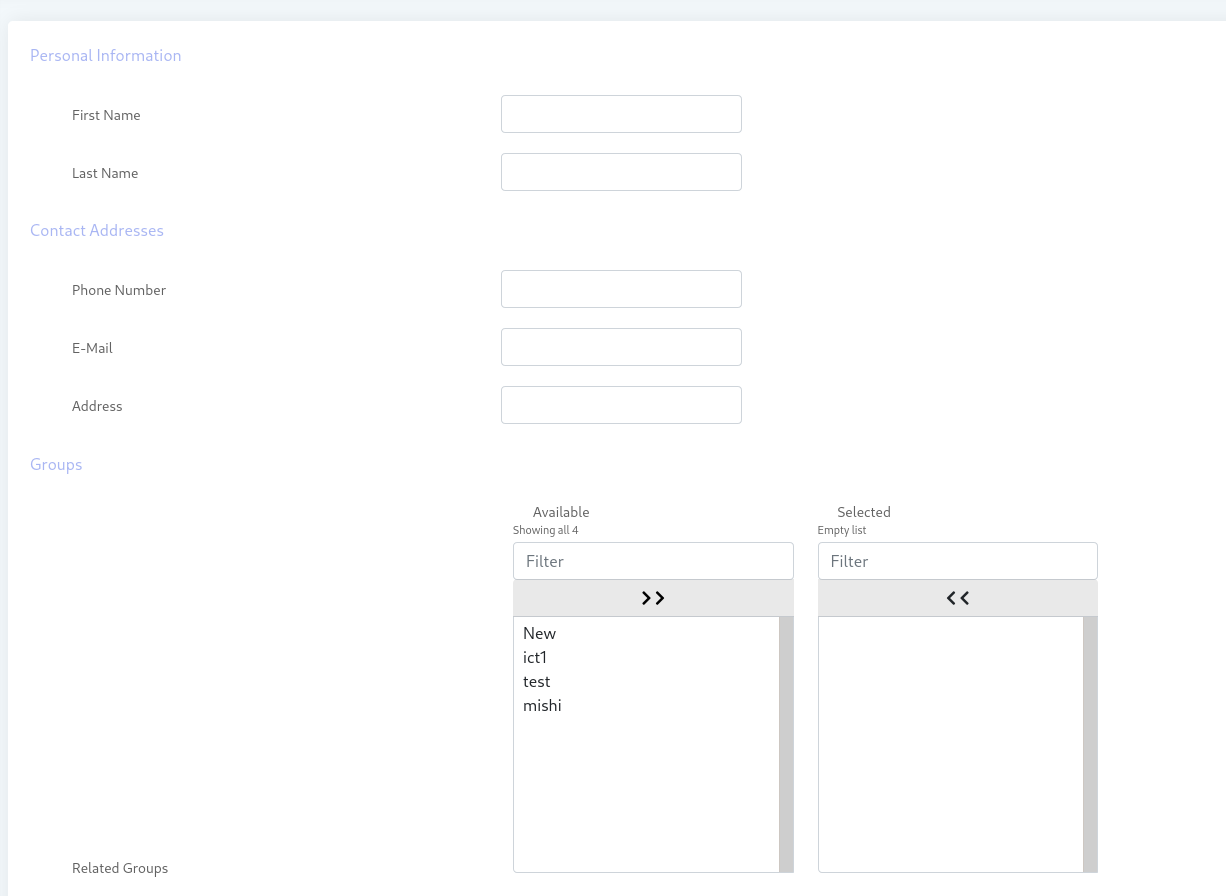
For bulk import contact:
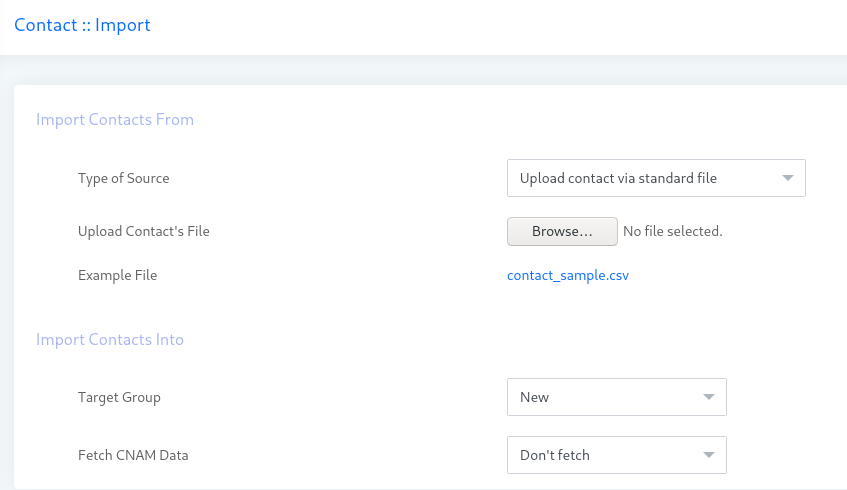
- Click Save.
Glossary
Add new:
Allows the user to enter contact in particular contact group by clicking on add new button.
Personal information:
Type the “First Name” and “Last Name” of the contact to be added.
Contact Addresses:
Type the contact “Phone number”, “Email”, and “Address”.
Groups:
Select the group from the already available group on the list.
Custom Data:
Type the custom data.
Comments/Remarks:
Type the comments in the Description.
Import:
Import Contacts From:
This option enables the user to import contact list from external text or CSV file by clicking on “import” button. The format of external file needs to be in CSV (comma-separated values) format as shown below:
923330000000, First Name, Last name, email@domain.com, address, custom 1, custom 2, custom 3, custom 4, custom 5, custom 6, custom 7, custom 8, 923331111111, First Name, Last Name, other@domain.com, address, custom 1, custom 2, custom 3, custom 4, custom 5, custom 6, custom 7, custom 8.\85
Import Contact Info: Select the Target Group.
First field is a phone number that is mandatory while other fields are optional. Which means the user can create a contact list simply using following format:
923300000000 923331111111\85
Find Duplicate:
This option enable user to find duplicate contacts.
Find Invalid:
This option enable user to find invalid contacts form list. Invalid contacts will be defined as contacts that do not match with pre-selected destinations of contact group.
iii) DNC Contacts:
DNC Contacts are the contacts that user does not want to call. User can apply this DNC list on the original contact list and it will filter out and eliminate those contacts from contact list which are present in the DNC list.
DNC Group: Select the DNC group.
Personal Information:
Type the “First Name” and the “Last Name”.
DNC Address:
Type “Phone number”, “Email”, and “Address”.
Comments/Remarks:
Type comments in the description box.
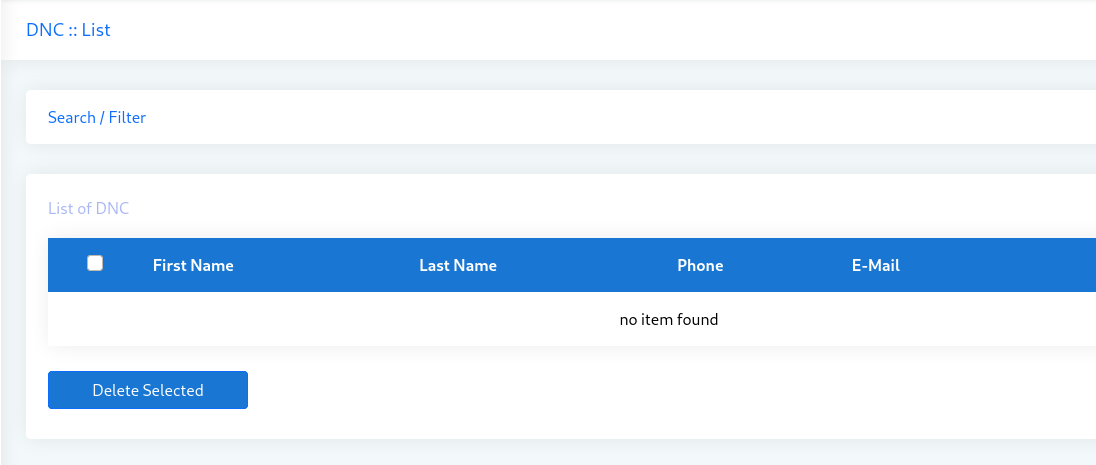
Messages:
This is a very important area of ICTBroadcast. It allows user to manage Extensions, Trunks, DIDs, IVRs, Recordings, SMS and Faxes. All these options are required when the user needs to create a campaign. In other words, whenever the user wants to create a campaign of his/her choice, user first need to come to Messages menu for upload some recordings, SMS or faxes, the user may need to add trunks for call termination, user may need DIDs if he/she want to create inbound campaign, etc.
i)Recordings:
This is an area where user will upload recordings. These recordings could be messages, survey questions, introductory message, etc. If user don’t have recordings. Don’t worry, the system also provides user with TTS (text-to-speech) feature. Select recording, type to Text and write text that user wants to play. System will create its recording and that message will be played. System also provides the user with a feature to play the sound that user uploaded or written text.

a) Preparing Voice Recording:
The required format of the sound file need to 8 Khz sampling rate, 16 bits mono and supported types is wave file. User can use one of the following methods to create 8 Khz 16-bit mono wave files.
a) Microsoft Windows built-in recording tool “Sound Recorder”.
- Click on “start” button on windows operating system.
- Click on “All Programs”.
- Click on “Accessories”.
- Click on “Entertainment”.
- Click on “Sound Recorder”.
- Record your voice through the mic using start and stop buttons.
- Click on File menu.
- Click on “Save as”.
- Enter proper file name.
- Select “Save as type” as wave file.
- Click on “Change” button to change format to 8khz 16 bit mono.
- Upload saved file to ICTbroadcast as new recording.
b. TTS (Text-to-speech) programs:
Open-source solution like speak, flite and festival and commercial solutions like Cepstral, speech and voice forge. This feature has been added to a new version of ICTBroadcast using festival TTS program. Now the user just writes text, its audio will be created by system.
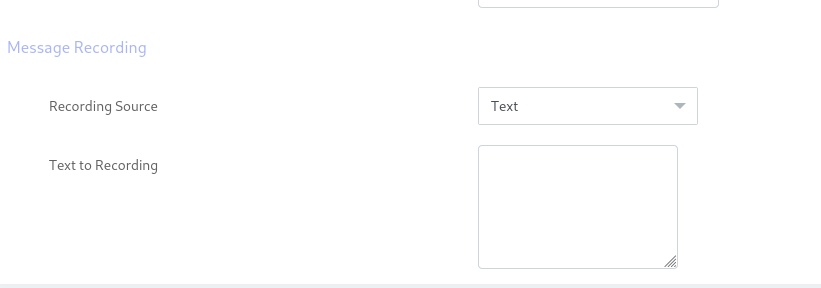
c. Open-source software:
Open-source software like audacity for audio recording and editing
d. Professional voice overs from professionals’ providers like voice123.
Steps to Create Recordings:
- Messages => Recordings => Add New.
- Select recording source.
ii) Fax Documents:
This is an area where user will manage fax documents. User can also preview fax documents once they are uploaded.
Steps to create Fax Document:
1.Navigate to Messages => Fax Document => Add New.

- Enter the Document name and description.
- Fax document is to select “Fax Quality” and choose the file of fax document (pdf, tiff).
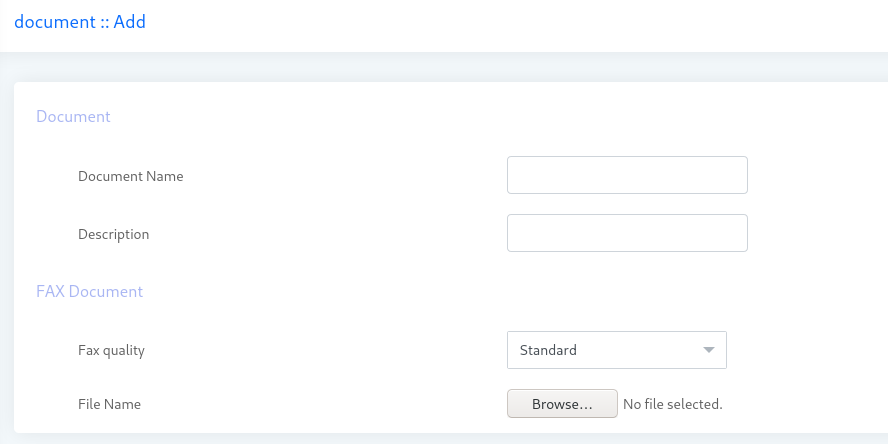
iii) SMS:
This is an area where the user manages SMS messages.
Following form is simple and just requires Text Title for message, description if any, and SMS message that user wants to broadcast. Using Tokens in SMS Messages:
In SMS, user can use tokens while creating an SMS. Tokens are useful when customer specific information will be required. For example, using customer’s name, address or email address in the SMS. Following pattern is allowed for using tokens:
[contact: first-name]
Whenever the above pattern is used; it means the first name of contact will be replaced at this place. Similarly, you can use [contact: last name], [contact: custom1], [contact: custom2], [contact: email] etc.
You can use all the fields of ICTBroadcast contact as tokens. Following is a list of tokens that can be used in SMS Messages:
[campaign: caller id]
[campaign: callerid_name]
[campaign: name]
[call: contact]
[call: status]
[call: error]
[contact: first name]
[contact: last name]
[contact: phone]
[contact: email]
[contact: address]
[contact: custom1]
[contact: custom2]
[contact: custom3]
[contact: custom4]
[contact: custom5]
[contact: custom6]
[contact: custom7]
[contact: custom8]
Steps to create SMS Messages:
- Navigate to Messages => SMS => Add New.


iv) Email Template:
Here, user can create various email templates for email broadcasting campaigns. Email template is a sample email text where the user can provide the subject of the email, email body, alternate email body (optional, if receiver don’t have HTML support), file attachments, use custom tokens in place of receiver’s name, email and contact information, etc. Once the email template is complete, the user can use it to send to its contact list.
Template name:
Name of the template as it appears in campaign form.
Description:
Description of the template (optional).
Subject:
Subject line of the email that user the wanted to send to its contact list Message Body:
Actual message (email body) to send an Alternate Message:
Alternate message without any HTML tags (optional).
File/Image:
Any number of attachment files to send with email. To attach a file, select it from choice file field and click save button at the top of the page. To remove an attached file, simply check the select box against it and click save at the top of the page.
Using Tokens in Email Templates:
Tokens are useful when customer specific information is required.
Following pattern is allowed for using tokens in email templates:
[contact: first name]
Whenever the above pattern is used, it means the first name of contact will be replaced at this place.
Following is a list of tokens that can be used in Email Templates:
[campaign: caller id]
[campaign: callerid_name]
[campaign: name]
[call: contact]
[call: status]
[call: error]
[contact: first name]
[contact: last name]
[contact: phone]
[contact: email]
[contact: address]
[contact: custom1]
[contact: custom2]
[contact: custom3]
[contact: custom4]
[contact: custom5]
[contact: custom6]
[contact: custom7]
[contact: custom8]
Plus, two extra tokens that can only be used in email templates are:
[url_confirm_yes]
[url_confirm_no]
Steps to create Email Templates:
- Navigate to Messages => Email Template => New template.
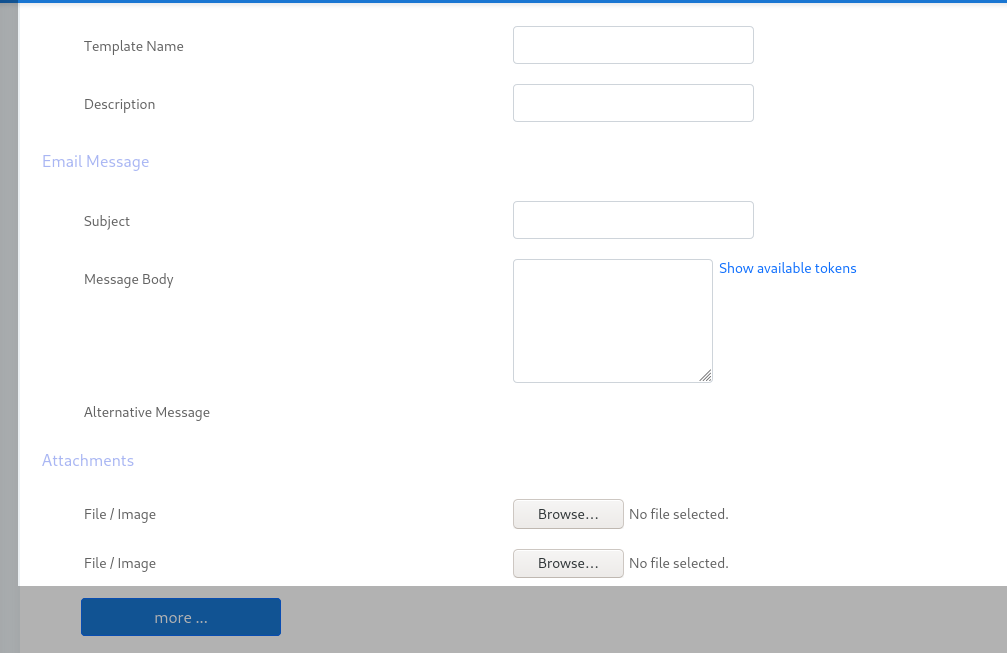
v) IVR (Interactive Voice Response):
IVR stands for Interactive Voice Response. It allows the system to read custom information using text-to-speech or recorded message and to detect keypad inputs. IVR can be used to build systems such as virtual receptionists, custom appointment reminders, and advanced telephone surveys.
a) Introduction to IVR Designer:
IVR Designer allows you to create advanced telephony systems with a simple drag-and-drop interface. The user can pick any application from the toolbar area, then drag it to the main drawing area and drop it. This will create that application at the dropped location. Its drag-and-drop interface makes it easy for users to create voice response applications in a web browser. IVR Designer’s toolbar contains the applications to create an IVR. Following is a brief description of each of those applications.
Using Tokens in IVR Applications:
Tokens are variables that replace their value dynamically while the campaign is run. Tokens have predefined way to use. Some IVR applications allows you to enter or select tokens. IVR designer allows a specific pattern for using tokens, which is described below:
[contact: first-name]
Whenever the above pattern is used; it means the first name of contact will be played. Similarly, you can use [contact: last name], [contact: custom1], [contact: custom2], [contact: email] etc.
You can use all the fields of ICTBroadcast contact as tokens. Currently, TTS, Say Alpha, Say Digit, Say Number, Say Date, and Say Time applications support using tokens.
Following is a list of tokens that can be used in IVR Applications:
[campaign: caller id]
[campaign: callerid_name]
[campaign: name]
[call: contact]
[call: status]
[call: error]
[contact: first_name]
[contact: last_name]
[contact: phone]
[contact: email]
[contact: address]
[contact: custom1]
[contact: custom2]
[contact: custom3]
[contact: custom4]
[contact: custom5]
[contact: custom6]
[contact: custom7]
[contact: custom8]
Description IVR Applications:
Call Answer:
Call answer applications answers an incoming call.

Call Hang up:
Hang up application forces a call to be disconnected.

Get Input:
Get any input request from your IVR

Condition:
Apply the condition for test whether the first name and last name is matched or not.

Time Condition:
Apply Time Condition for test.

Play Audio:
Plays a sound file. You can use a sound file from the Recording section in the Messages area.

Call Transfer:
The Transfer application connects the active call to a specified phone number of an agent. This number is referred as Extension number in ICTBroadcast.

Call Record:
The Record application can either create a recording, which starts with a beep and ends with the user pressing pound, or it can record the remainder of the call.

Options Menu:
Options Menus are used to gather keypad input from the user. Each menu node requires at least one “Play” node to present options to the user, and one or more “Key Press” nodes to handle the incoming key presses.

Answering Machine Detection (AMD):
It detects after answering of a call whether it is Human or Machine. Then on the basis of this decision, the user can perform any action.

Do Not Call (DNC):
DNC Application adds a number to DNC list.

Text-To-Speech (TTS):
TTS application allows user to enter text that will be played as a sound.

Say Alpha:
Say Alpha application allows you to enter alpha numeric value or select some variable and then play that value.

Say Digit:
Say Digit application allows you to enter digits or select some variable and then play that value.

Say Number:
Say Number application allows you to enter some number or select some variable and then play that value.

Say Date:
Say Date application allows you to enter date or select some variable and then plays that value.

Say Time:
Say Time application allows you to enter time or select some variable and then plays that value.

DTMF:
DTMF stands for dual tone multi frequency generated tone or sounds when any key is pressed.

Add Delay:
Enter seconds to add delay before executing next applications (only numbers are allowed).

Set Caller ID:
As the name suggests, this application sets caller id for outbound calls. You can also use caller id when the call is transferred. However, make sure that caller id application should be placed before transfer application.

Integrating API:
Select Integration API from the drop-down list which you want to Call.

ii) Creating IVR Applications:
In this section, working examples are given that demonstrate how IVR designer and IVR applications can be used to create various IVRs. These IVRs then can be attached to a campaign for broadcasting.
Glossary
IVR Application: A unique IVR element within IVR Designer containing a specific function. E.g., Play Audio plays wave recording. Call Hang-up will disconnect the call.
IVR (IVRs):A complete IVR that contains one or more IVR Applications (elements) linked together. It is saved as a record, can be edited later and is available to be attached to a campaign.
How to Create IVR Through Web based Designer?
- Navigate to Messages => IVR => New IVR. 2. Set IVR Name.
- Drag and Drop Applications from the toolbar area to the drawing area.
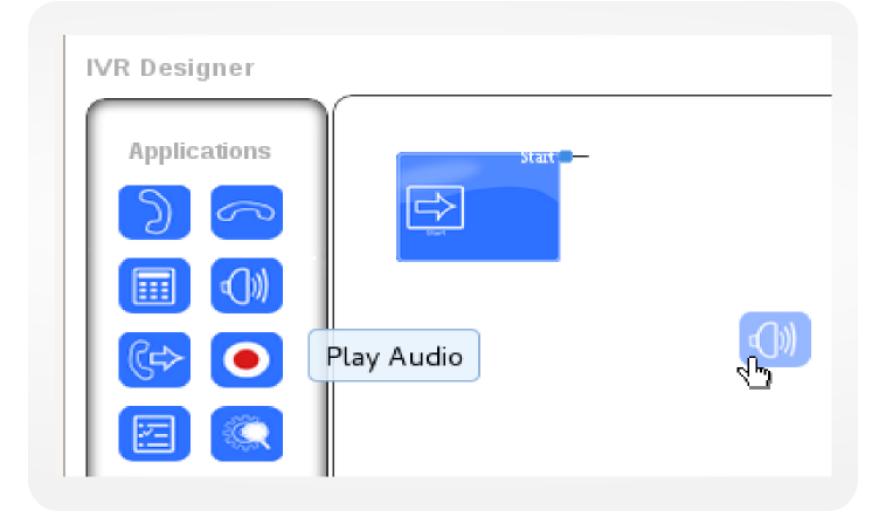
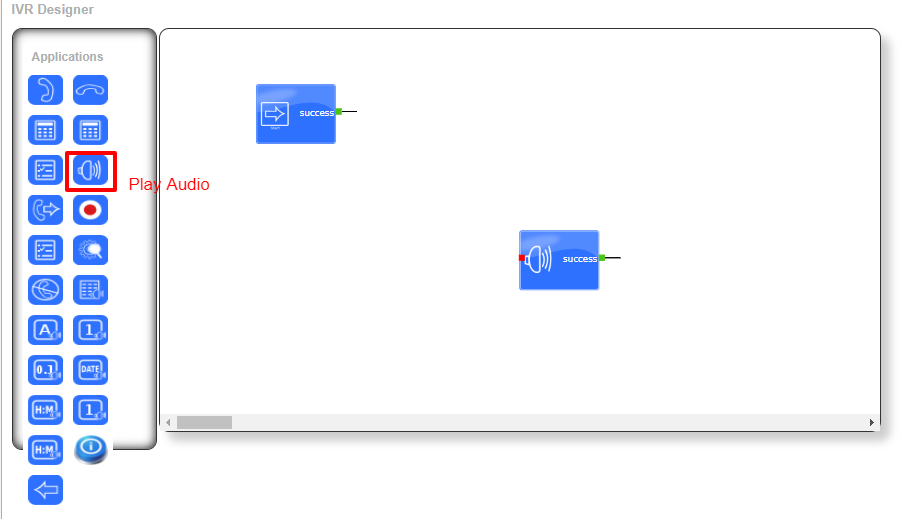
- To Link one Application to other Applications, move the pointer to a small rectangle at top left of Application. Press and hold down the button on the mouse.
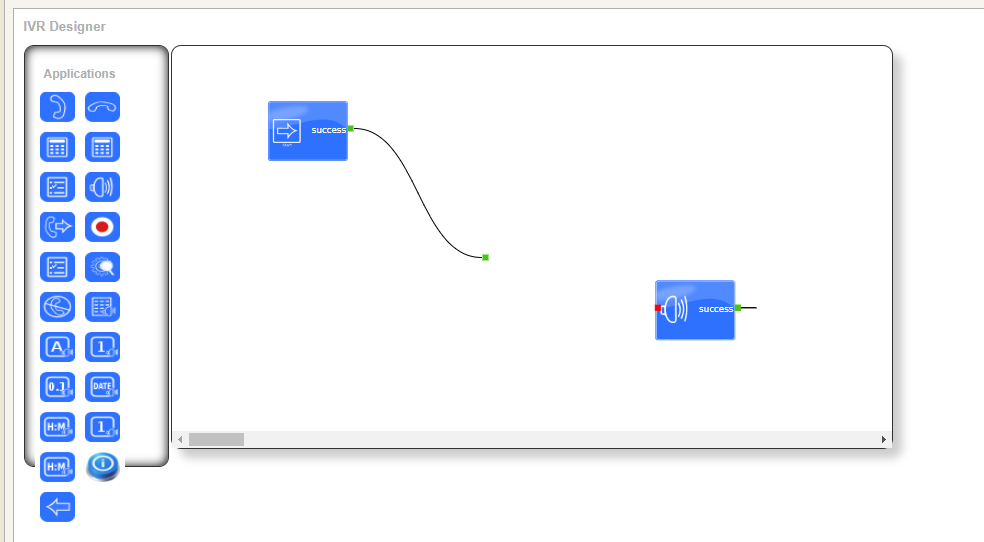
- Drag and drop it over other Application by releasing the button.
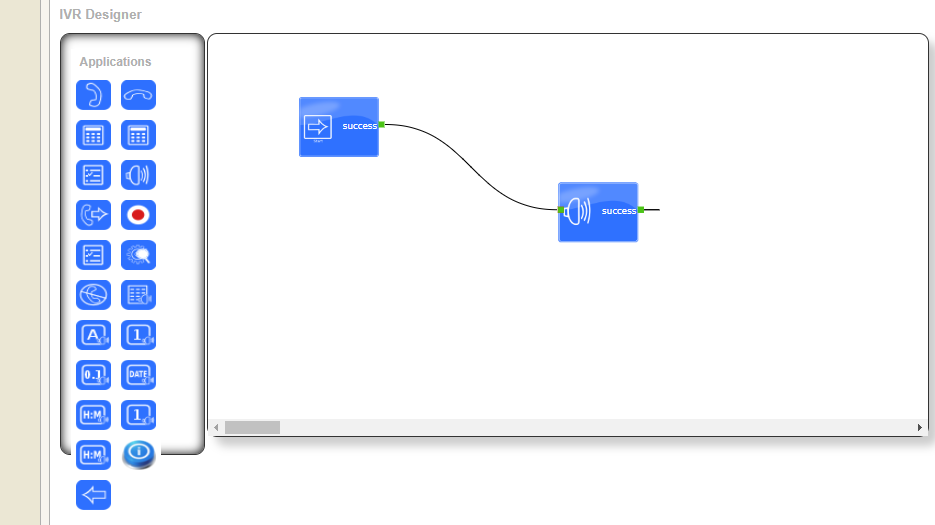
- To Remove link, select the destination pointer of link that user wanted to remove. Drag it, the source application and drop it over the source application.
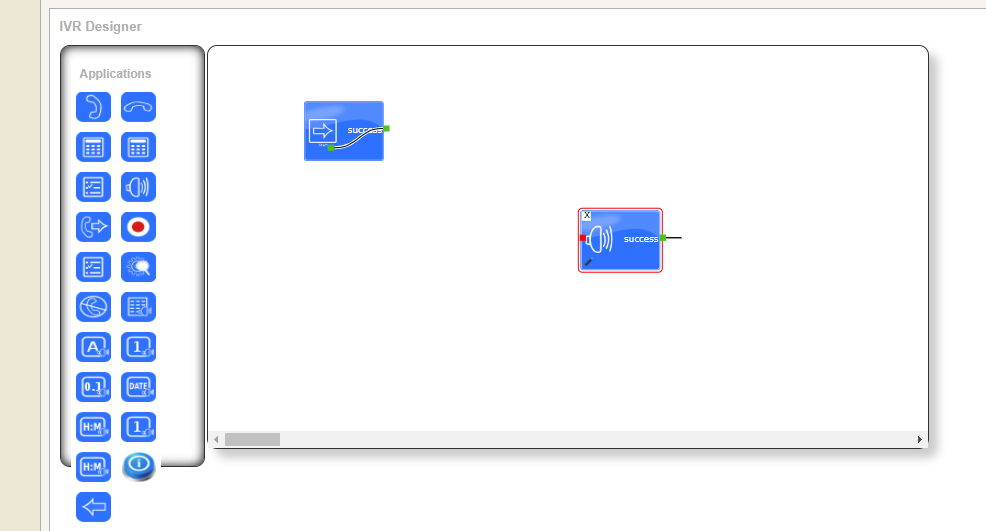
- To set Application settings, click on the small pencil at the bottom left of the Application.
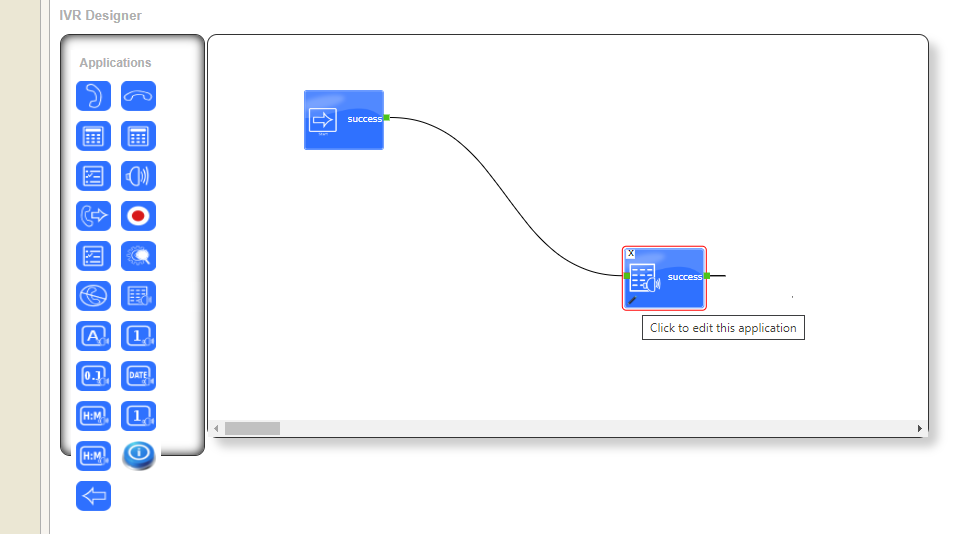
- This will open a popup window. Every Application has different parameters settings. In the example below, TTS application properties popup is shown.
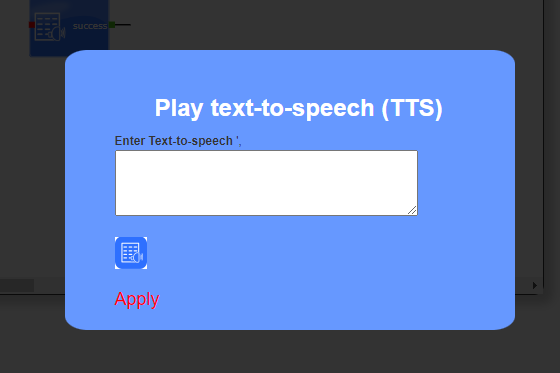
How to use Play Audio Application in IVR?
- Create New IVR => Drag and Drop Play Audio Application to Drawing Area.
- From popup window of Play Audio Applications.
Select the required recording from drop-down menu and Click Apply to save.
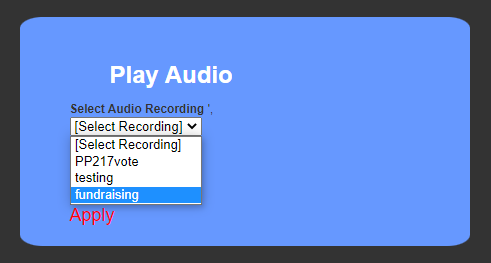
- Link starts Application with the Play Audio Application by dragging and dropping “Start Application” link on the “Play Audio Application”. Click Save button on the page menu to save this IVR.
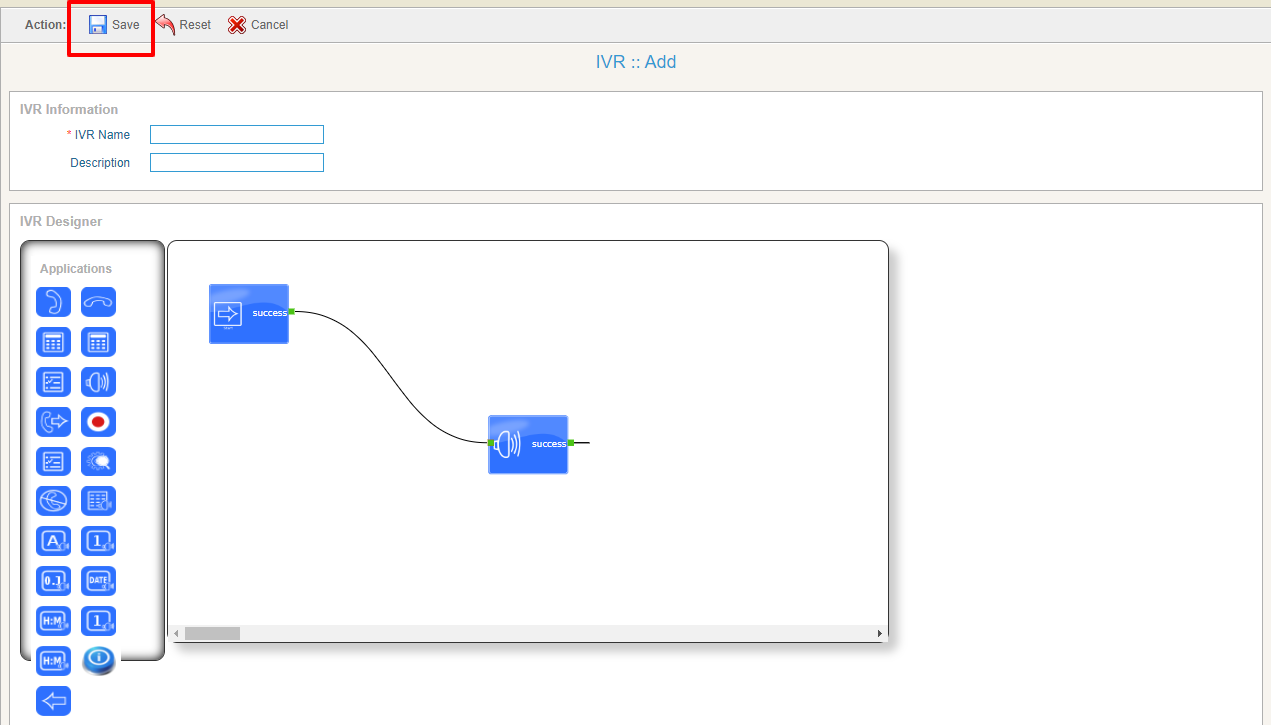
How to use Condition Application in IVR?
- Create New IVR => Drag and Drop Condition Application to Drawing Area.
- From popup window of Condition Applications.
- Select the required variable for test from drop-down menu and Click Apply to save.
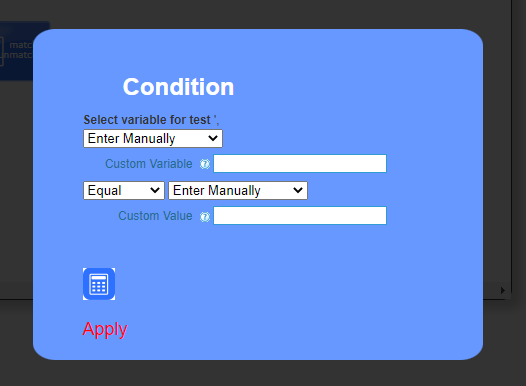
- Link start Application with the Condition Application by dragging and dropping “Start Application” link on the “Condition Application”.
- Click Save button on the page menu to save this IVR.
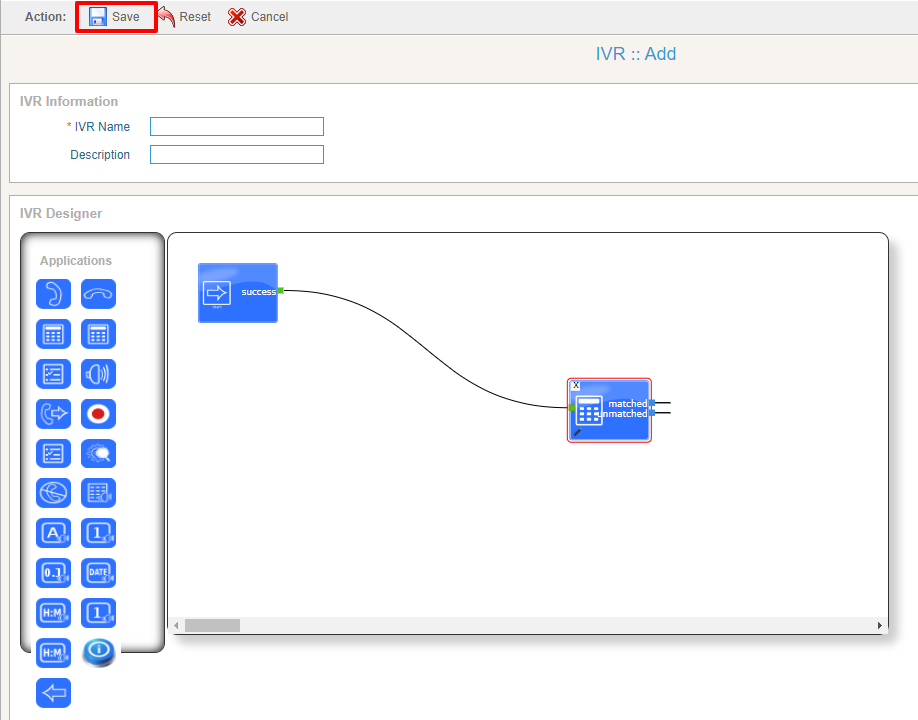
How to use Time Condition Application in IVR?
- Create New IVR => Drag and Drop Time Condition Application to Drawing Area.
- From popup window of Time Condition Applications.
- Select the required variable for test from drop-down menu and Click Apply to save.
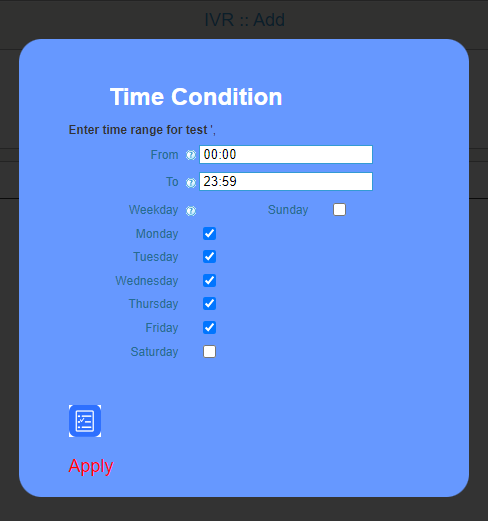
- Link start Application with the Time Condition Application by dragging and dropping “Start Application” link on the “Time Condition Application”.
- Click on Save button on the page menu to save this IVR.
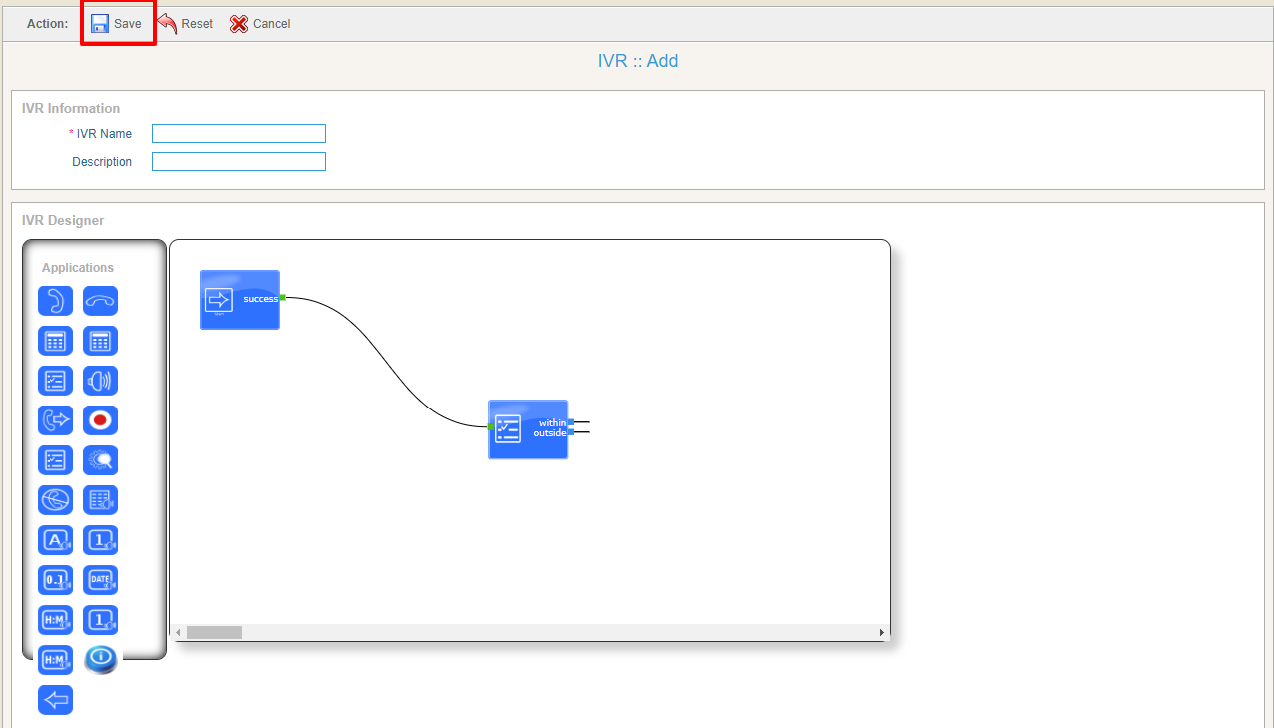
How to use Text to Speech (TTS) Application in IVR?
- Create New IVR => Drag and drop TTS Application to Drawing Area.
- In popup window, write the text that the user wants to play, and then click apply to save.

- Link start Application with the TTS Application by dragging and dropping “Start Application” link on the “TTS Application”.
Click Save button on the page menu to save this IVR.
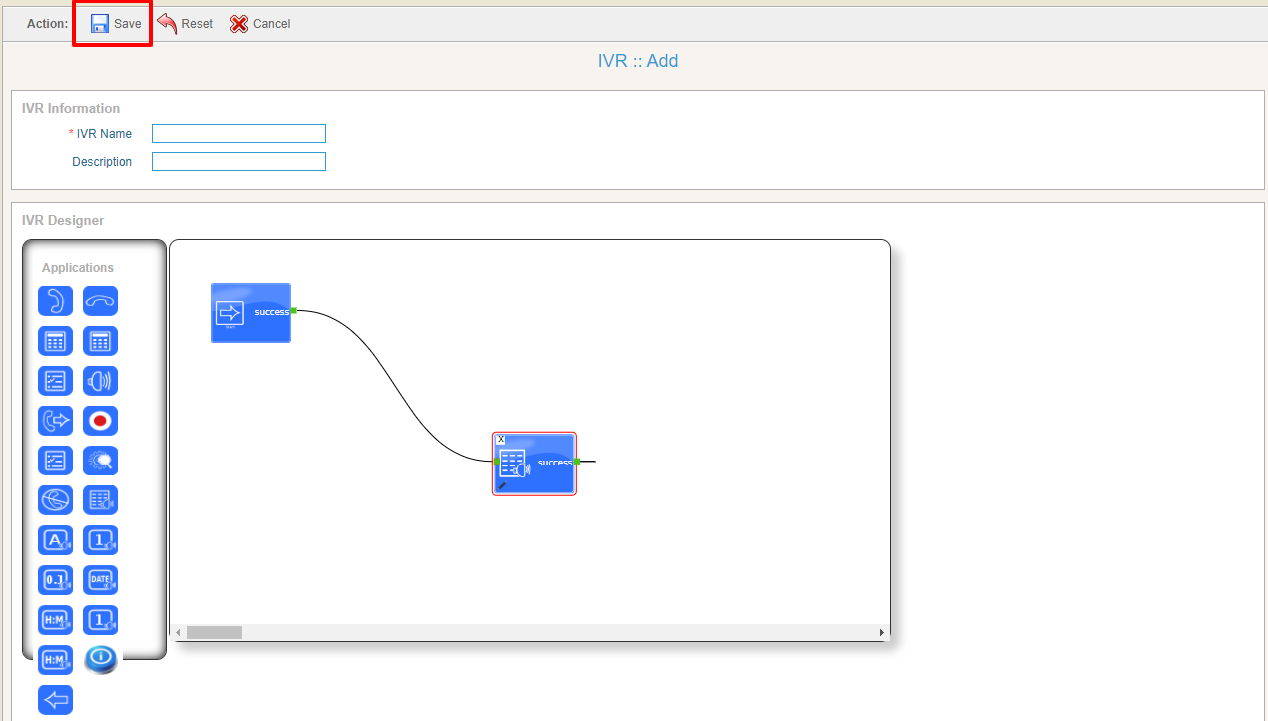
How to use Say Alpha Application in IVR?
- Create New IVR => Drag and drop Say Alpha Application to Drawing Area.
- From the popup window, user can select predefined variables whose value will be played by this application. User can also select custom from dropdown menu. This will allow the user to write alpha numeric value in the text box.
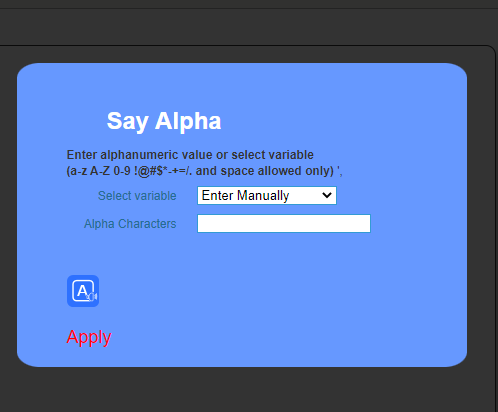
- Link start Application with the Say Alpha:
Application by dragging and dropping “Start Application” link on the “Say Alpha Application”. Click Save button on page menu to save this IVR.
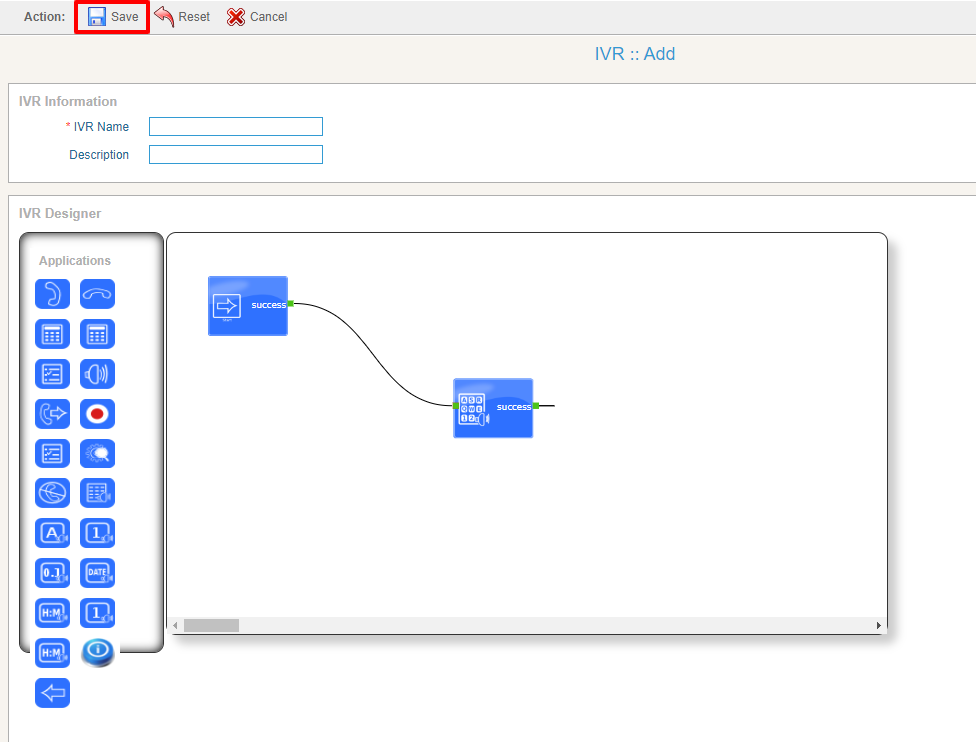
How to use Say Digit Application in IVR?
- Create New IVR => Drag and drop Say Digit Application to Drawing Area.
- From popup window, user can select predefined variables, whom value will be played by this application. User can also select Customer option from dropdown menu. This will allow the user to write only digits (0 – 9) in the text box.
Click Apply to save.
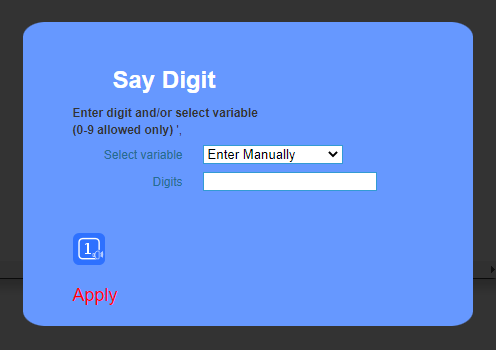
- Link starts Application with the Say Digit Application by dragging and dropping “Start Application” link on the “Say Digit Application”. Click Save button on page menu to save this IVR.
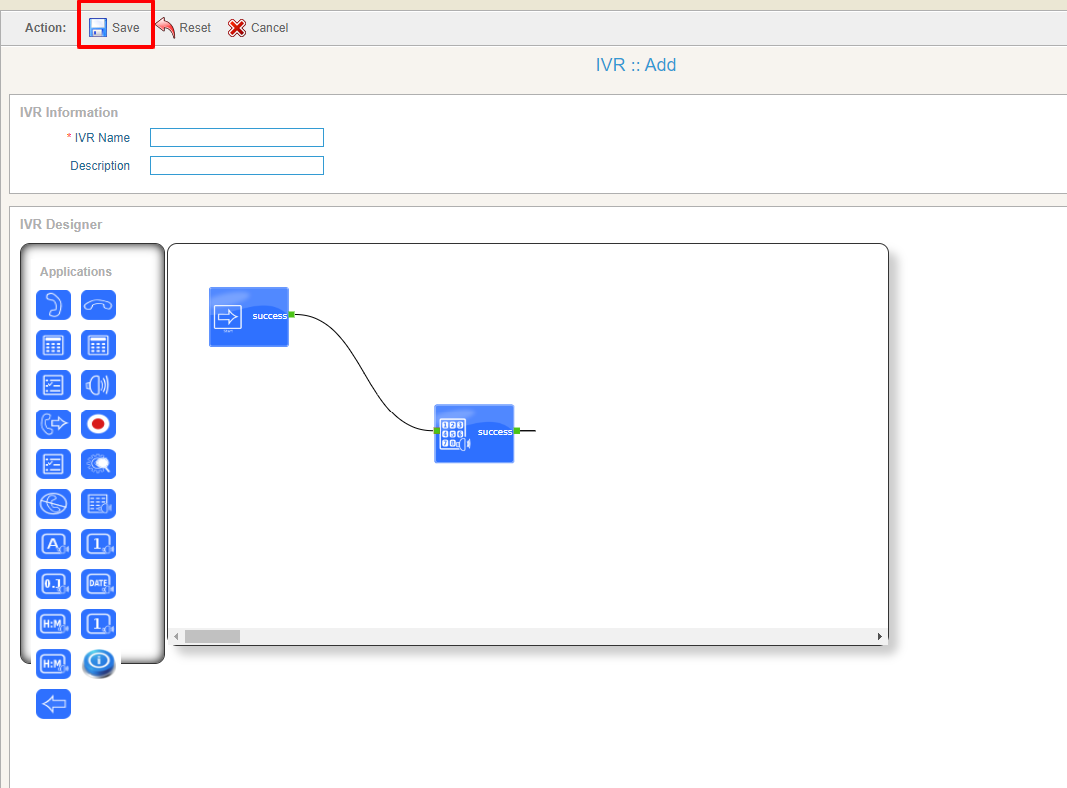
How to use Say Number Application in IVR?
- Create New IVR => Drag and drop Say Number Application to Drawing Area.
- From the popup window, user can select predefined variables whose value will be played by this Application. User can also select customer from dropdown menu. This will allow the user to write only number (0 – 9 and “. “) in the text box.
Click Apply to save.
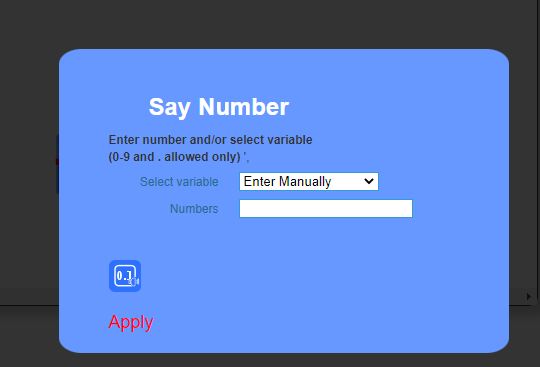
- Link start Application with the Say Number Application by dragging and dropping “Start Application” link on the “Say Number Application”.
Click Save button on the page menu to save this IVR.
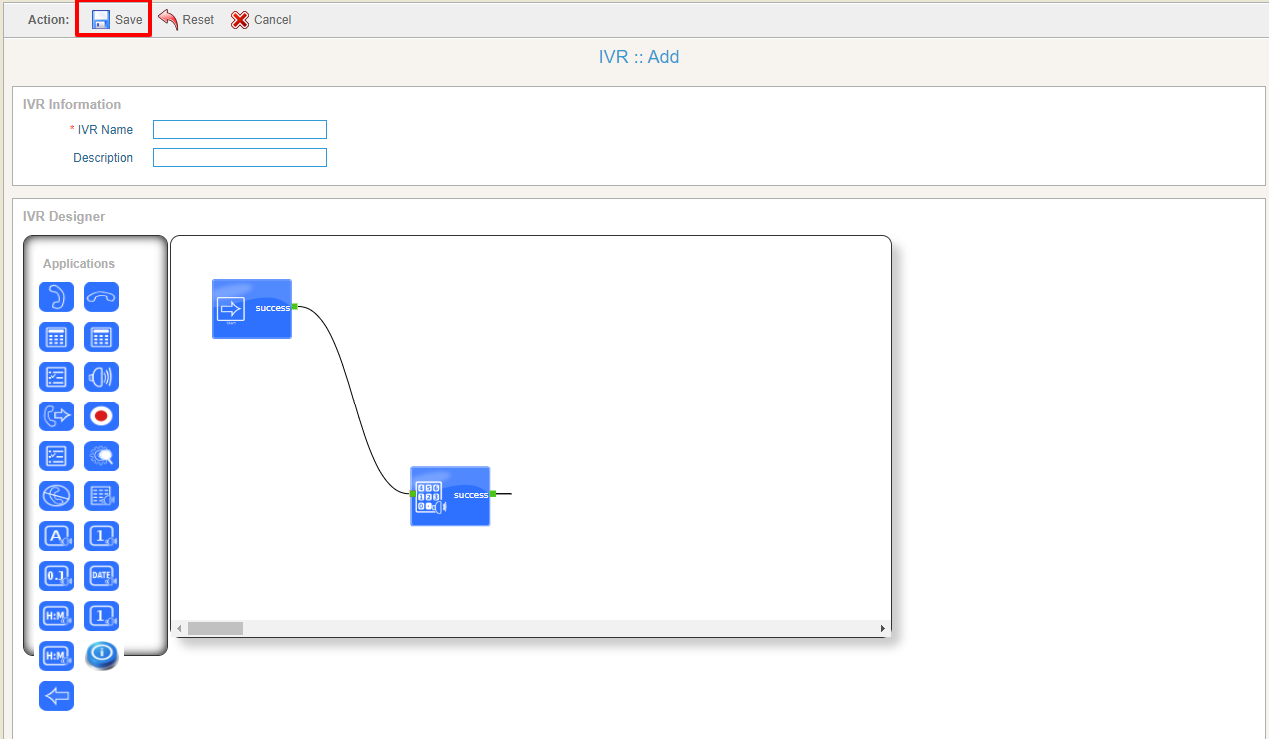
How to use Say Date Application in IVR?
- Create New IVR => Drag and drop Say Date Application to Drawing Area.
- From the popup window, user can select predefined variables whose value will be played by this application. User can also select customer from dropdown menu. This will allow the user to select time (mm: dd: yy) from the given field below.
Click Apply to save.
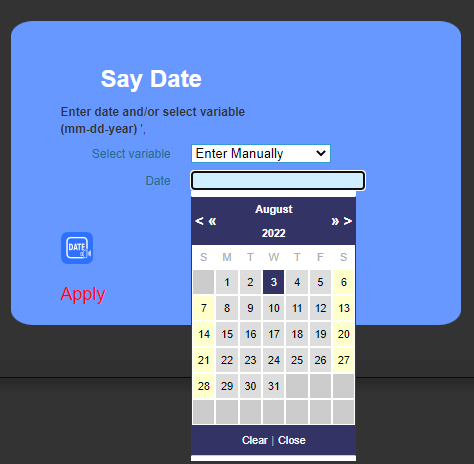
- Link start Application with the Say Date Application by dragging and dropping “Start Application” link on the “Say Date Application”. Click Save button on the page menu to save this IVR.
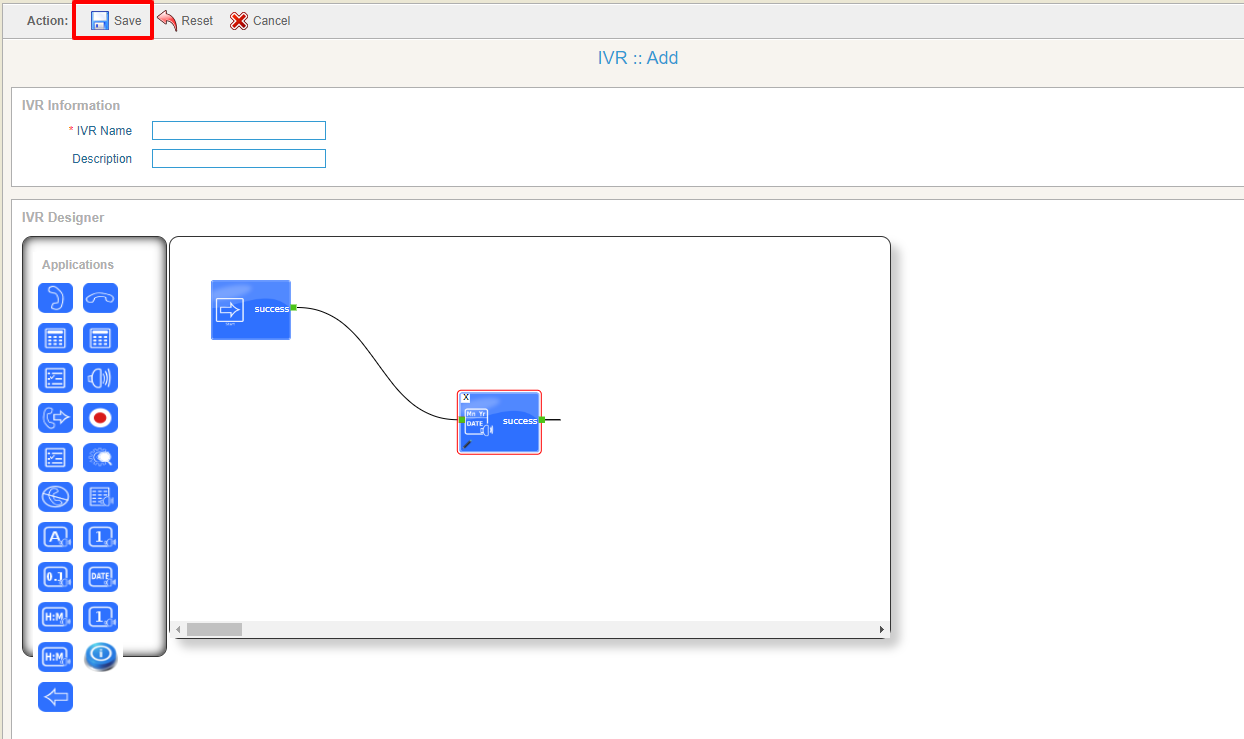
How to use Say Time Application in IVR?
- Create New IVR => Drag and drop Say Time Application to Drawing Area.
- From the popup window, user can select predefined variables whose value will be played by this application. User can also select variable from dropdown menu. This will allow user to select time (Hour: Minute) from the given field below.
Click Apply to save.
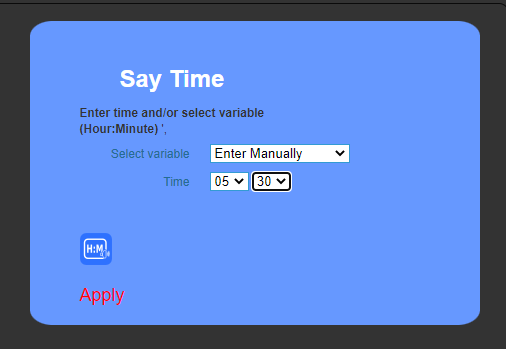
- Link start Application with the Say Time Application by dragging and dropping “Start Application” link on the “Say Time Application”.
- Click Save button on the page menu to save this IVR.
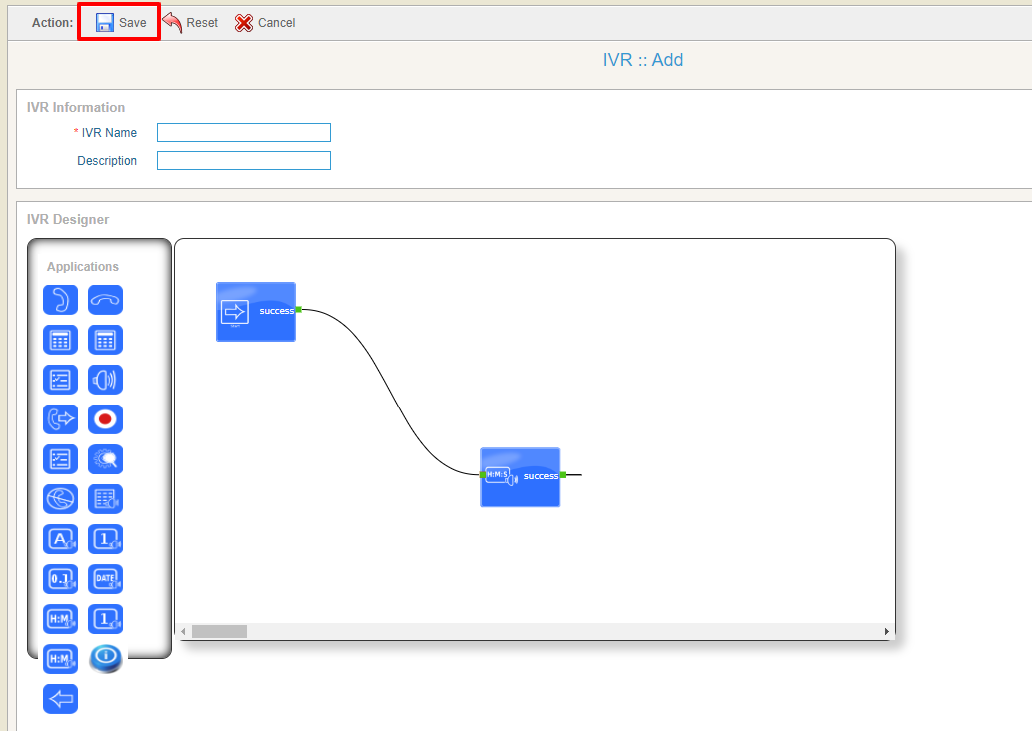
How to use DTMF Application in IVR?
- Create New IVR => Drag and drop DTMF Application to Drawing Area.
- In popup window, write the key that you want to set, and then click apply to save.
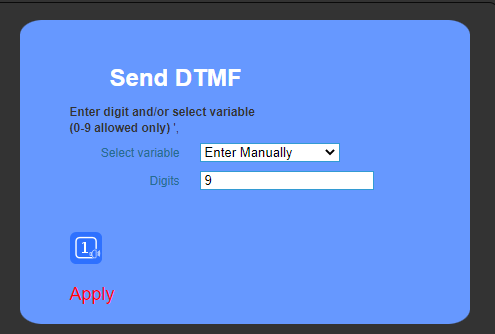
- Link start Application with the Time Condition Application by dragging and dropping “Start Application” link on the “Time Condition Application”.
- Click Save button on the page menu to save this IVR.
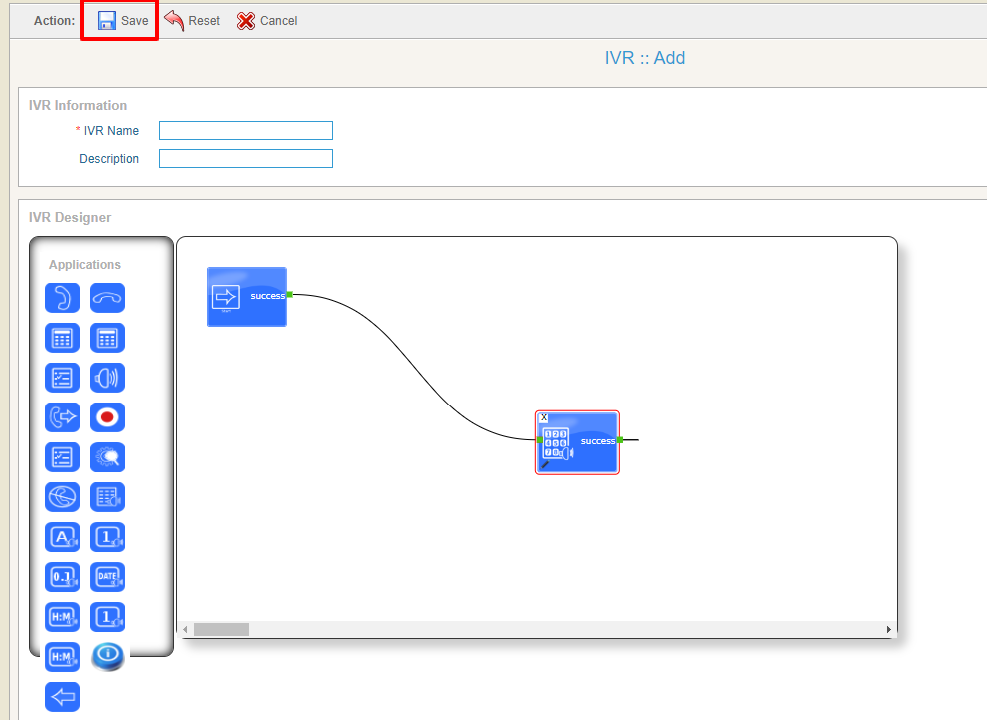
How to use Add Delay Application in IVR?
- Create New IVR => Drag and drop Add Delay Application to Drawing Area.
- In popup window, write the seconds which you want to set, and then click apply to save.
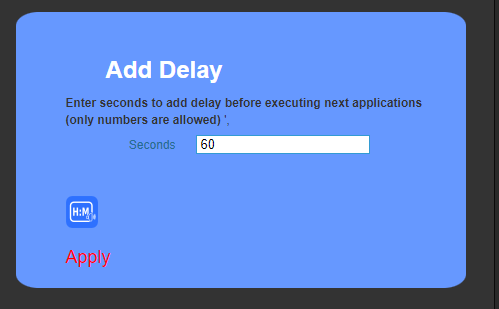
- Link start Application with the Add Delay Application by dragging and dropping “Start Application” link on the “Add Delay Application”.
- Click Save button on the page menu to save this IVR.
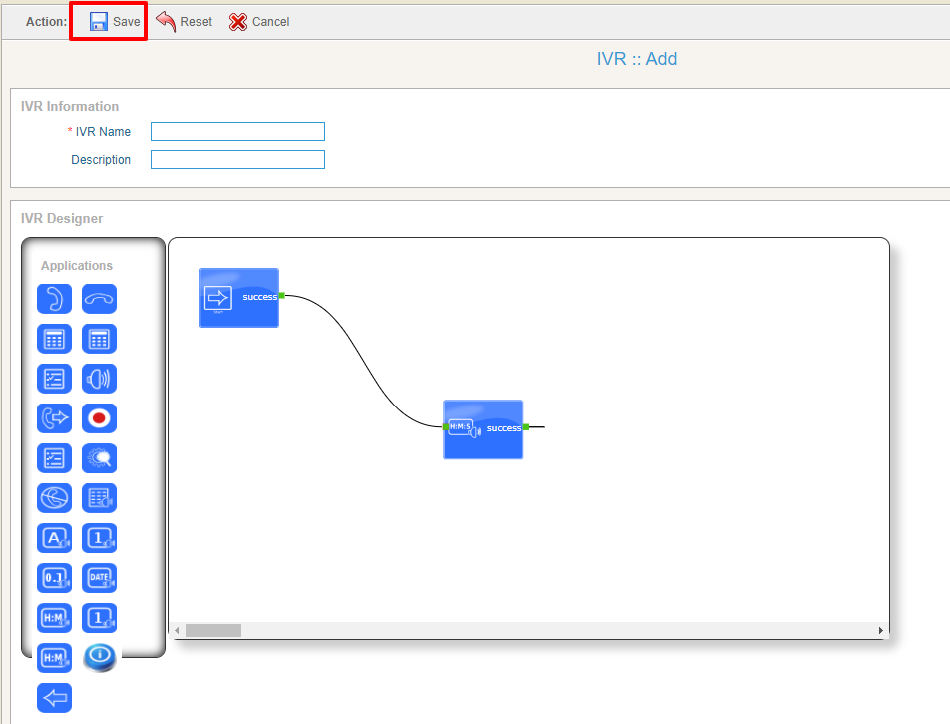

How to use Integrating API Application in IVR?
- Create New IVR => Drag and drop Integrating API Application to Drawing Area.
- In popup window, select the integration which is required from drop-down list, and then click apply to save.
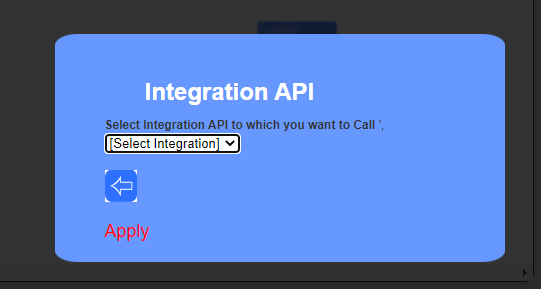
- Link start Application with the Application by dragging and dropping “Start Application” link on the “Add Delay Application”.
- Click Save button on the page menu to save this IVR.
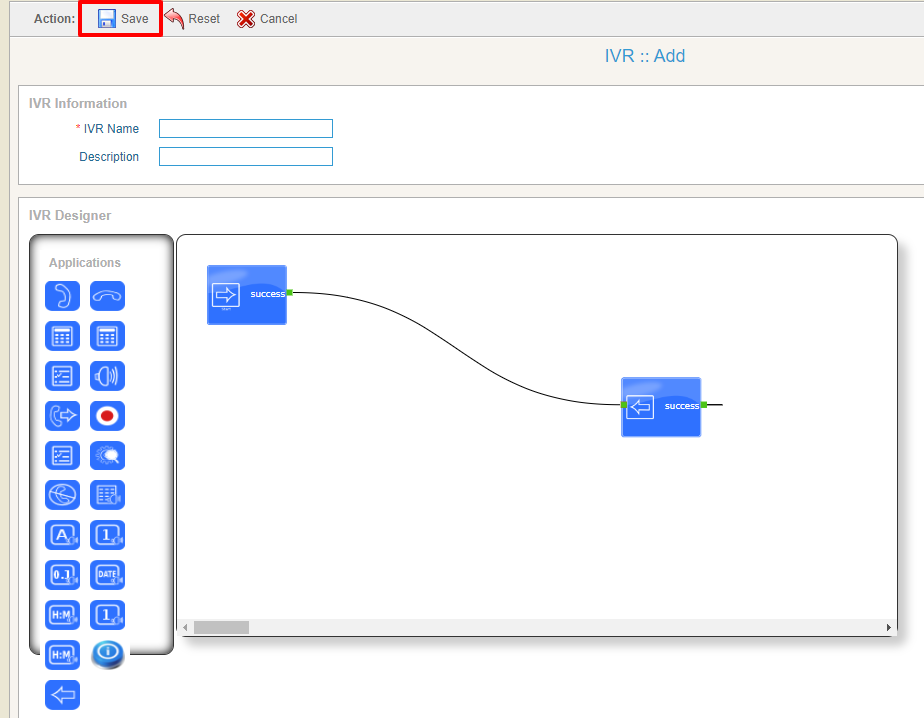
VI) Integrations:
ICTBroadcast allows to create integration. When admin dials the number of contact list, on an answer by the recipient, asks a set of questions by playing voice messages and then records their responses (DTMF key or Voice response) from recipient and prepares the report for further analysis.
In integration, admin can create choice-based questions that require the call recipient to respond using the key press DTMF function, as well as open-ended questions that require the call recipient to record their message. These recorded voice responses (or feedback) are shown in a list of voice responses in the integration report. When the user selects it, it will open a form that lists all the options and settings like integration name, type description and operations.
For Creating New Integration:
Go to messages from the main menu, then go to integrations from the submenu.
Go to the new integration button and press it.

It will show a form as shown in the below figure.
Fill the form with require fields like:
a) Integration Info:
Write Integration Name in the field box.
Select integration group from the drop-down list.
Write the description in the description box.
b) Integration Configuration:
Write remote URL in the field box.
Select the https method by drop down list.
Write data request in the field box.
Write headers’ request on the field box.
Select encoding by drop down list.
Click on the save button to save it.
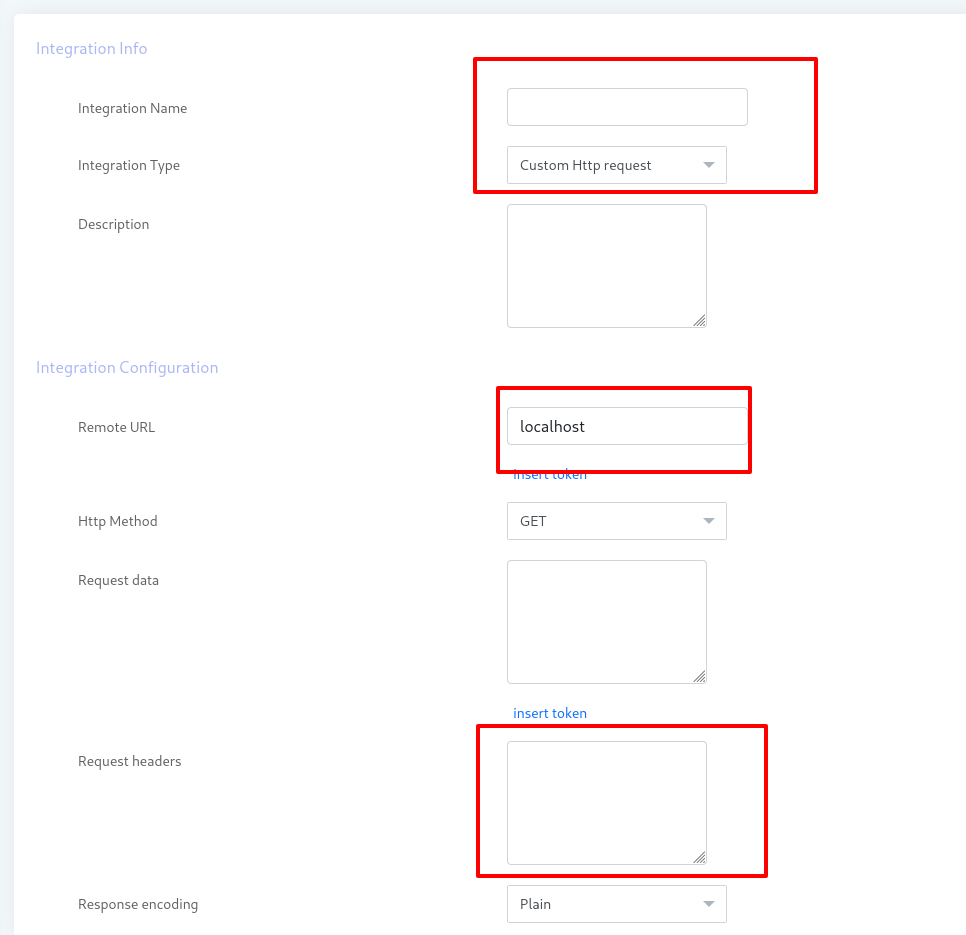
VII) Message Designer:
ICTBroadcast provides the message designer option. It has many applications like (Play audio, TTS, Say alpha, Say digit, Say number, Say date, Say time and Confirm Reminder) same as IVR.
For Creating New IVR Message:
Go to messages from the main menu, then select the message designer from the sub menu.
It will show a list of IVR messages with different name and descriptions.
New IVR Message:
Click on New IVR Message. It will show an interface as shown in the below figure:
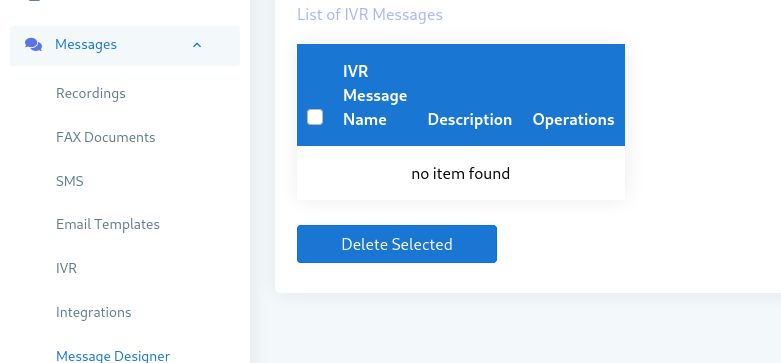
Fill the require fields like:
Information:
Write message name in the field box.
Write some description about it.
New Application:
Select application from the drop-down list which is required.
Click on the save button to save it.
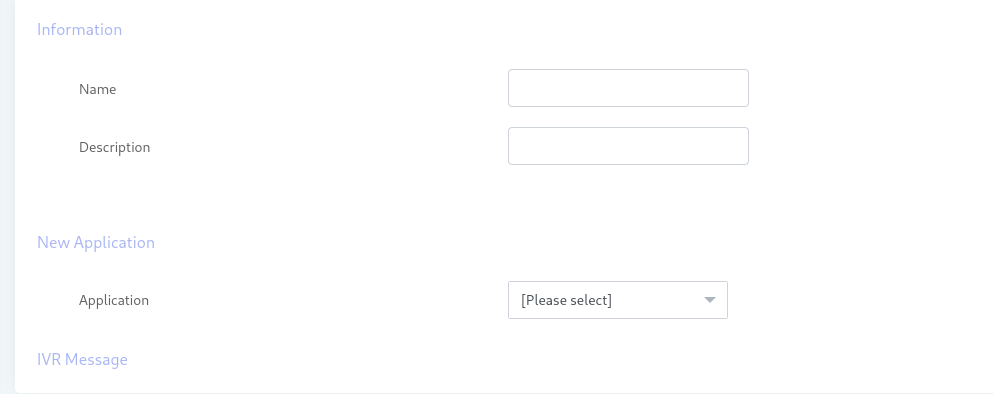
VIII) Dialogue/ Scripts:
ICTBroadcast provides dialogue/Scripts option, here you can write a dialogue or scripts.
Go to messages from the main menu => Press Dialogue/Scripts from the sub-menu.
It will open an interface as shown in the below figure:

For writing New Dialogue/ Scripts:
Click on New Dialogue Button, it will show a form with some fields like:
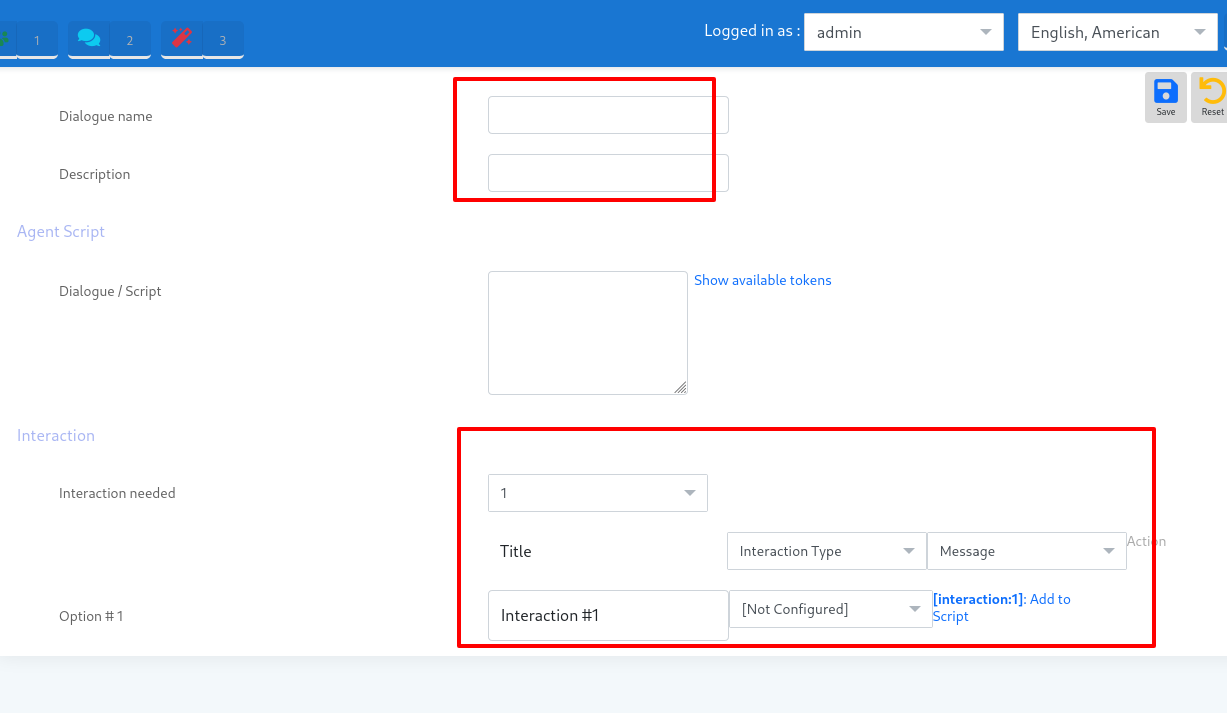
Dialogue:
Write a dialogue name in the field box.
Write some description in the field box.
Agent Script:
Write dialogue/ script in the require box.
Interaction:
Select needed interaction in the drop-down list.
Select option 1, write Interaction #1, select integration type from the drop-down list.
Click on [Interaction #]: Add to script,
[Interaction #2], [Interaction #3], [Interaction # 4],
If you want to add any one of it in the agent script box.
Click on the save button to save it.
IX) Disposition:
ICTBroadcast provides an option to reschedule call times. In case of recipient, do not take a call/busy. Agent can reschedule the call from the disposition. It enters after any call completion.
Go to messages from the main menu, then select disposition from the sub menu.
It will open an interface as shown in the below figure.
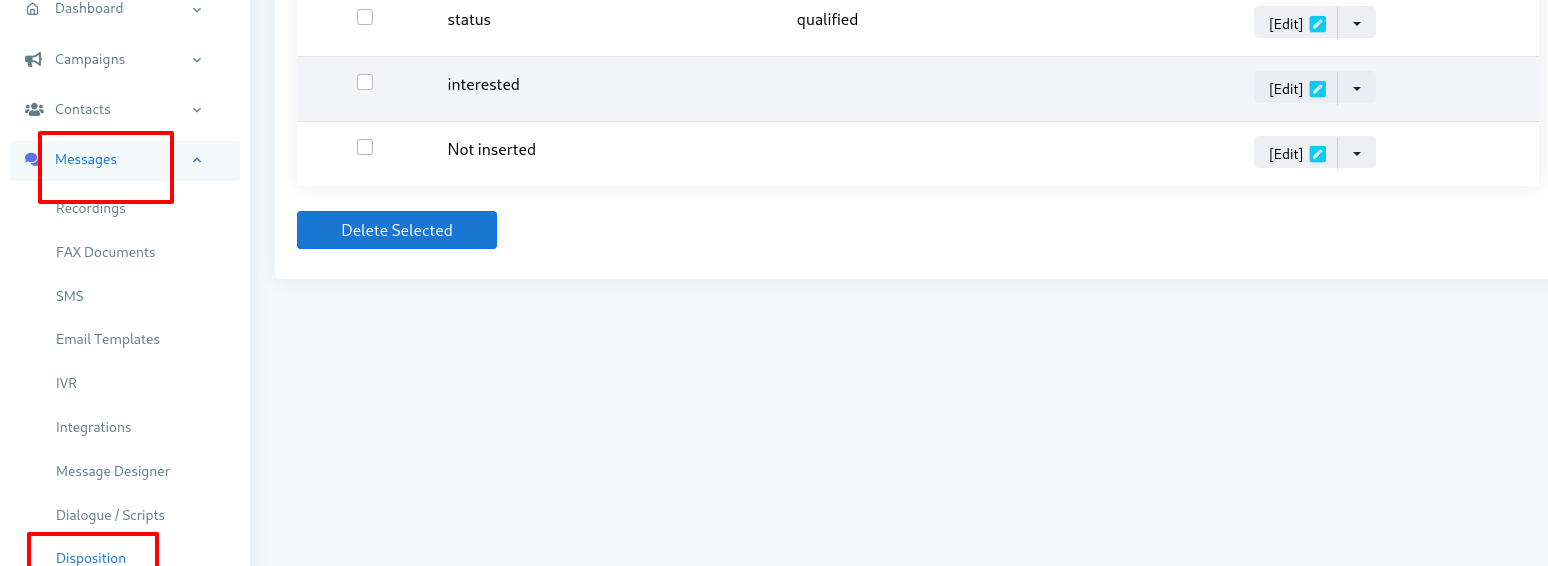
For creating New Disposition:
Click on the new Disposition button, it will show a form as shown in the below figure:
Fill the form with the require field:
Disposition:
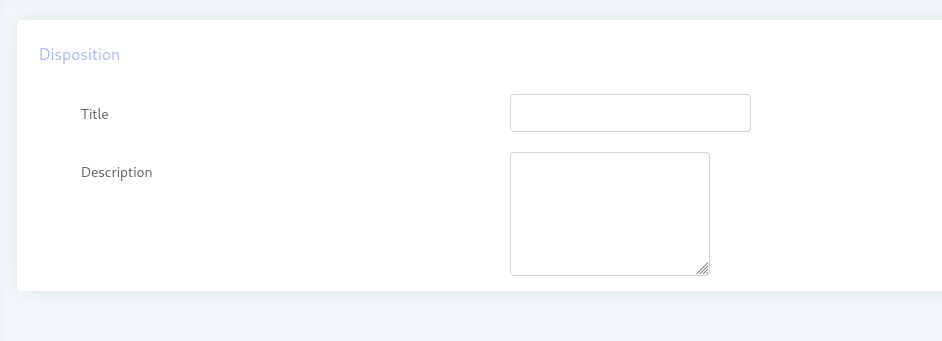
Write the title in the require box.
Write some description about it.
Click on the save button to save it.
10. Administration:
ICTBroadcast Service Provider edition has four basic user roles i.e., Administrator, Client, User and agent. Administrator has all the privileges whereas user, client or agent has some restrictions which include user management, trunks management, Extensions, DIDs, regions, countries and destination management, etc.
I) User Management:
Following form shows User Management area for Administrator. Administrator can manage user and assign resources to users like Assign Extensions and Assign DIDs.

Add User:
To add new user, go to administration from the main menu, click on user management from the sub menu.
Then click on new user, it will open a form which is shown in the below figure.
Fill the form with require fields:
i) User:
Write user name in the field box.
ii) Password:
Write password in the field box.
Rewrite password.
iii) Personal contact info:
Write personal information in the field’s boxes.
Type “E-mail”.
Type “First Name”
Type “Last Name”
Type “Phone Number”
Type “Address”
Select “Country” from the drop-down list.
iv) Local setting:
Select Time zone from the drop-down list.
Select Language and theme from the drop-down list.

For creating new client as a user role, you can add it by drop down list which are shown in owned by title in the below figure.
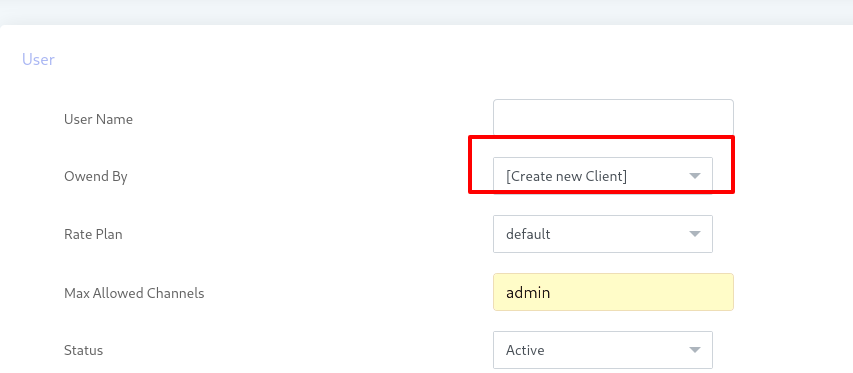
User select owner or create new client during creation. And the user can use all its resources.
a) Assign Resources:
Administrator can assign resources to the user. Resources include ‘Timeslot’ and ‘Weekday’ to run campaigns. User will only run the campaign in the allotted time range and weekdays. As soon as the range is crossed, the running campaigns are stopped immediately. In “Allowed Time Slot to run campaign” section client select time range. Campaign dial contact in selected range. In “Allowed Weekdays” section, client select days. In “Permission” section client set our permission.
Administrator can also set the permissions for using Fax, Survey and Interactive campaigns.

b) Assign Extensions:
Administrator can assign extensions to the user.

c) Assign DIDs:
Administrator can assign DID to the user.
II) Client Management:
Following form shows Client Management area in Administration. Administrator can manage clients. All the existing clients’ lists are available here. In Clients Management, all the information about clients is here. Admin can make new clients here.

For Creating new clients:
Go to Administration from the main menu, then go to client management from the sub menu.
Click on the new client button for creating a new client. It will show a form like this:
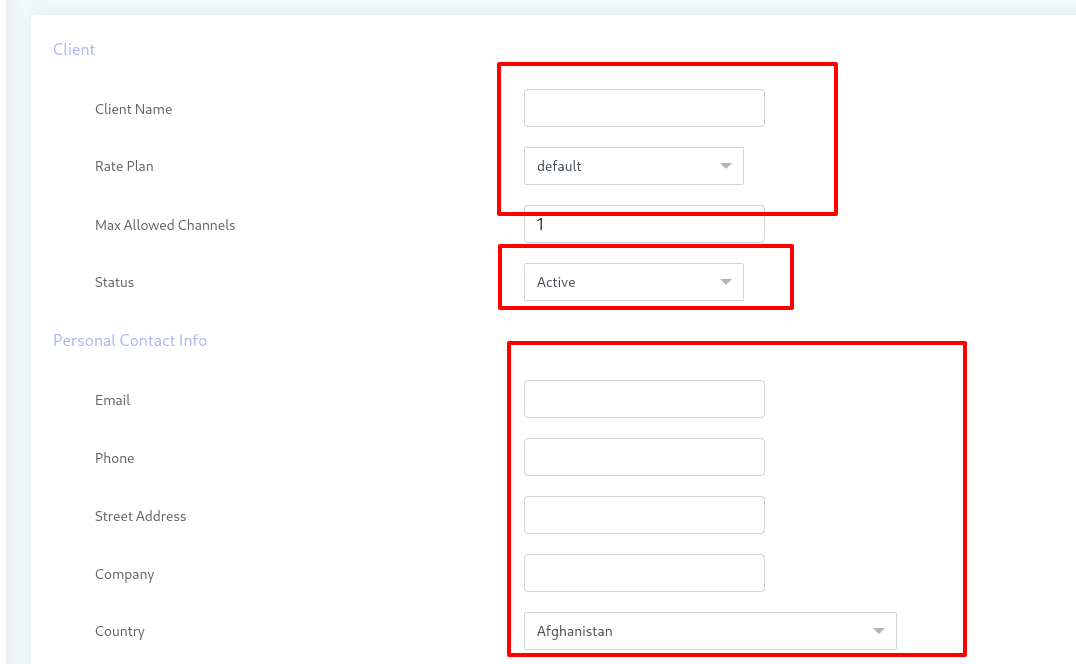
Fill the form with require fields:
Client:
Write client’s name in the field box.
Select rate plan from the drop-down list.
Write maximum allowed channel manually.
Select active status from the drop-down list.
Personal Contact Info :
Write “E-mail”
Write “Phone number”
Write “Address”
Write “Company Name”
Select “Country” from the drop-down list.
Local Setting:
Select Time zone from the drop-down list.
Select language from the drop-down list.
Select Theme from the drop-down list.
Click on the save button to save it.
III) Agent/Extensions:
Agent/Extensions form allows the user to enter extension name, password, SIP or IAX protocol, and forwarding. This setting is required for Agent Campaigns or Interactive Campaigns. User can forward any extension to external call center or IVR System.
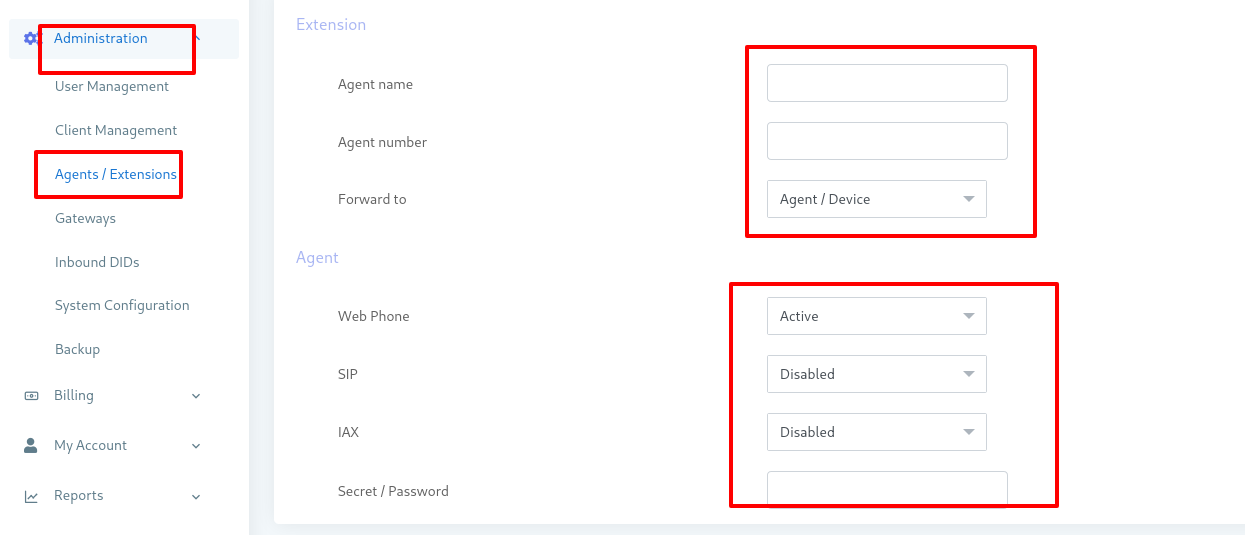
IV) Gateways:
Service Provider/Trunks is basically a call termination point. A trunk is an interface that enables users to connect with interested recipients using VOIP or PSTN networks. So, the user will provide trunk details here.
Trunk:
Trunk Name: Name of the trunk.
Type: Inbound, Outbound, or Inbound and Outbound both.
Status: Active or disabled.
Weight: Weight sets priority in trunk. Lower values of trunks will be preferred by others while doing route selection.
Node: Select the type of nodes.
Technical Information:
Gateway type: Asterisk for Voice/Fax, Kannel for SMS, and Swift Mail for Email.
Outbound configuration:
CPS limit: Select the limit.
Max Channel Capacity: Number of maximum channels allowed.
Dial Prefix: If any prefix is required by this trunk.
Caller ID:
Caller ID Format: Select the Format Caller ID.
Title Format:
Select the Title.
Trunk Configuration:
Protocol Type: IAX or SIP.
Register String: Only if asked or required by trunk.
Setting: Type, host, user and password for connecting to this trunk.
Dial String(default):
SIP dial string: SIP/%phone/%trunk
IAX dial string: IAX/username/%trunk/%phone
Kannel dial string: to=%phone&smsc=%trunk
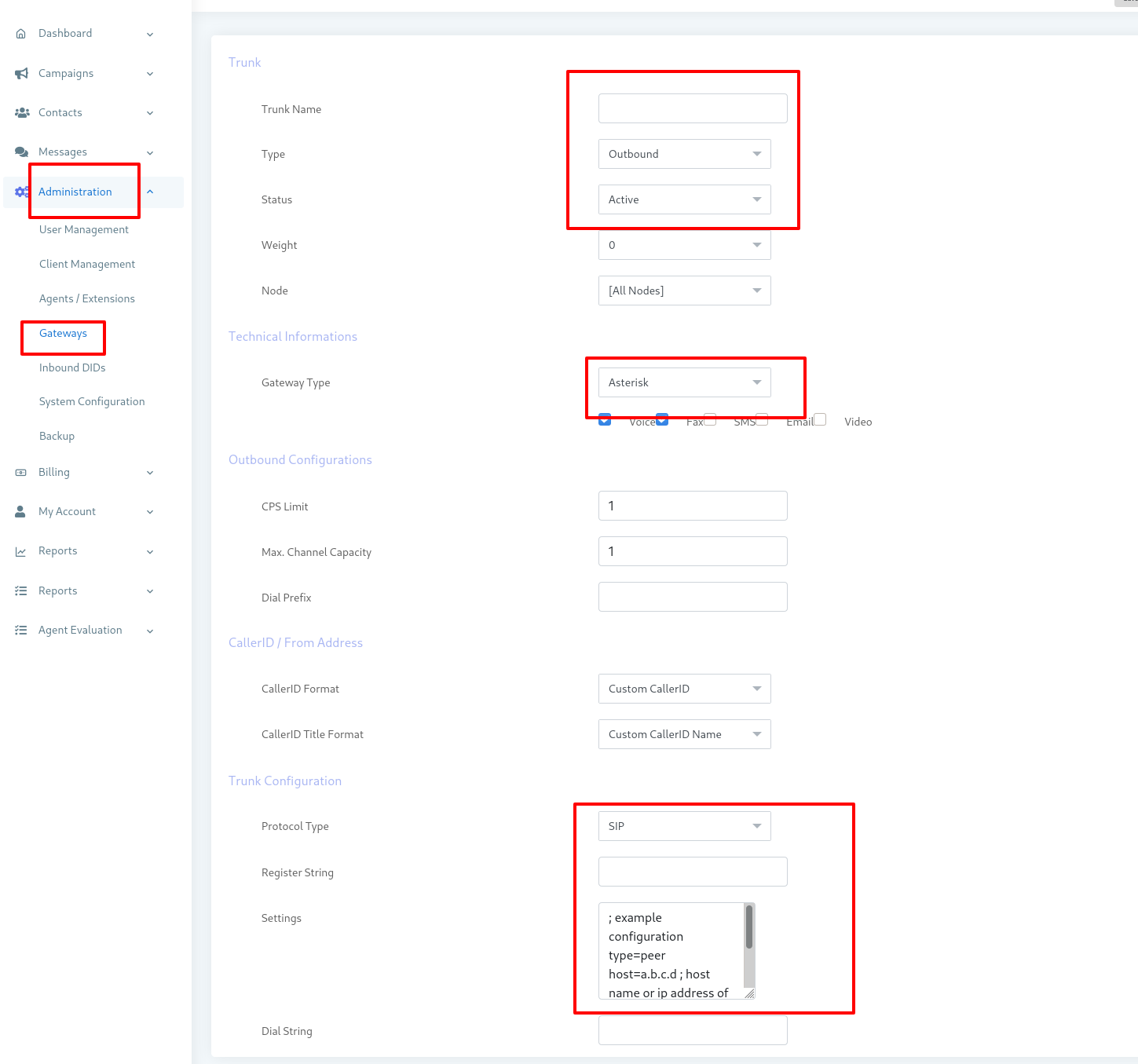
a) Voice Trunk Configuration:
In this section, sample trunk configurations and settings are provided that should make it easier for the non-technical users to set up its gateways.
Following are the sample trunk configurations to set up a voice gateway.
Protocol Type:
SIP (for IAX you might need different settings)
Register string:
username:
Settings:
host=hostname. Or ip username=username secret=password
Any further asterisk related settings as per your provider requirement:
Dial String:
SIP/%phone@%trunk (for IAX: IAX2/%trunk/%phone)
b) Fax Trunk Configuration:
Following are the sample trunk configurations to set up a fax gateway.
Protocol Type:
SIP (for IAX you might need different settings)
Register string:
username: password@hostname.or.ip
Settings: host=hostname. Or. ip username=username secret=password
For fax, following parameters can be used to improve quality
allow=alaw, ulaw t38pt_udptl=yes
Any further asterisk related settings as per your provider requirement
Dial String:
SIP/%phone@%trunk (for IAX: IAX2/%trunk/%phone)
c) SMS Trunk Configuration:
Following are the sample trunk configurations to set up an SMS gateway.
Settings:
smsc = smpp host = hostname.com
port = 9000 transceiver-mode = yes
smsc-username = USERNAME
smsc-password = PASSWORD
max-pending-submits = 10 system-type = VMA
Any further Kannel related settings as per your provider requirement
Dial String:
to=%phone&smsc=%trunk
d) Email Trunk Configuration:
Following are the sample trunk configurations to set up an email gateway.
There are three different settings an email gateway can be setup i.e., send mail, smtp and mail as given below.
Write any one of these in the settings field while creating a trunk.
Send mail settings:
Type = send mail command = /usr/sbin/send mail -bs
SMTP Settings:
type = smtp host = hostname.com port = 25 encryption = tls # or ssl username = usee@domain.mail
password = PASSWORD
Mail Settings: type=mail
Steps to create Trunks:
- Administration => Gateway => New Trunk.
2. Fill the new trunk form:
a) Trunk Name
b) Type: outbound, inbound or both
c) Status: Active or Disabled
d) Weight: -10 to 10. Trunk with low weight has a high priority.
e) Gateway Type: Asterisk / Kannel / Swift Maler.
f) Cps (call per second) limit.
g) Max channel capacity.
h) Protocol Type: Sip / IAX.
V) Inbound DIDs:
DID number is the number that caller will dial and the system will receive that call?
Following form allows the user to enter DID number, its description, and the DID application that is selected to “Assigned to “.
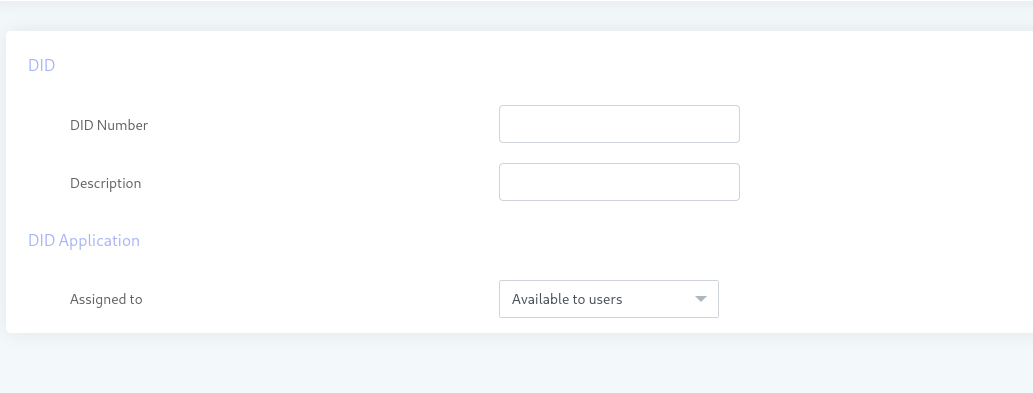
VI) System Configuration:
This is the main configuration options area for the ICTBroadcast system. Admin can change these options. Some of these options are application specific and don’t need to change too often, e.g., Database, Asterisk and Kannel.
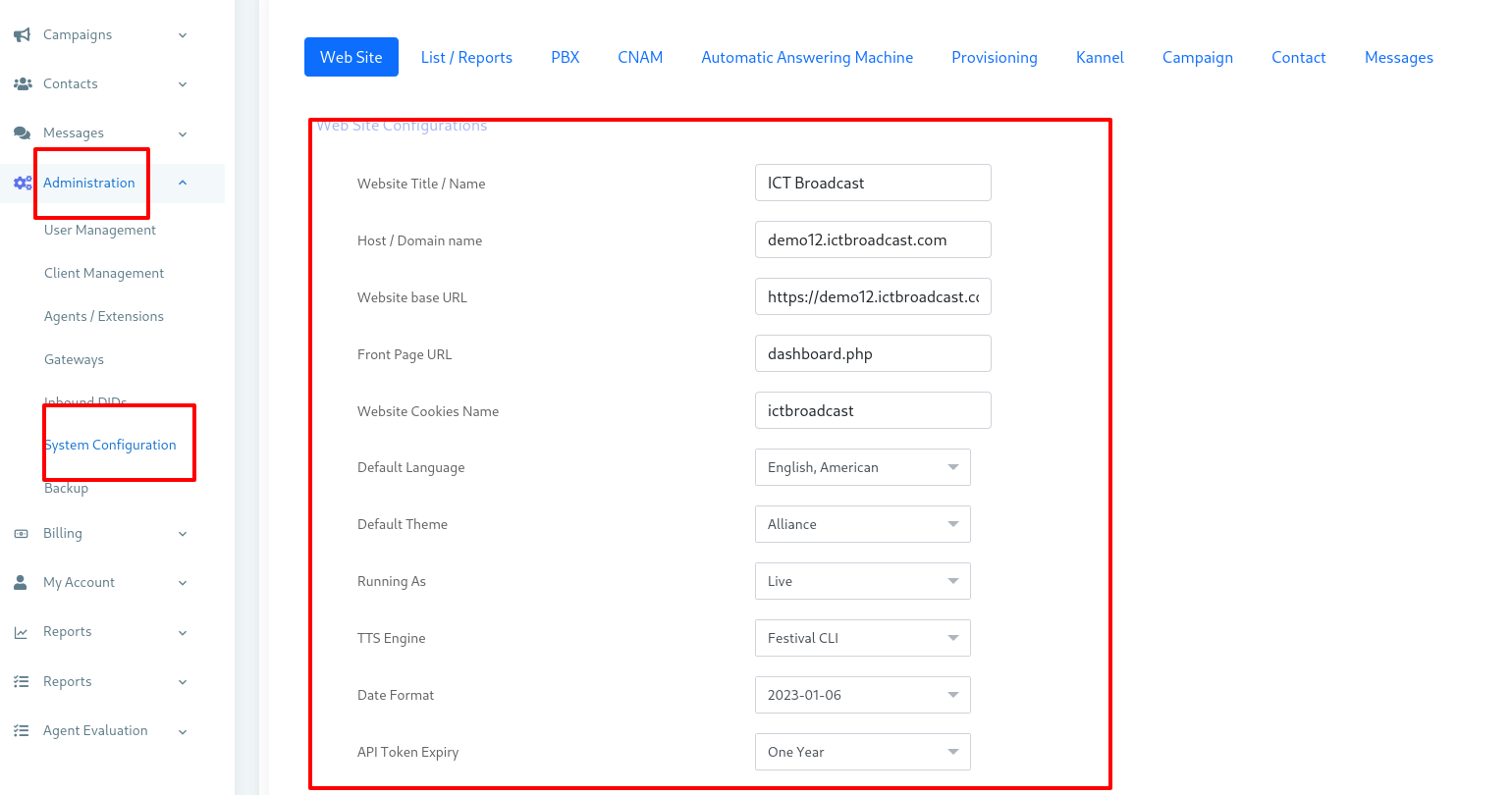
Following is a brief description and usage of each of these options:
Web Site:
It allows admin to change various options related to the Web site URLs and appearance.
a) Website Title allows to set custom title of ICTBroadcast.
b) Domain Name allows to set custom host/domain name. This option creates a link at the title/logo of ICTBroadcast header.
c) Website base URL tells where on the web server ICTBroadcast can be located (directory path at the web server).
d) Front page URL allows to set custom first page title. It can be helpful to redirect user to some custom page.
e) Website cookie Name is the cookie (temporary text file) that is stored in the client machine.
f) Default Language allows to set default language for ICTBroadcast system.
g) Running As tells the status of the ICTBroadcast system whether it is demo or live.
h) TTS engine, select the type.
List/Reports:
Set options to display lists and reports.
a) Items per page: Items to display in a list at a time (pagination).
b) Amount Precision: Display amount (currency) digits of precision.
Asterisk:
It tells the configuration options for connecting to the asterisk server.
a) AMI Host: IP address (alias) where the database is hosted.
b) AMI Port: Port of the database to connect to.
c) AMI Username: Name of the user to connect to asterisk.
d) AMI Password: Password of the above user to connect to asterisk.
e) TTS engine selects the type.
f) Monitor QoS_As enabled or disabled.
Kannel:
It tells the configuration options for connecting to the Kannel server.
a) Kannel Host: IP address (alias) where kannel is hosted.
b) Kannel Port: Port of the database to connect to.
c) Kannel Username: Name of the database user to connect to kannel.
d) Kannel Password: Password of the above user to connect to kannel.
e) URL path for send SMS: Path to the send SMS library of Kannel.
f) Kannel Message Size: Size of the Kannel message.
Campaign:
It allows to configure global options for all the campaigns.
a) Maximum Survey question: Maximum number of questions allowed in per survey campaign.
b) Maximum Subscription offers: Maximum number of offers allowed in per Subscription campaign.
c) Default Caller ID: Sets default caller id for outbound campaigns. Admin can set any value here and it will be used as global caller id. Admin can also use tokens (variables) here, such as [campaign: caller id]. It tells the system to use caller id set by individual campaign.
d) Default Caller ID Name: Set default caller id title for outbound campaigns. Similar to the above, admin can use any value or token ([campaign: caller id name]) in this field.
e) Caller ID on Transfer: Set caller id on transfer. For example, when a call is transferred to a call center / Agents. Admin can use [contact: phone] or [call: contact] to show call recipient’s phone number when they are transferred to agents.
f) Keypress Timeout: Maximum time to wait for the user to allow him to press his desired key.
g) Channel Incremental: Per step channel incremental while increasing or decreasing channels through running campaigns.
h) DNC Key: Call recipient will have to press this key on his dial pad to add his number to DNC.
i) Global DNC: If enabled, then contact will be checked again.
j) Message Replay Key: Call recipient will have to press this key on his dial pad when he wants to receive the current IVR message.
k) Auto Message Replay: If the call recipient fails to reply, then automatically repeat IVR message.
l) Max Message Replay: After this number of repeats tries current IVR message will be skipped.
m) Block Cell: Select the number to disable or enable.
n) Channel per Campaign: Maximum number of channels for each campaign.
o) Max Allowed Call Retries: Set maximum number of calls retries option. If set to disabled, then Max Retries option will not be displayed on campaign form.
p) Repeat Contacts: Set how contact will be repeated to dial. Whether to repeat all contacts or just repeat those which are marked as fail on previous attempt.
q) Call monitoring: Number of calls monitoring messages:
Invalid message recording: Please select a recorded message, which will be played when the user failed to enter a valid option.
Enforce email footer: If enabled, each user will be enforced to include a predefined email footer in each outgoing email.
APIs: It sets the configurations related to APIs.
a) Security Key: Security key for connecting to the ICTBroadcast API services.
User Portal: It sets configuration options for the user portal
a) User Portal: Enable or disable user portal.
b) API URL: Sets URL for the API services
c) Account URL: Sets user account URL
d) Login URL: Sets Login URL:
e) Logout URL: Sets Logout URL:
VII) Backup:
ICTBroadcast provides backup options. Here you can take backup of your data. All the
data will be recovered with the help of this option.
Go to administration from the main menu, click on the backup button from the sub menu.
It will show an interface like this.
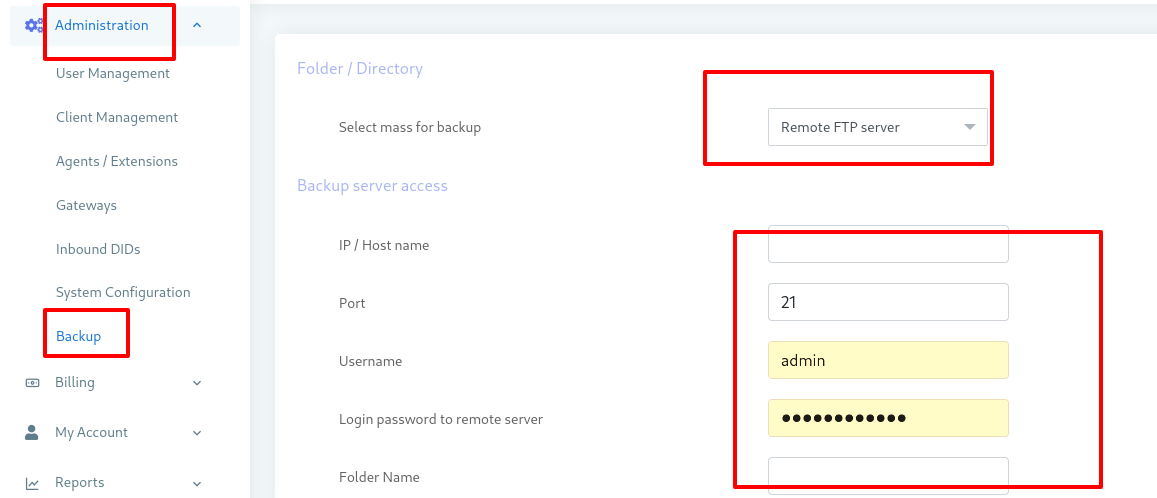
Fill the form with require fields:
Folder/Directory:
Select folder or directory from the drop-down list.
Backup Server Access:
Write “IP/ Host name” in the field box.
Write “Port number” in the require field box.
Write “Username”.
Enter “Password”.
Write “Folder Name” in the field box.
11. Billing
ICTBroadcast Service Provider edition provides a complete Billing package. Administrator has all the privileges to add regions, countries, destinations, routes, rates and payments.
I) Regions :
Regions are continents and some part of the continent. e.g., Eastern Europe, Central Asia, etc.
- To add a new Regions click on “Regions” on sub menu bar.
- Click on “New Region” to add a new region.
- Enter “Region Code” (any unique alphanumeric).
- Enter “Region name”.
- Click on “Save” button at top.

II) Countries :
- To add new Country click on “Countries” on sub menu bar
- Click on “New Country” to add a new region.
- Enter Country Name.
- Enter Country Code (Any unique identified)
- Enter Country Dialing Code. This will be a comma separated list of all dialing codes to that country, e.g., UK can have 44 or 44,442 etc.
- Select Region
- Select Time zone
- Click on “Save” button at top.

How to create local prefixes?
By default, ICTBroadcast is configured in international prefix format. If admin decide to use ICTBroadcast only for local destination and want to avoid extra (international prefix) digits, then admin can use following instruction to set up local or custom prefix system.
Clean all Existing Settings
- Remove all routes.
- Remove all rates.
- Remove all destinations.
- Remove all countries.
Setup Custom Prefix System
- Create a new country for which you want to create local prefixes.
- Provide all prefixes unique to that country in a comma separated list under “Country Dialing Code” field like “1204,1250,1289” for Canada or “923,92” for Pakistan.
- Create required destinations.
- Create rates.
- Create routes.
NOTE:
While creating a destination please make sure that initial digit of the prefix can match with some “Country Dialing Code” in a country like “Pakistan Mobilink” destination has “92300” then it is OK as we have “923” in “Country Dialing Code”.
III) Carriers/Destinations :
- To add new Destinations click on “Destinations” on the sub menu bar.
- Click on “New Destinations”.
- Enter Description of destination.
- Enter Prefix of destination.
- Select Carrier type from the list.
- Select Country from the list.
- Select “Time Zone” from list.
- Click on “Save” button at top.

iv) Rates :
- Click on “Rates” on sub menu bar.
- Click on “add new Rate” to add a new rate.
- Select the “Rate Plan”.
- Select “Services”.
- Select Billing Block (Mostly 60 seconds billing block is used).
- Enter Rate for given billing block.
- Select First interval (If call duration is less than the first interval, call charges will be made according to first interval).
- Select Increment interval (If call duration is greater than the first interval, call charges for extra time will be charged accordingly).
- Select Region.
- Select Country.
- Select one or multiple destinations.
- Click on the save button to save new rates.

Steps to create Rates:
- Billing => Destinations.
- Use “Add New” for adding destinations one by one. For Bulk import, use “import” option to import destinations.
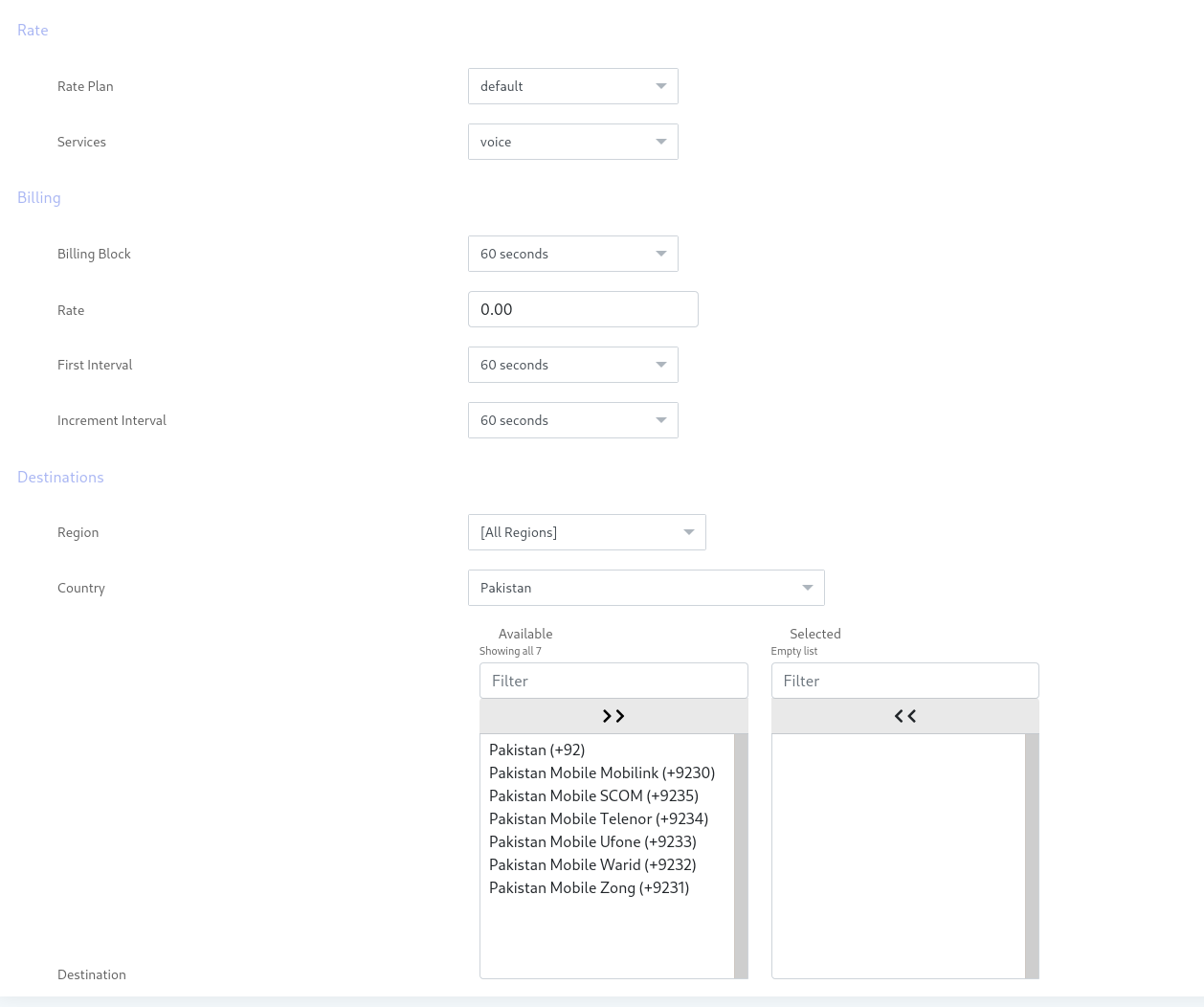
- To set rates for your destinations Navigate to billing => Rates.
- To set Rates, you can use “New Rates” option that set one rate at a time.
- To set bulk rates, use the import option. click on import, select rate plan, select service and then upload your CSV file containing rates sample. CSV is attached in the import form of ICTBroadcast.
v) Rate Plans :
- Click on “Rate Plan” on sub menu bar.
- Click on “New Rate Plan” to add a new rate.

Steps to create Rates:
- Billing => Rate Plans.
- Use “New Rate Plan” button.
- Select “Rate Plan Name”
- Type “Description’
- Select Permission Group from the drop-down list.
- Select permission from the available list of permission.
- Click on “Save” button.
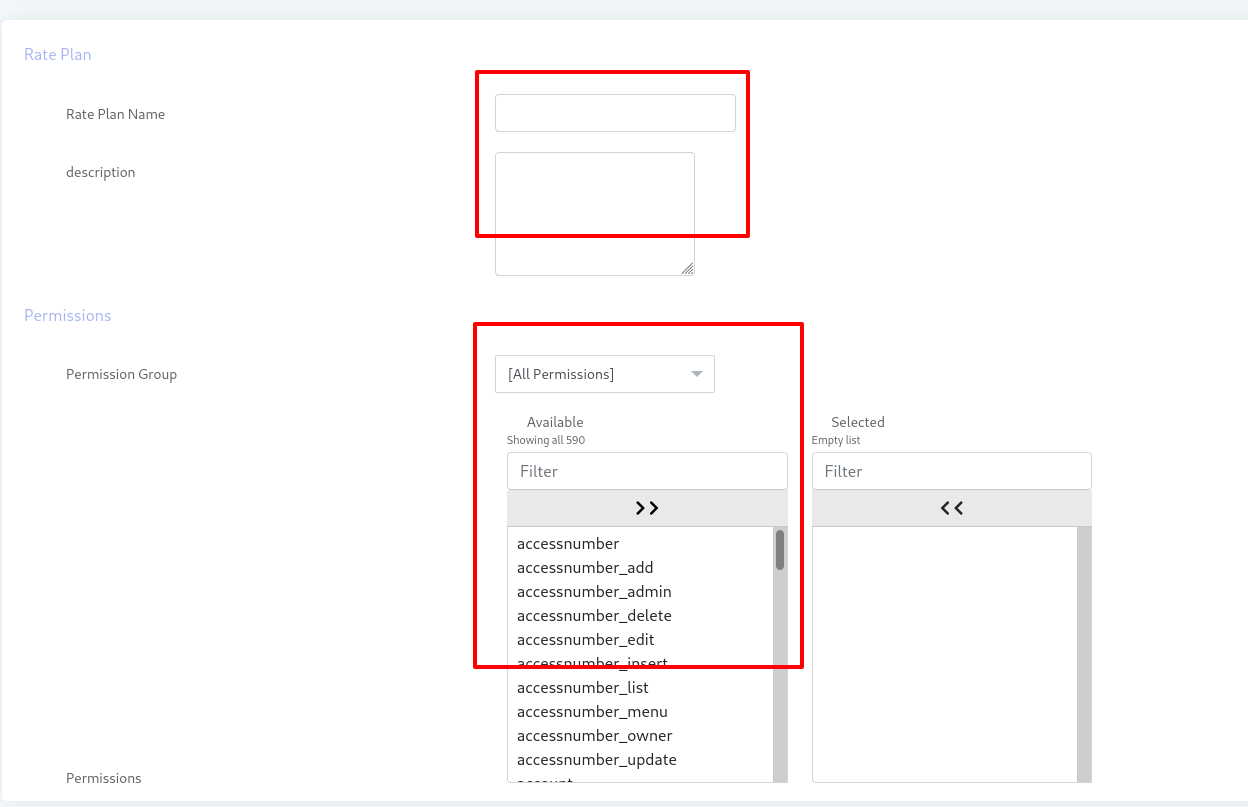
vi) Routes :
- Click on “Routes” on sub menu bar.
- Click on “add new Route” to add a new route.
- Select Service type.
- Select Trunk.
- Select Region.
- Select Country.
- Select one or multiple destinations.
- Click on save button to save new route.

Steps to create Routes:
- Billing => Destinations.
- Use “Add New” for adding destinations one by one.
For Bulk import use “import” option to import destinations.
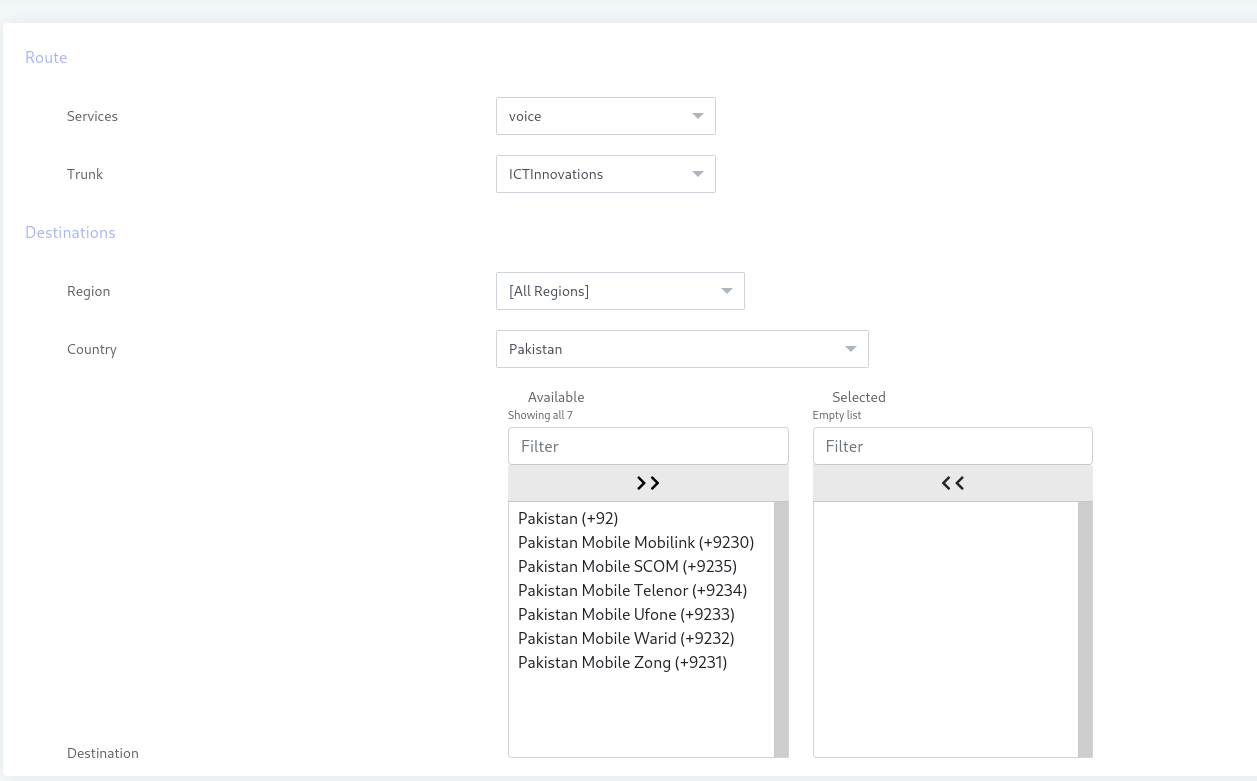
- To set routes for your destinations Navigate to billing => Routes
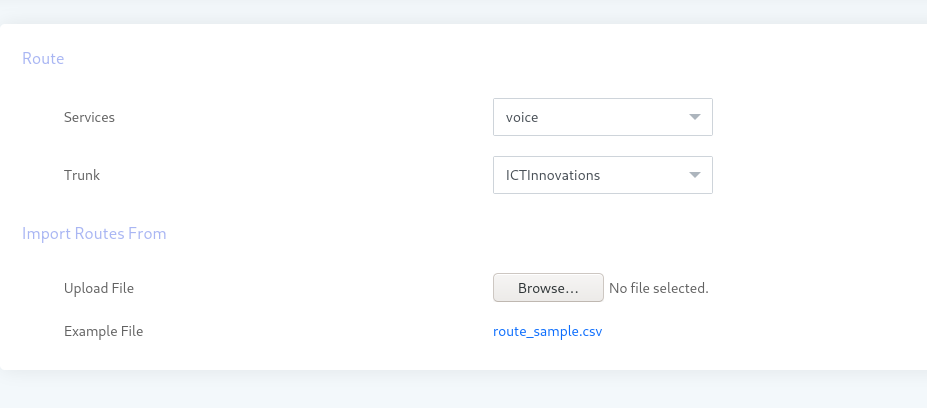
- To set routes one by one, you can use “New Route” option that sets routes one at a time.
- To set bulk routes, you can use the import option. Click import, select your service, select your desired trunk and then upload your CSV file containing destination.
How Routes Working?

vii) Payments:
- To add a new payment, click on Payments ==> Payments ==> Add a new payment.

- Paid by: Select User to top up balance.
- Comments: any comments.
- Total paid amount: Enter amount paid by the user.
- Payment type: Select payment type.
- Date: Enter payment date
- Select one or multiple destinations.
- Click on save button to save new route.
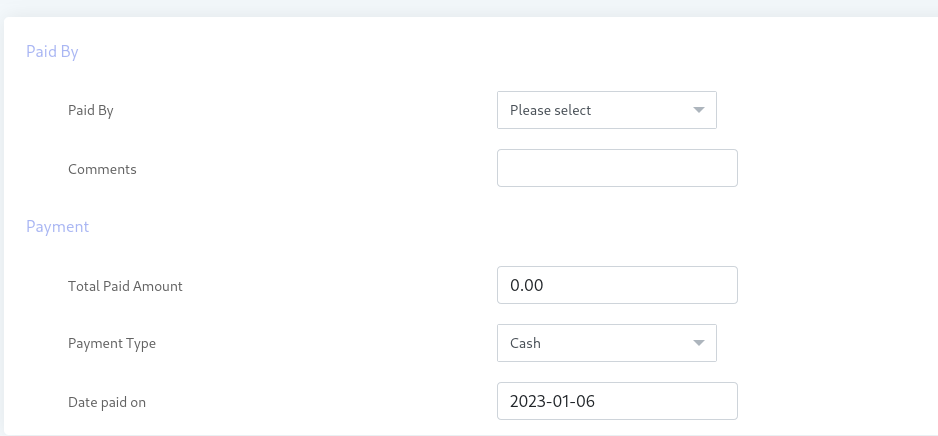
12. My Account
I) My Account:
This form provides account info, account status, personal information, contact information, and time zone settings.

II) Change Password:
User can change password in My Accounts => Change Password form as shown below. Pin code is required for phone call authentication like voice, Recording via call.

III) Payments:
User update the payment list of accounts.

IV) License Upgrade:
If a user has received our License Key, he/she can upgrade it to the system.
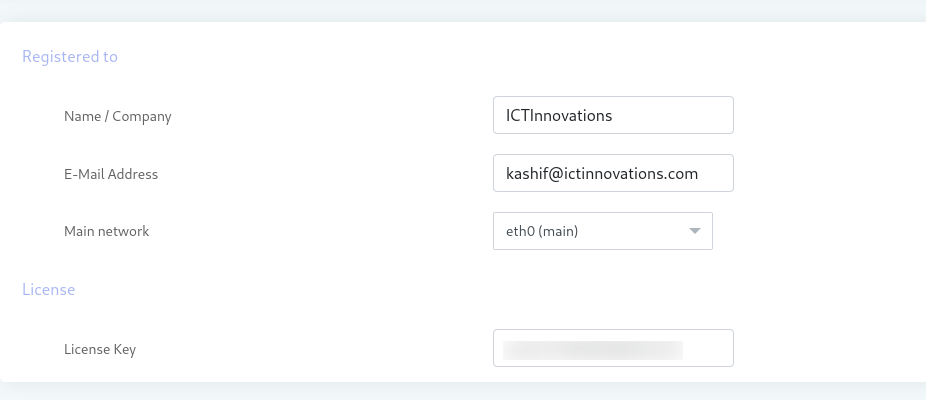
13. Reports:
I) Overview:
Here you can take all the overview about campaigns, date and time, total calls, total cost and total amount.
Go to reports from the main menu, click on overview from the sub menu.
It will show a list as shown in the below figure:

II) CDR Summary:
CDR (Call Detail Report) Summary presents the summary of each call placed on every campaign. Call Detail Report (CDR) gives you all the details about every call made during your campaign, how long it lasted, and how much it cost.
CDR lists show the list of the successful calls made. If you want to analyze and find how many calls were answered and how many calls were failed, then you’ll see Campaign Statistics.
CDR Summary provides the user a chart view of campaign status. It shows the Answered calls, Not Answered calls, failed, not called, congestion, etc.
Go to reports from the main menu, click on CDR Summary from the sub-menu.
You can print and export it.
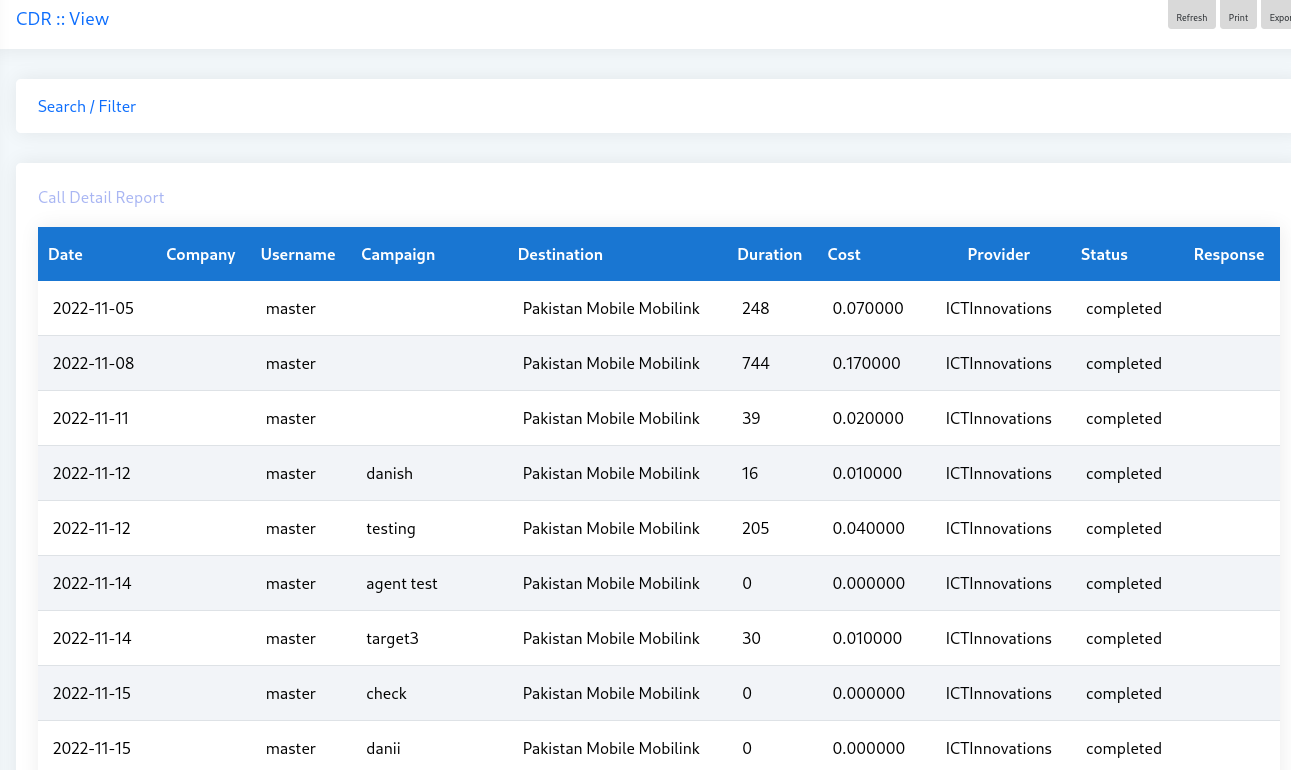
III) CDR:
Call Detail Report (CDR) gives all the details about every call placed by a campaign, how long it lasted, and how much it cost. CDR lists are the successful calls made. If you want to analyze and find how many calls answered and how many calls are failed, then you should see Campaign Summary.
Go to reports from the main menu, click on CDR from the sub menu.
It will show an interface as shown in the below figure:
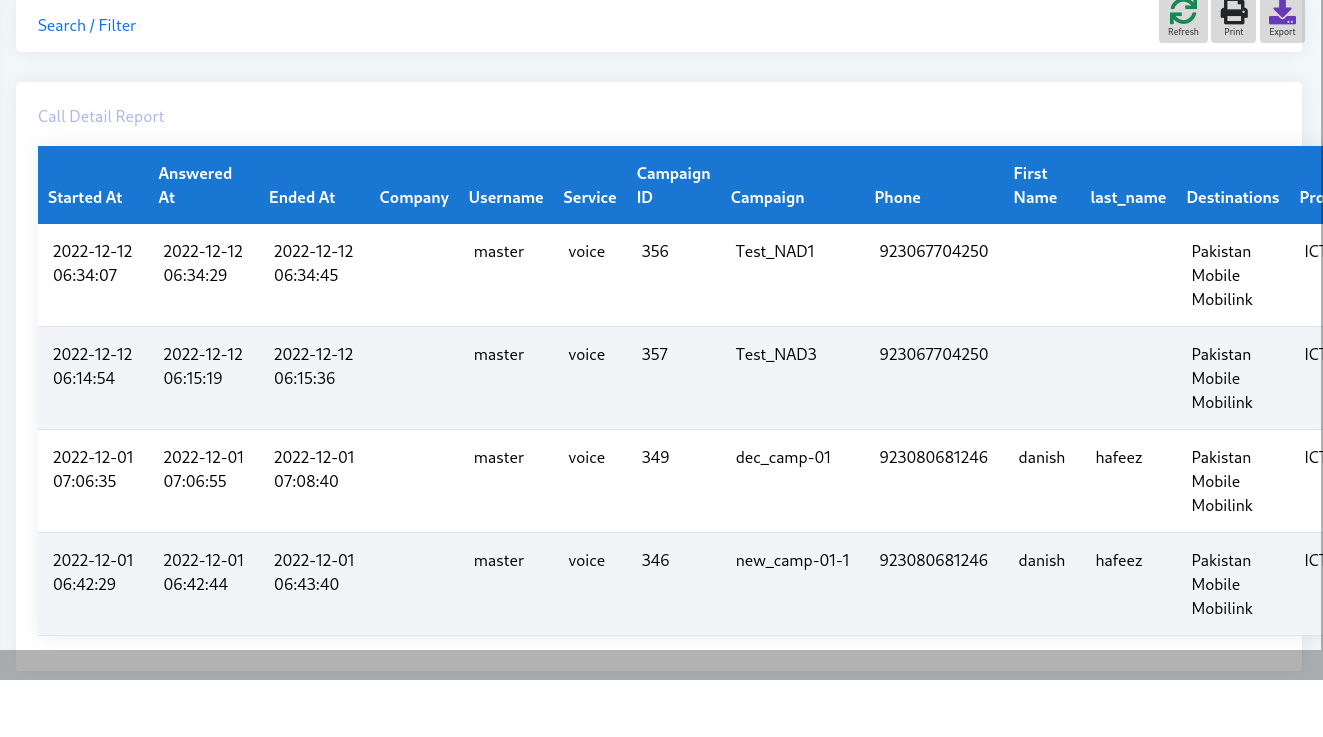
III) Transferred Call Report:
A call transfer report highlights the number of calls made or received across a direction or channel over a specified period, helping you understand the demand of your call center. The directions can be categorized as: The total number of inbound calls received. The total number of outbound calls made.

III) Abandoned Call report:
The Abandoned Calls report provides a detailed list of all calls abandoned from a queue. In this report we can check the calls that are initiated or ended without any conversation
with agents.

IV)Call Recording:
It shows lists of call recording reports.
Go to reports from the main menu, click on call recording from the sub menu.
It will show the existing call recording reports list which shows in the below figure.
Go to reports from the main menu, click on call recording from the sub menu.
It will show an interface as shown in the below figure:

V) Queue Statistics:
Queue Statistics show the list of numbers added in queue while the call was in process. It gives the information about the offline agents, ready agents, busy agent, maximum calls and the maximum wait.
Go to reports from the main menu, click on queue statistics from the sub menu.
It will show an interface as shown in the below figure:
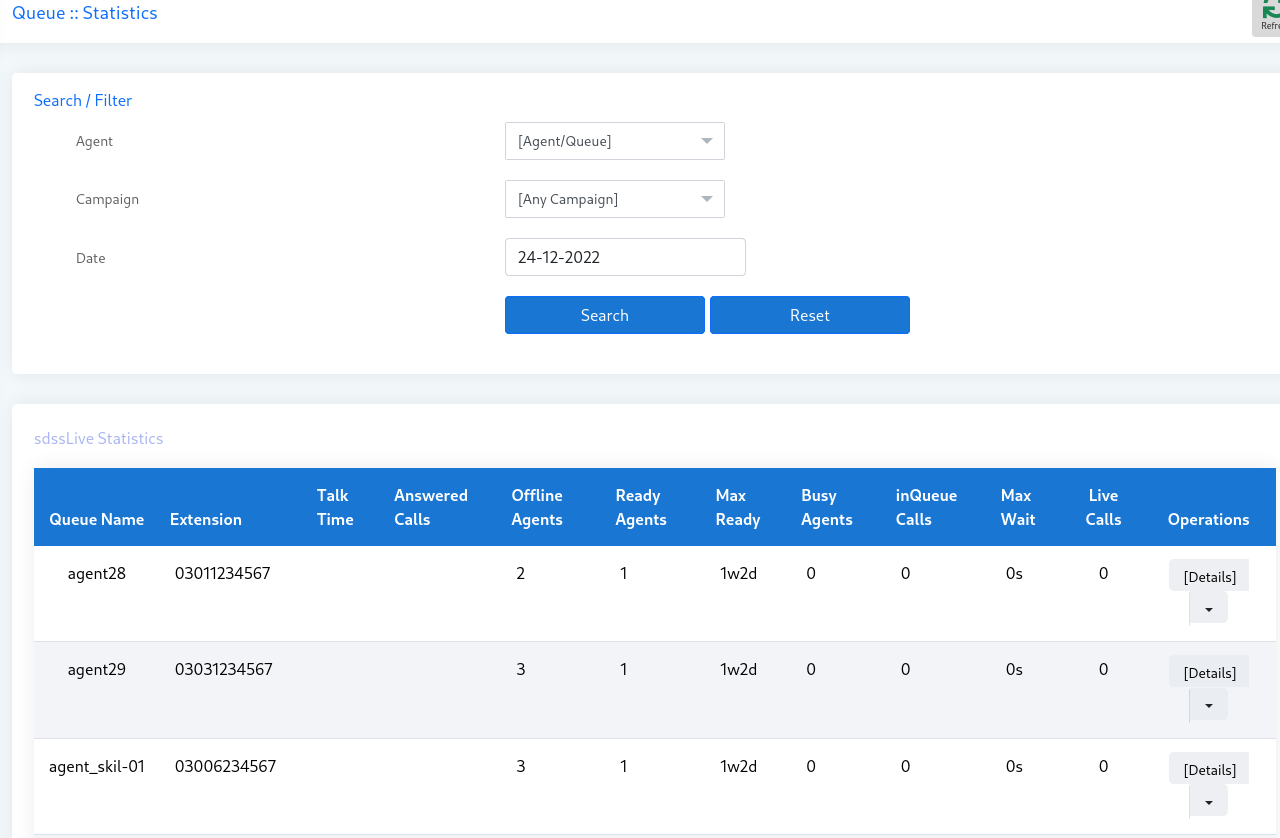
VI) Live Statistics:
Live Statistics show the information about currently processing calls. It shows the campaign, Agent, Extension, Status, Duration, time when agent logged in, for how much time the agent is login and operations.
Go to reports from the main menu, Click on Live statistics from the sub menu.
It will show an interface as shown in the below figure:
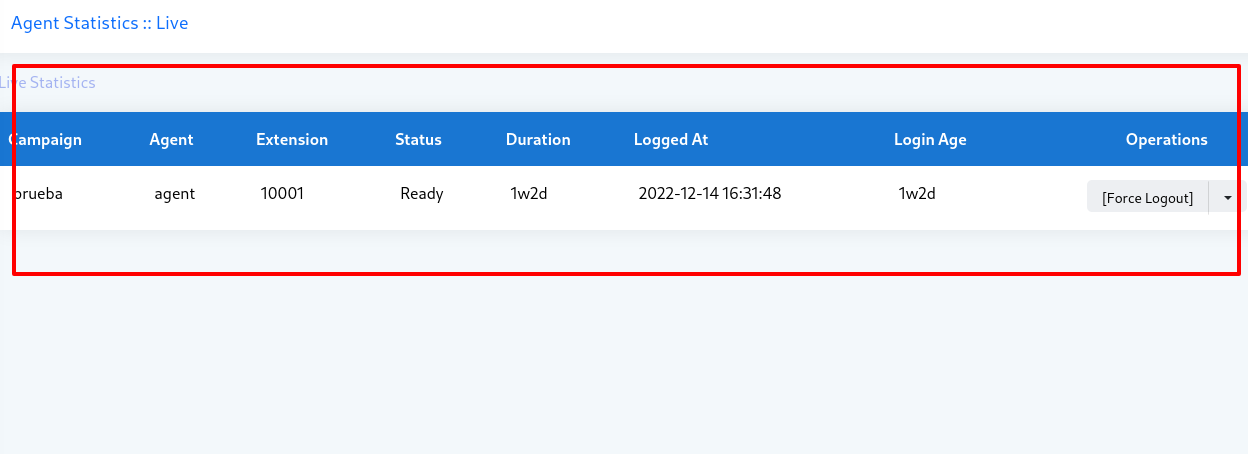
VII) Agent Statistics:
Agent Statistics show the overall summary of each agent. It shows the agent login time, logout time, the time that agent takes to answer the calls and each and every thing that we want to monitor about the agent. We can also filter out the desired agent result of some selected date.
Go to reports from the main menu, click on Agent’s statistics from the sub menu.
It will show an interface as shown in the below figure:

VIII) Campaign Statistics:
Campaign statistic shows the detail of each campaign. The list of the Campaign will be displayed. We can also filter the desired result according to our own need and requirement.
Go to reports from the main menu, Click on Campaigns statistics from the sub menu.
It will show an interface as shown in the below figure:
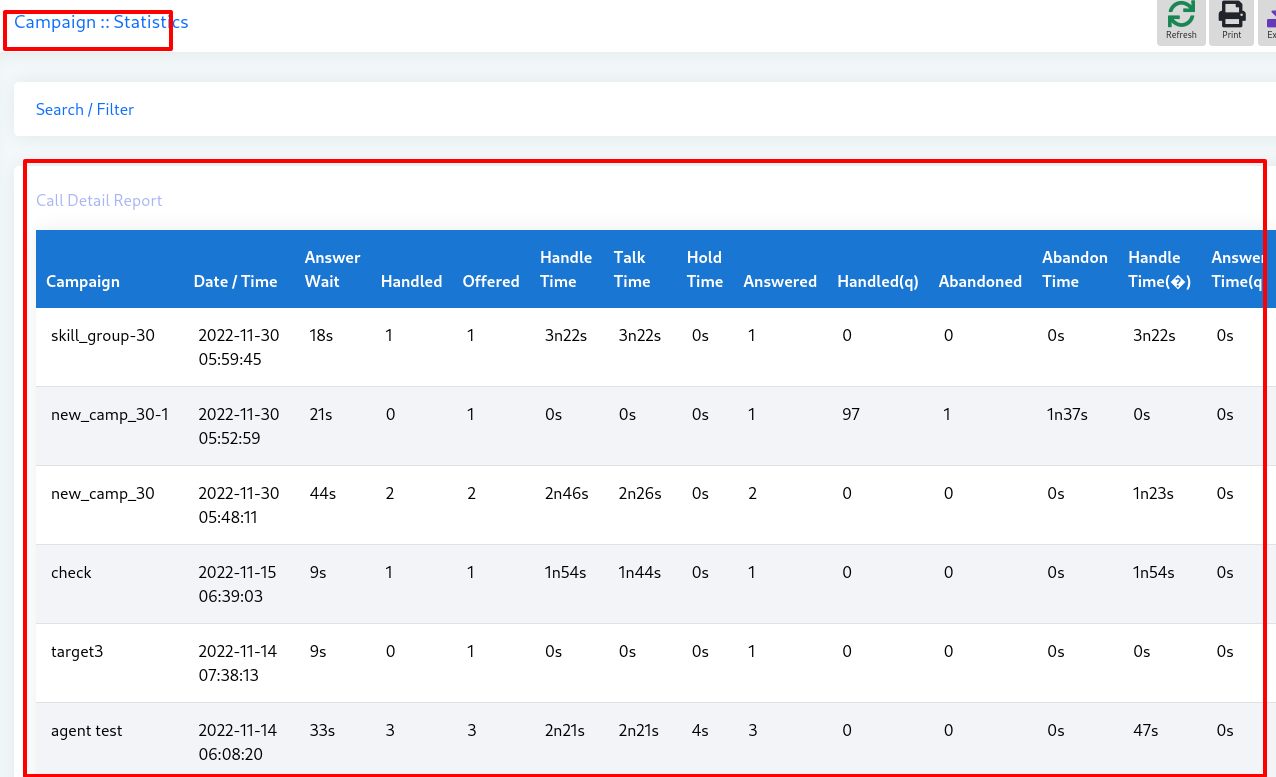
Agent Evaluation
Agent Evaluation report shows the CDR summary associated with each extension. It shows the agent talk, ring time and hold time. Through agent evaluation, we can evaluate the performance of the agents. We can also filter out the desired result of the selected agent at some selected date.
I) Evaluation Form:
An evaluation form is a document used to measure an agent’s workplace performance.
Go to agent evaluation from the main menu, click on evaluation form from the sub menu.
It will show a list of forms as shown in the below figure. You can create a new evaluation form here.
For adding a new form, press the new form button as shown in the above figure.
Fill the Evaluation form with require fields:
Write the title in the field box.
Write the description in the description box.
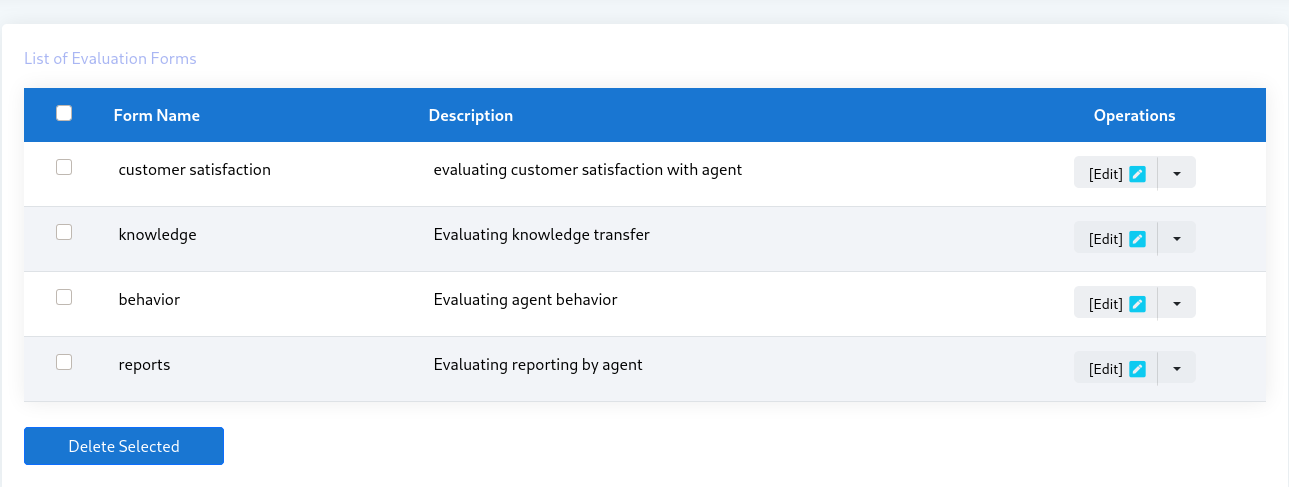
II) Agent Evaluation:
Agent Evaluation report shows the CDR summary associated with each extension. It shows the agent talk, ring and hold time. Through agent evaluation, we can evaluate the performance of the agents. We can also filter out the desired result of the selected agent at some selected date.
Go to agent evaluation from the main menu, click on Agent evaluation from the sub-menu.
It will show an interface as shown in the below figure:
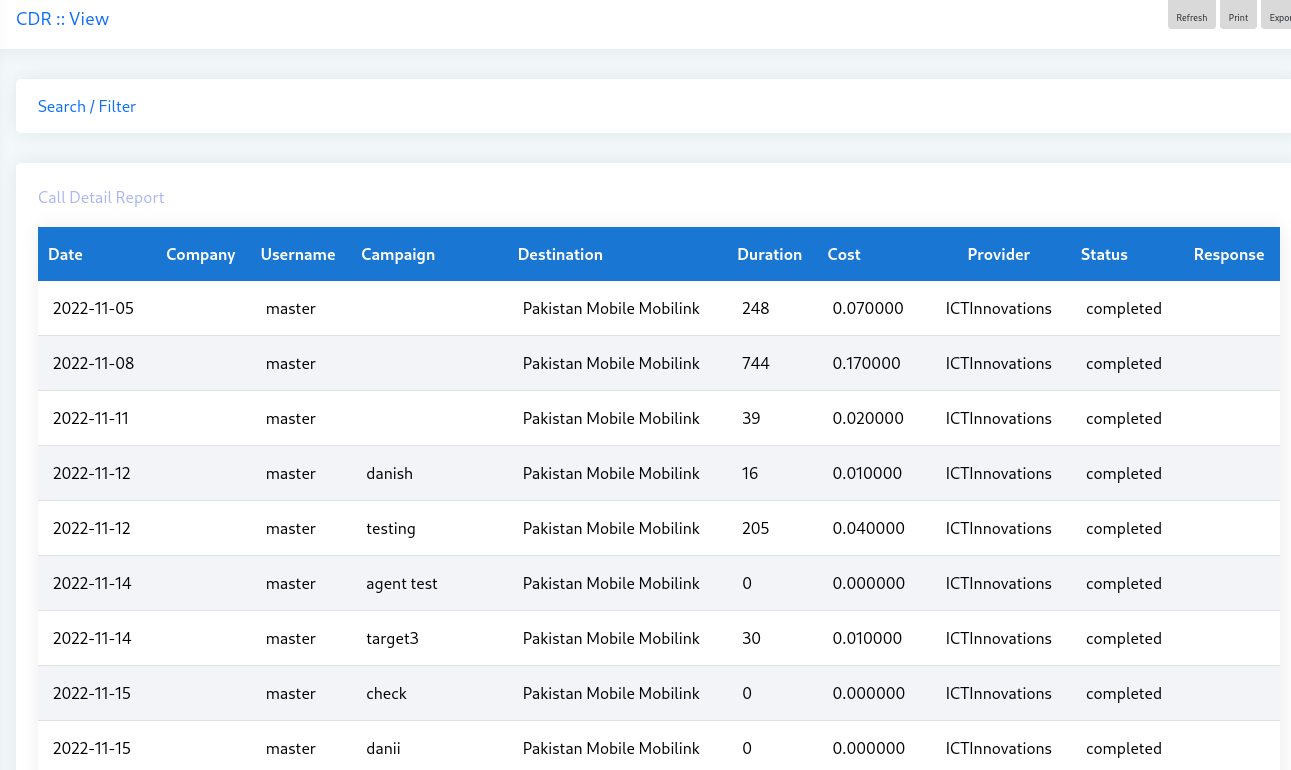
III) Evaluation Report:
Evaluation Report show the list of the agent performance. It shows the call duration and the comments of each call. We can also filter out the result of the desired agent and the desired extension. It also provides the option to export and print the result.
Go to agent evaluation from the main menu, click on evaluation reports from the sub-menu.
It will show an interface as shown in the below figure:
IV) Evaluation Details:
Evaluation Details show the list of the agent performance. It shows the call duration and the comments of each call. We can also filter out the result of the desired agent and the desired extension. It also provides the option to export and print the result.
Go to agent evaluation from the main menu, click on evaluation Details from the sub-menu.
It will show an interface as shown in the below figure:
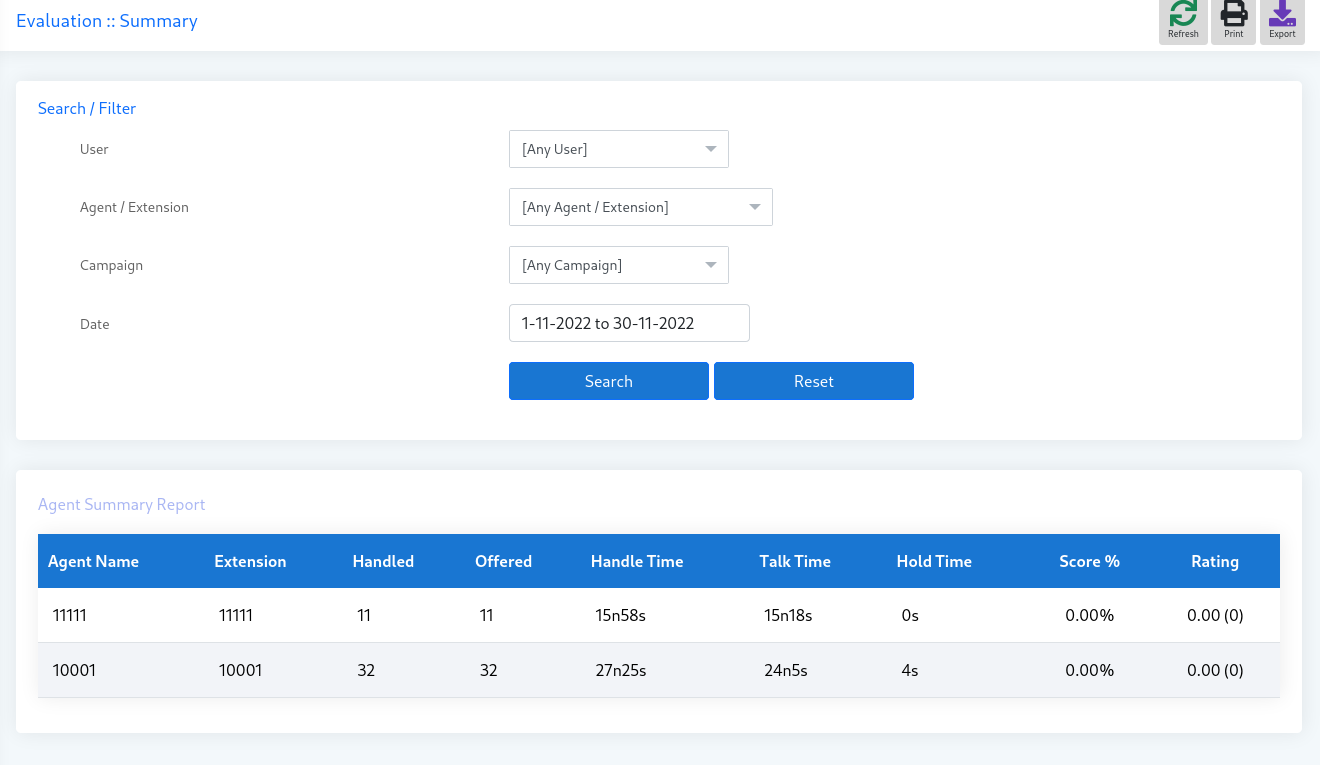
V) Evaluation Summary:
Evaluation Summary presents the summary of the agent’s call. It gives you all the details about the agent’s call. It tells the agent’s name, agent extension, agent’s talk time, hold time and score.
Go to agent evaluation from the main menu, click on evaluation summary from the sub-menu.
It will show an interface as shown in the below figure:

